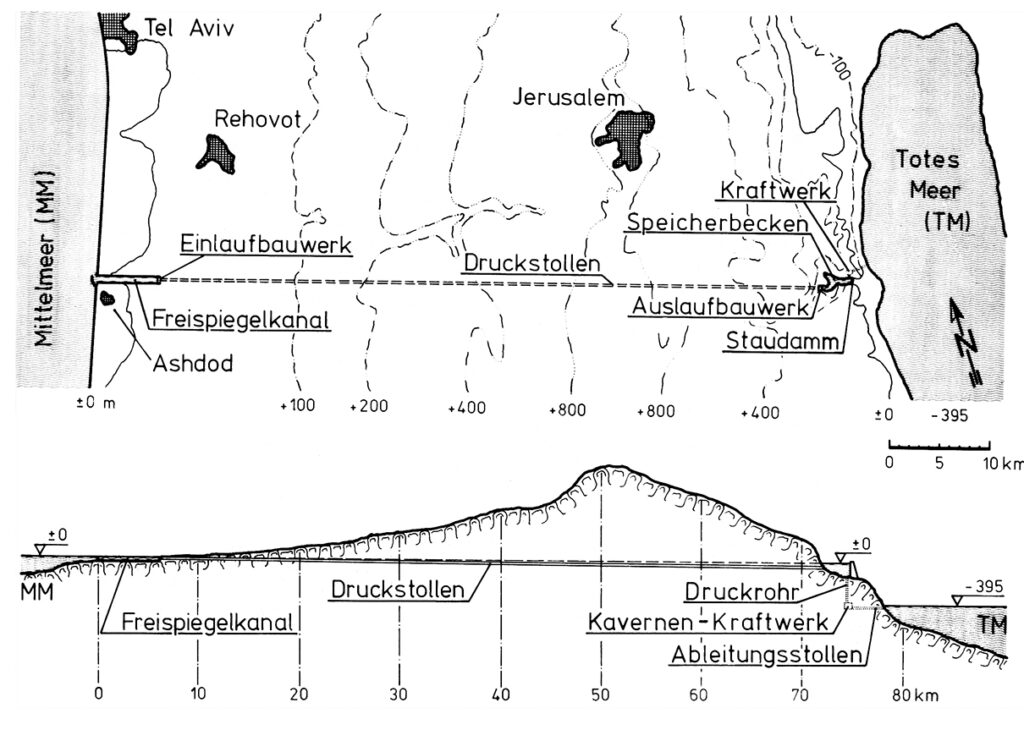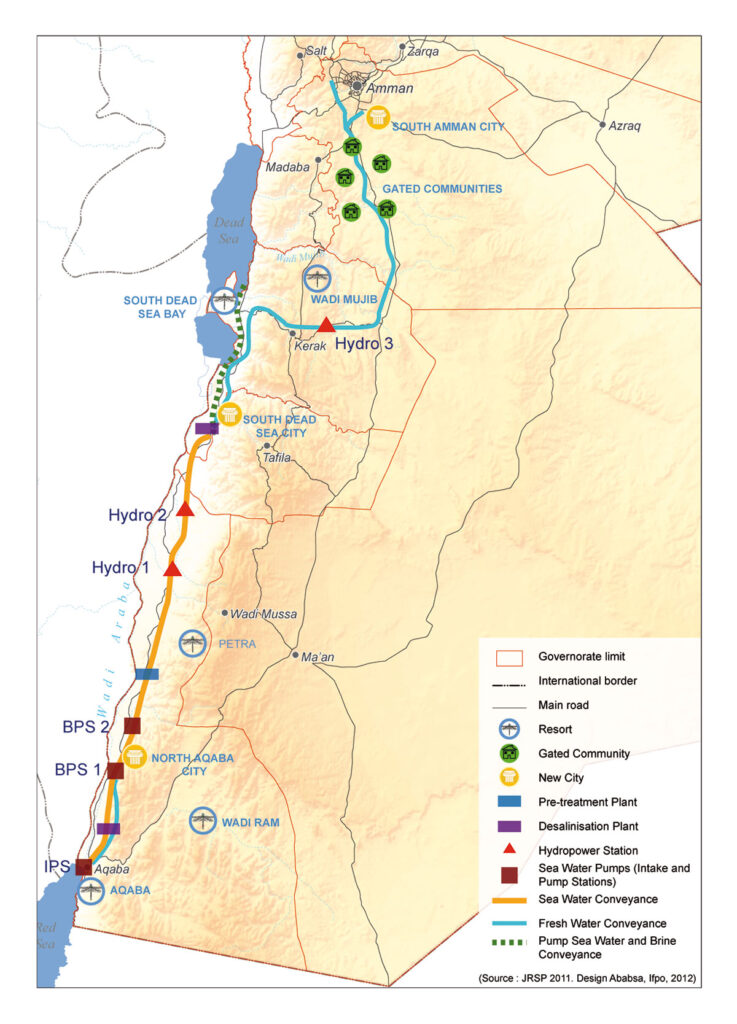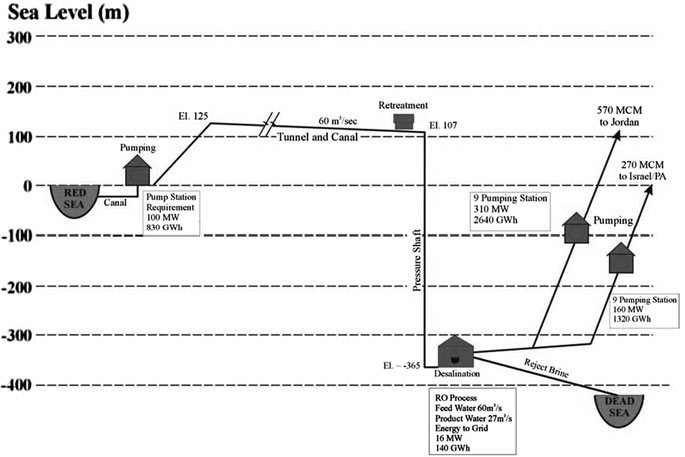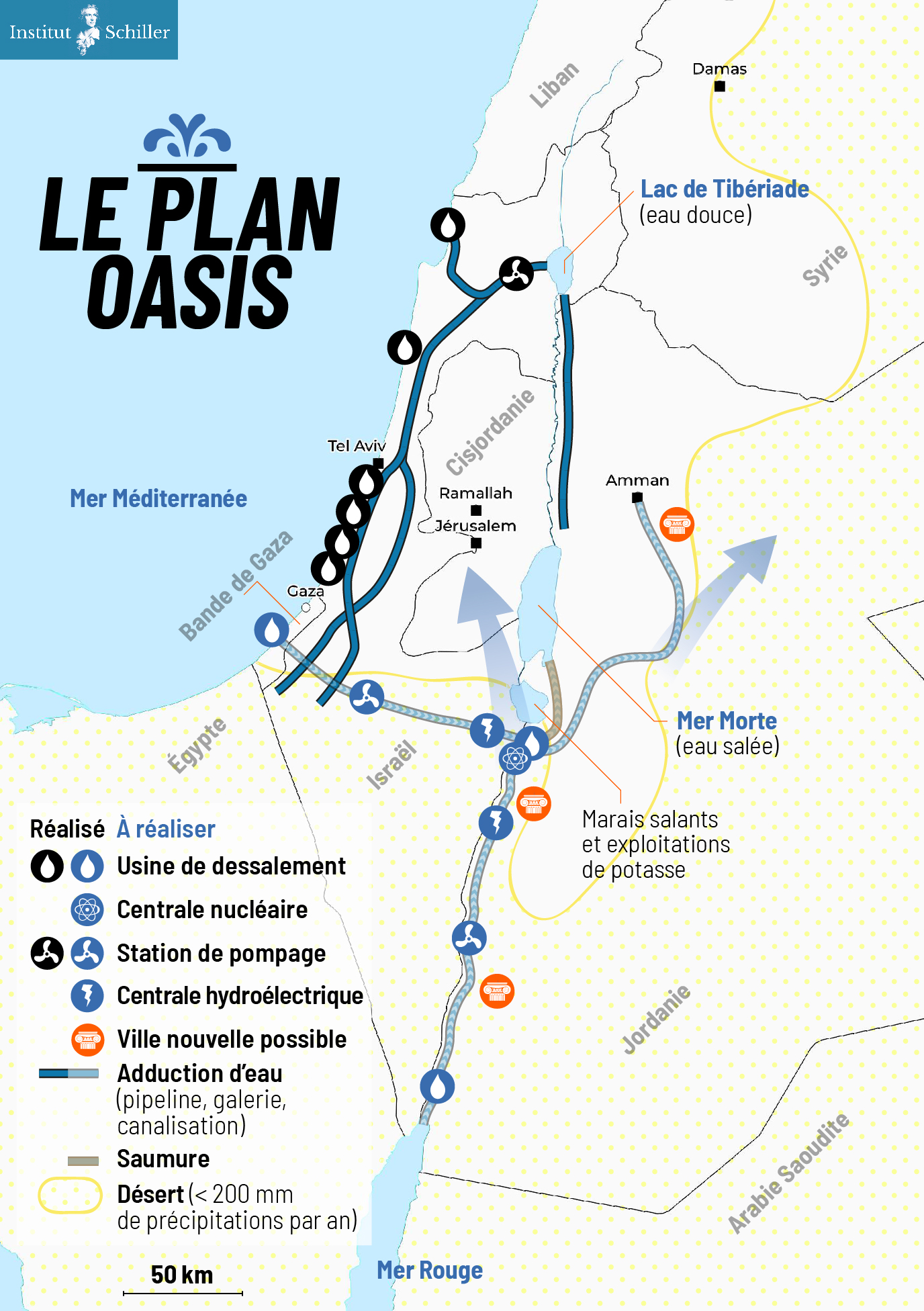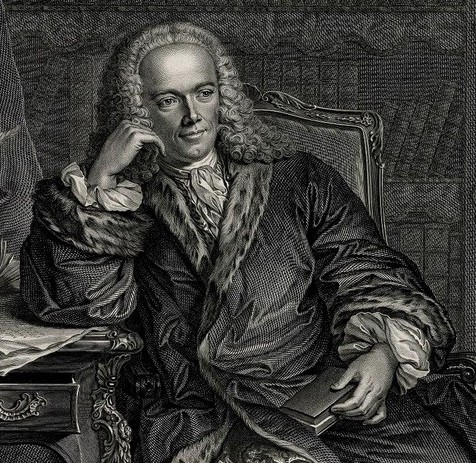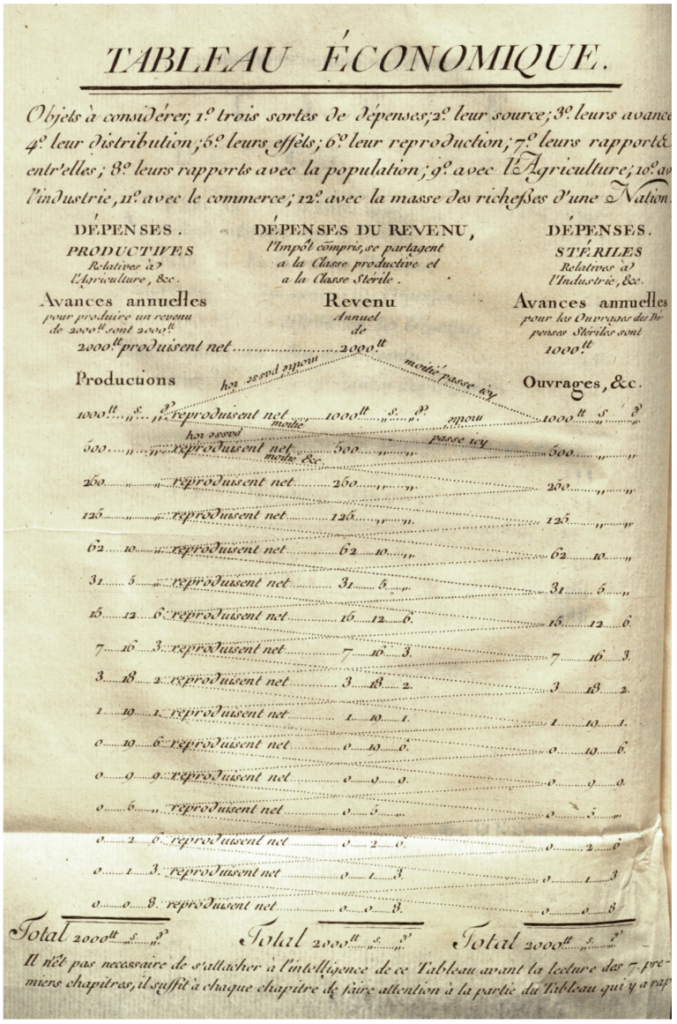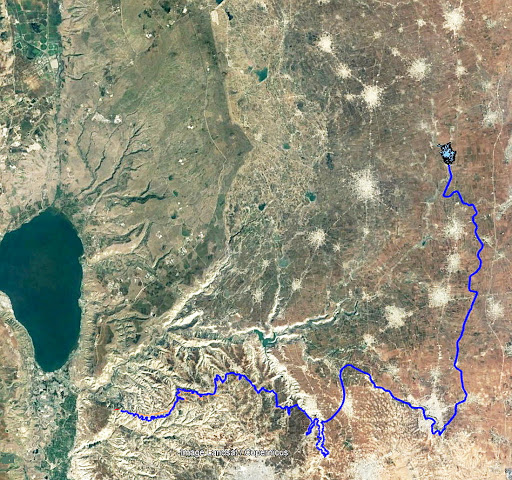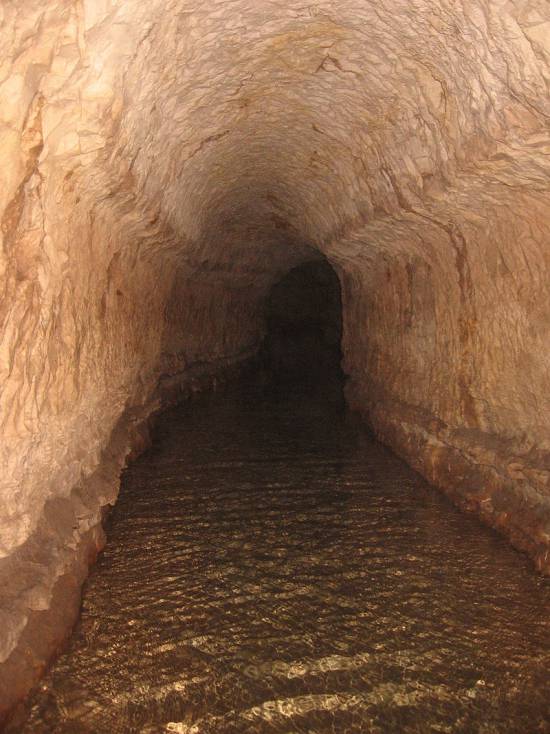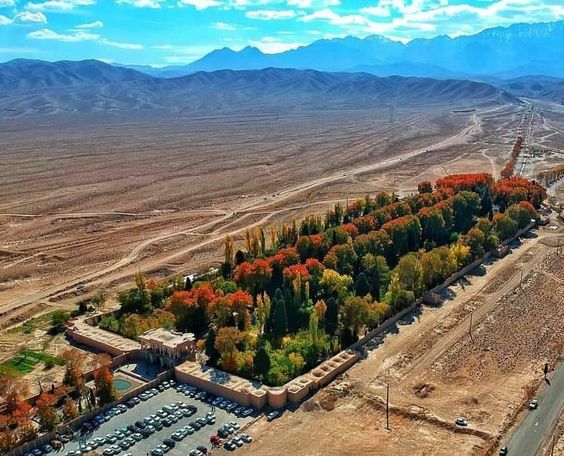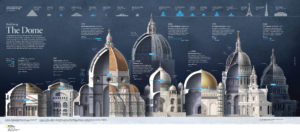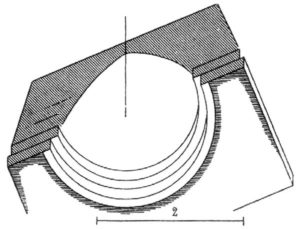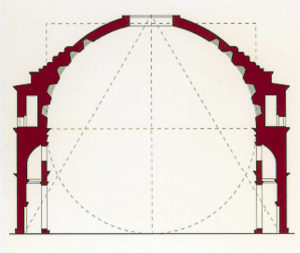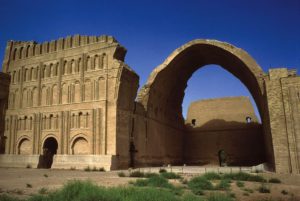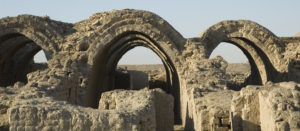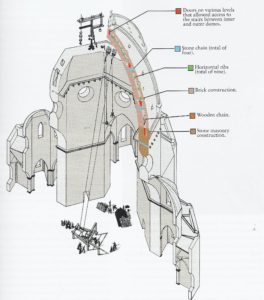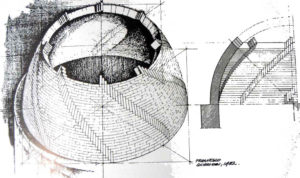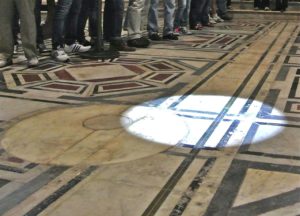Étiquette : LaRouche
Israel-Palestine: Time to Make Water a Weapon for Peace


« If we solve all the problems in the Middle East,
but not the problem of sharing water, our region will explode.
Peace will not be possible »
(Yitzhak Rabin, former Israeli Prime Minister, 1992).
« You only make peace with your enemies. »
(Yitzhak Rabin.)
Contents:
Introduction
1. Geography of the Middle East
2. Rainfall and Water resources
3. Hydrography of the Jordan basin
A. Source
B. Tributaries
C. Lake of Tiberias
D. Yarmouk river
4. Water sources for Israel-Palestine
A. Surface water
B. Groundwater
C. Desalination
D. Reuse of Waste water
5. Water Infrastructure Projects
A. National Water Carrier (NWC)
B. Johnston Plan
C. Ghor Canal
D. Med – Dead Sea aqueduct
E. Red Sea – Dead Sea Water Conveyance
F. Turkish projects
G. Hidden defects and non-application of the Oslo agreements
H. Ben-Gurion Canal
I. Oasis Plan
J. Alvin Weinberg, Yitzhak Rabin and Lyndon LaRouche
Introduction
This article provides readers with the keys. To understand the history of the water wars that continue to ravage the Middle East, it is essential to understand the geological, hydrographical, geographical and political issues at stake. In the second part, we examine the various options for developing water resources as part of a strategy to overcome the crisis. We will deal with the gas issue, another subject of potential conflict or cooperation, in a later article.
1. Geography

The Jordan River basin is shared by four countries: Lebanon, Syria, Jordan and Israel, plus the Palestinian territories of the West Bank and Gaza.
Situated in the hollow of a tectonic depression on the great fault that runs from Aqaba to Turkey, the Jordan Valley is one of the lowest-lying basins in the world, flowing into the Dead Sea at an altitude of 421 meters below sea level.
See interactive topographic map.
Added to this is the fact that this is an endorheic basin, i.e. a river that flows neither into the sea nor the ocean. As in the Aral Sea basin in Central Asia, this means that any water drawn or diverted upstream reduces the level of its ultimate receptacle, the Dead Sea (see below), and can even potentially make it disappear.

While remaining a fundamental artery for the entire region, the Jordan River has a number of drawbacks: its course is not navigable, its flow remains low and its waters, which are highly saline, are polluted.
As one of the key factors in the « Water, Energy, Food nexus » – three factors whose interdependence is such that we can’t deal with one without dealing with the other two – water resource management remains a key issue, and holds a primordial place for any future shared between Israel and its Arab neighbors. To grow food, one needs water. But to desalinate sea water, Israel spends 10 % of its electricity generated by consuming gas and oil.
2. Rainfall and water resources

The Middle East forms a long, arid strip, only accidentally interrupted by areas of abundant rainfall (around 500-700 mm/year), such as the mountains of Lebanon, Palestine and Yemen.
Geographically, much of the Middle East lies south of the isohyet (imaginary line connecting points of equal rainfall) indicating 300 mm/year.
However, precipitation has only a limited effect due to its seasonality (October-February).
As a result, river flow and flooding are irregular throughout the year, as well as between years. The same applies to groundwater recharge.

On a state-by-state basis, total water resources are very unevenly distributed in the region:
—Turkey and Iraq have over 4,000 cubic meters per person per year, and Lebanon around 3000 m³/person/year, which is above the regional average (1,800 m³/person/year).
—Syria and Egypt have around 1200 m³/person/year, one third lower.
On the other hand, some countries are below the critical 500 m³/year/capita bracket:
—Israel and Jordan have 300 m³/year/capita, and the Palestinian Territories (West Bank-Gaza) less than 200 m³/year/capita. They are in what the World Health Organization (WHO) calls a situation of « water stress ».
The Middle East enjoys plenty of water on a regional scale, but has many areas in chronic shortage, on a local scale.
3. Hydrography of the Jordan basin
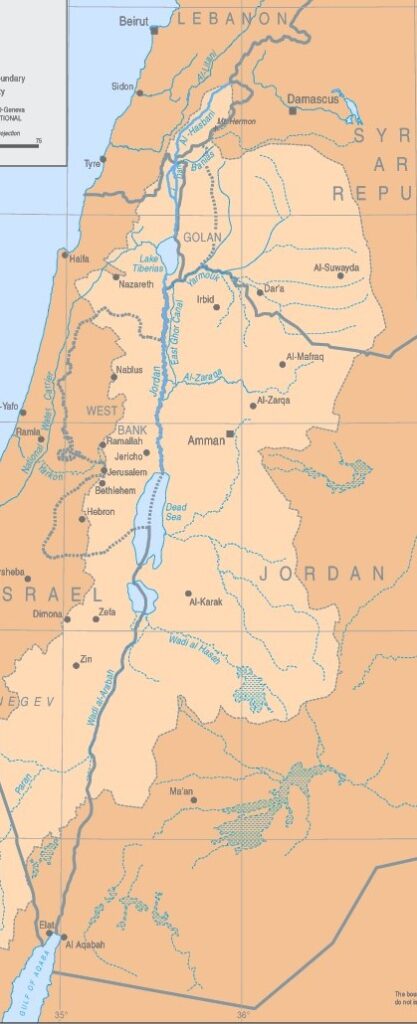
A. Source
360 km long, the Jordan River rises from water flowing down the slopes of Jabal el-Sheikh (Mount Hermon) in southern Lebanon on the border with Syria.
B. Tributaries
Once over the Israeli border, three tributaries join the Jordan about 6 kilometers upstream from the former Lake Hula (now reclaimed):
1. The Hasbani, with a flow of 140 million cubic meters (MCM) per year, rises in Lebanon, a country it crosses over 21 kilometers. The upper reaches of the Hasbani vary greatly with the seasons, while the lower reaches are more regular.
2. The Banias, currently under Israeli control and 30 kilometers long, has an annual flow close to that of the Hasbani (140 MCM). It rises in Syria in the Golan Heights, and flows into Israel for around 12 kilometers before emptying into the Upper Jordan.
3. The Nahr Leddan (or Dan) forms in Israel when the waters of the Golan Heights come together. Although restricted, its course remains stable and its annual flow is greater than that of the other two tributaries of the Upper Jordan, exceeding 250 MCM per year.
C. Lake Tiberias or Kinneret (aka Sea of Galilee)
The Jordan then flows through 17 km of narrow gorges to reach Lake Tiberias, where the salinity is high, especially as the freshwater streams flowing into it have been diverted. Lake Tiberias, however, receives water from the many small streams running through the Golan Heights.
D. Yarmouk River
Next, the Jordan meets the Yarmouk River (bringing in water from Syria), then meanders for 320 km (109 km as the crow flies) to reach the Dead Sea. These 320 km are occupied by a humid plain (the humid zor), with subtropical vegetation, dominated on both sides (West Bank and Jordanian) by dry, gullied terraces.
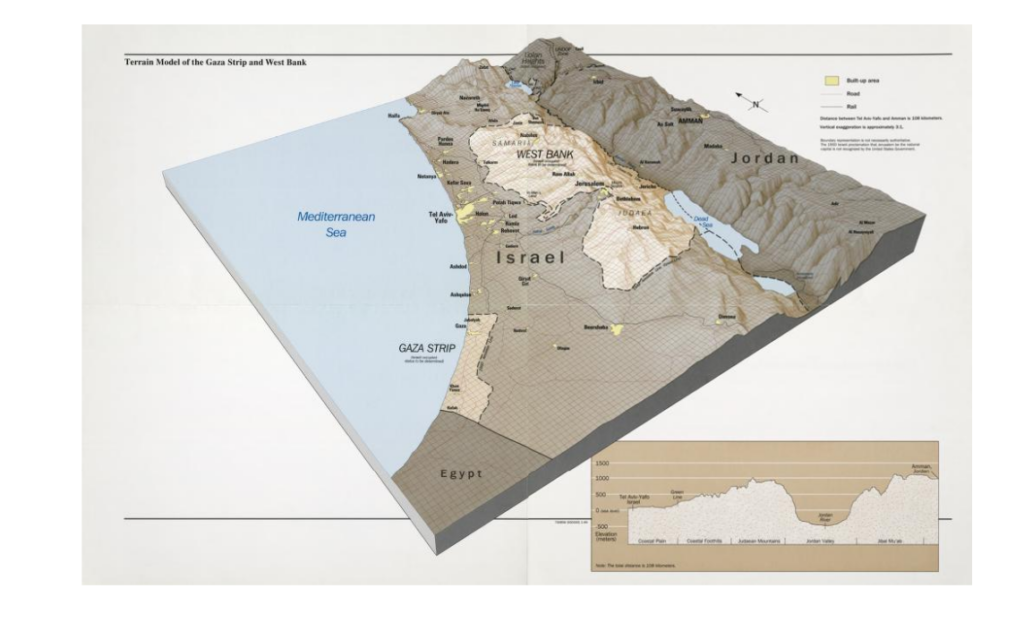
4. Water sources for Israel
The Hebrew state has four main sources of water supply:
A. Surface Water
Israel benefits first and foremost from the freshwater reserves of Lake Tiberias in Galilee, in the north of the country. Crossed by the Jordan River, this small inland sea accounts for 25% of Israel’s water needs. The annexation of the Golan Heights and the occupation of southern Lebanon have made this source of water a sanctuary.
B. Groundwater
In addition to surface water (lakes and rivers), the country can rely on its coastal aquifers, from Haifa to Ashkelon.
Located between Israel and the occupied West Bank, the main aquifer, the Yarkon-Taninim mountain aquifer, has a capacity of 350 MCM per year. In the northeast and east of the West Bank are two other aquifers with capacities of 140 and 120 MCM per year respectively.
C. Seawater desalination


Five desalination plants built along the country’s coastline — in Ashkelon (2005), Palmachin (2007), Hadera (2010), Sorek (2013) and Ashdod (2015) — currently operate and two more are under construction. Collectively, these plants are projected to account for 85-90 per cent of Israel’s annual water consumption, marking a remarkable turnaround.
The Sorek desalination plant, located about 15 km south of Tel Aviv, became operational in October 2013 with a seawater treatment capacity of 624,000m³/day, which makes it world’s biggest seawater desalination plant. The desalination facility uses seawater reverse osmosis (SWRO) process providing water to Israel’s National Water Carrier system (NWC, see below). A dozen more units of this type are considered for construction.
Israel, which has been facing severe droughts since 2013, even began pumping desalinated seawater from the Mediterranean into Lake Tiberias, a unique performance worldwide. While Israel faced water scarcity two decades ago, it now exports water to its neighbors (not too much to Palestine). Israel currently supplies Jordan with 100 MCM and fulfills 20 % of Jordan’s water needs.

From 100 liters of seawater, 52 liters of drinking water and 48 liters of brine (brackish water) can be obtained. Although highly efficient and useful, desalination technology has still to be perfected, as it currently discharges brine into the sea, disrupting the marine ecosystem. To reduce this pollution and transform it into solid waste, we need to increase treatment and therefore energy consumption.
D. Wastewater
The country prides itself on reusing between 80% and 90% of its wastewater for agriculture. Treated wastewater used for irrigation is known as effluent. Israel’s effluent utilization rate is one of the highest in the world. Reclamation is carried out by 87 large wastewater treatment plants (WWTPs) that supply over 660 MCM per year. This represents around 50% of total water demand for agriculture and around 25% of the country’s total water demand. Israel aims to more than double the amount of effluent produced for the agricultural sector by 2050.
5. Water infrastructure projects

For Israel, acquiring water resources in a desert region, through technology, military conquest and/or diplomacy, was from the outset an imperative to meet the needs of a rapidly growing population and, in the eyes of the rest of the world, a demonstration of its sovereign power and its superiority.
This symbolism is particularly evident in the figure of the father of the Hebrew state, David Ben-Gurion (1886-1973), whose aim was to make the Negev desert in the south of the country « blossom ».
In his book Southwards (1956), Ben Gourion described his ambition:
« It is absolutely vital for the State of Israel, both for economic and security reasons, to go south: we must direct the water and rain to there, send the young pioneers there […] as well as the bulk of our budget resources to development. »
A. National Water Carrier of Israel (NWC)
OBJECTIVE: provide fresh water for Israel’s agriculture and growing population.
From 1959 to 1964, the Israelis built the National Water Carrier of Israel (NWC), the largest water project in Israel to date.
The first ideas appeared in Theodor Herzl‘s book Altneuland (1902), in which he spoke of using the springs of the Jordan for irrigation purposes and channeling seawater to generate electricity from the Mediterranean Sea near Haifa through the Beit She’an and Jordan valleys to a canal running parallel to the Jordan and Dead Sea.
In 1919, Chaïm Waizmann, leader of the World Zionist Organization, declared: « The whole economic future of Palestine depends on its water supply ».
However, he advocated incorporating the Litani Valley (in today’s southern Lebanon) into the Palestinian state.

The NWC project was conceived as early as 1937, although detailed planning began after the recognition of Israel in 1948. In practice, the natural flow of the Jordan River is prevented by the construction of a dam, built south of Lake Tiberias. From there, water is diverted to the NWC, a 130 km-long system combining giant pipes, open channels, tunnels, reservoirs and large-scale pumping stations. The aim is to transfer water from Lake Tiberias to the densely populated center and the arid south, including the Negev desert.
When it was inaugurated in 1964, 80% of its water was allocated to agriculture and 20% to drinking water. By 1990, the NWC supplied half of Israel’s drinking water. With the addition of water from seawater desalination plants, it now supplies Tel Aviv, a city of 3.5 million inhabitants, Jerusalem (1 million inhabitants) and (outside wartime) Gaza and the occupied territories of the West Bank.
Since 1948, the area of irrigated farmland has increased from 30,000 to 186,000 hectares. Thanks to micro-irrigation (drip irrigation, including subsurface irrigation), Israeli agricultural production increased by 26% between 1999 and 2009, although the number of farmers fell from 23,500 to 17,000.
The Water War
In launching its NWC, Israel went it alone, while for the rest of the world, it was clear that diverting the waters of the Jordan River would give rise to sharp tensions with neighboring countries, particularly with Jordan and Syria, not to mention the Palestinians who have been largely excluded from the project’s economic benefits.
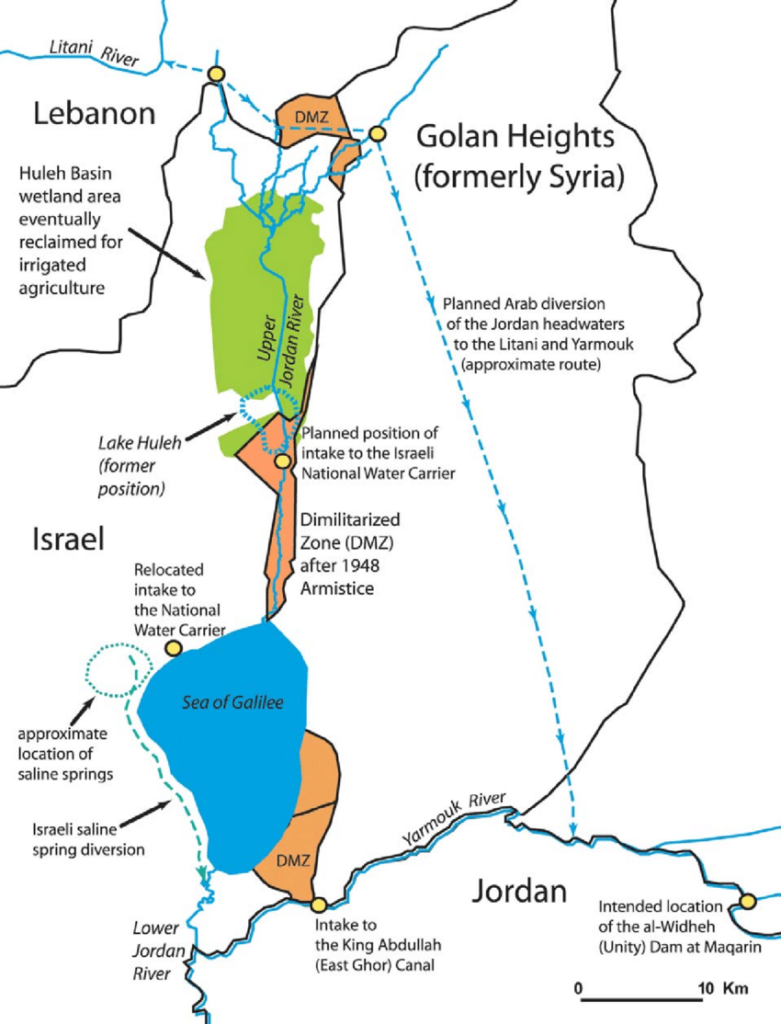
As early as 1953, Israel began the unilateral draining of Lake Hula (or Huleh), north of Lake Tiberias, leading to skirmishes with Syria.
In 1959, Israel kickstarted the NWC. The project was initially interrupted by a halt in American funding, as the Americans did not want to see violence escalate in the context of the Cold War.
It should be noted that, following the Suez crisis of 1956, the Soviet Union established itself in Syria as the protecting power of Arab countries against the « Israeli threat ». As part of the deployment of its naval presence in the Mediterranean, it obtained facilities for its fleet at Latakia in Syria.
However, Israel managed to quietly resume and continue the work on the NWC. Filling the system by pumping of Lake Tiberias began in June 1964 in utmost secrecy. When the Arab countries learned of this, their anger was great. In November 1964, the Syrian army fired on Israeli patrols around the NWC pumping station, provoking Israeli counter-attacks. In January 1965, the NWC was the target of the first attack by the Fatah (organization fighting for the liberation of Palestine) led by Yasser Arafat.
The Arab states finally recognized that they would never be able to stop the project through direct military action.
They therefore adopted a plan, the Headwater Diversion Plan immediately implemented in 1965, to divert water upstream from the tributaries of the Jordan River into the Yarmouk River (in Syria). The project was technically complicated and costly, but if successful would have diverted 35% of the water Israel intended to withdraw from the upper Jordan…
Israel declared that it considered this deviation of the water as an infringement of its sovereign rights. Relations degenerated completely and border clashes followed, with Syrian forces firing on Israeli army farmers and patrols. In July 1966, the Israeli air force bombed a concentration of earth-moving equipment and shot down a Syrian MiG-21. The Arab states abandoned their counter plan, but the conflict continued along the Israel-Syria border, including an Israeli air attack on Syrian territory in April 1967.


For many analysts, this was a prelude to the Six-Day War in 1967, when Israel occupied the Golan Heights to protect its water supply. The Six-Day War profoundly altered the geopolitical situation in the basin, with Israel now occupying not only the Gaza Strip and Sinai, but also the West Bank and the Golan Heights.
As French researcher Hervé Amiot explains:
« Israel went from being a downstream country to an upstream one, enabling it to gain control of vast resources. Israel now controlled 20% of the northern bank of the Yarmouk and occupied the Golan Heights, controlling all the small rivers flowing into Lake Tiberias. What’s more, total occupation of the West Bank gives them control over the important water tables ».
In fact, as early as 1955, between a quarter and a third of the water came from the groundwater in the south-western part of the West Bank. Today, the West Bank aquifers supply Israel with 475 million m³ of water, i.e. 25-30% of the country’s water consumption (and 50% of its drinking water).
Two months after the seizure of the occupied territories, Israel issued “Military Decree 92”, transferring authority over all water resources in the occupied territories to the Israeli army and conferring « absolute power to control all water-related matters to the Water Resources Officer, appointed by the Israeli courts ». This decree revoked all drilling licenses issued by the Jordanian government and designated the Jordan region a military zone, thus depriving Palestinians of all access to water while granting Israel total control over water resources, including those used to support its settlement projects.
Today, returning the Golan to Syria and recognizing the sovereignty of the Palestinian Authority over the West Bank seems impossible for Israel, given the Hebrew state’s increasing dependence on the water resources of these occupied territories. The exploitation of these resources will therefore continue, despite Article 55 of the Regulations of the IVth Hague Convention, which stipulates that an occupying power does not become the owner of water resources and cannot exploit them for the needs of its civilians…
B. Johnston Plan
OBJECTIVE: In the context of the Cold War, counter Nasser’s growing influence in the region. Offer regional stability by building dams and canals allowing a just sharing of water resources and providing water and energy for both Israel and Arab states welcoming « unfortunate » Palestinian refugees.

One might think that the United States tried very early on to prevent the situation from degenerating in such a predictable way. They tried to take into account Israel’s legitimate interest in securing access to water, the absolute key to its survival and development, while at the same time offering neighboring countries (Jordan, Syria and Lebanon) sufficient resources to accommodate the millions of Palestinians exiled from their homes following the Nakba.
Faced with the risk of conflict, as early as 1953 – years before Israel launched its NWC plan – the American government proposed its mediation to resolve disputes over the Jordan basin. The result was the « Jordan Valley Unified Water Plan » (known as the « Johnston Plan »), named after Eric Allen Johnston, president of the United States Chamber of Commerce and US President Dwight Eisenhower‘s water envoy.
More concretely, “The Unified Development of the Water Resources of the Jordan Valley Region,” was prepared at the request of the United Nations Relief and Works Agency for Palestine Refugees under the direction of the Tennessee Valley Authority.
On Oct. 13, 1953, Eisenhower’s Secretary of State John Foster Dulles, in a top secret letter instructed Johnston what his mission was all about and on Oct. 16, in a public statement Eisenhower explained:
« One of the major causes of disquiet in the Near East is the fact that some hundreds of thousands of Arab refugees are living without adequate means of support in the Arab states. The material wants of these people have been cared for through the United Nations Relief and Works Agency (UNRWA) … It has been evident from the start, however, that every effort must be made by the countries concerned, with the help of the international community, to find a means of giving these unfortunate people an opportunity to regain personal self-sufficiency.
« One of the major purposes of Mr. Johnston’s mission will be to undertake discussions with certain of the Arab states and Israel, looking to the mutual development of the water resources of the Jordan River Valley on a regional basis for the benefit of all the people of the area. …
« Such a regional approach holds a promise of extensive economic improvement in the countries concerned through the development of much needed irrigation and hydroelectric power and through the creation of an economic base on the land for a substantial proportion of the Arab refugees. It is my conviction that acceptance of a comprehensive plan for the development of the Jordan Valley would contribute greatly to stability in the Near East and to general economic progress of the region.«
This plan established the transboundary nature of the Jordan basin and proposed an equitable sharing of the resource, giving 52% of the water to Jordan, 31% to Israel, 10% to Syria and 3% to Lebanon.

The plan, just as the Tennessee Valley Authority during FDR’s New Deal, was essentially based on building dams for irrigation and hydropower. The water was there and correctly managed, sufficient for the needs of the population at that time. Its main features were:
- a dam on the Hasbani River to provide power and irrigate the Galilee area;
- dams on the Dan and Banias Rivers to irrigate Galilee;
- drainage of the Huleh swamps;
- a dam at Maqarin on the Yarmouk River for water storage (capacity of 175 million m³) and power generation;
- a small dam at Addassiyah on the Yarmouk to divert its water toward both the Lake Tiberias and south along the eastern Ghor;
- a small dam at the outlet of Lake Tiberias to increase its storage capacity;
- gravity-flow canals along the east and west sides of the Jordan valley to irrigate the area between the Yarmouk’s confluence with the Jordan and the Dead Sea;
- control works and canals to utilize perennial flows from the wadis that the canals cross.
See details of the Johnston plan in this comprehensive article.
The project was validated by the technical committees of Israel and the Arab League, and did not require Israel to abandon its ambition to green the Negev desert. Unfortunately, however, the presentation of the plan to the Knesset in July 1955 did not result in a vote.
The Arab Committee approved the plan in September 1955 and forwarded it to the Council of the Arab League for final approval. Tragically, this institution also chose not to ratify it on October 11, because of its opposition to an act implying an implicit act of recognition of Israel that would prevent the return of the Palestinian refugees to their home… The mistake here was to isolate the water issue from a broader agreement on peace and justice as the foundation of mutual development.
Then, after the Suez Canal crisis in 1956, the Arab countries, with the exception of Jordan, hardened their stance towards Israel considerably, and henceforth opposed the Johnston plan head-on, arguing that it would amplify the threat posed by that country by enabling it to strengthen its economy. They also claim that increasing Israel’s water resources could only increase Jewish migration to the Hebrew state, thereby reducing the possibility of the return of Palestinian refugees from the 1948 war…
History cannot be rewritten, but the adoption of the Johnston Plan could well have prevented conflicts, such as that of 1967, which cost the lives of 15,000 Egyptians, 6,000 Jordanians, 2,500 Syrians and at least 1,000 Israelis.
C. Jordan’s response: the Ghor irrigation Canal
OBJECTIVE: construct the Jordanian section of the Johnston Plan to have water for irrigation and the capital of Jordan.

At almost the same time as Israel was completing its NWC, Jordan was digging the East Ghor irrigation canal between 1955 and 1964, starting at the confluence of the Yarmouk and Jordan rivers and running parallel to the latter all the way to the Dead Sea on Jordanian territory.
Originally, this was part of a larger project – the « Greater Yarmouk » project – which included two storage dams on the Yarmouk and a future “Western Ghor Canal” on the west bank of the Jordan. The latter was never built, as Israel took the West Bank from Jordan in the 1967 Six-Day War.
In effect, by diverting the waters of the Yarmouk to fill up its own canal, Jordan secured water for its capital Amman and its agriculture, but of course, contributed reducing the waters of the Jordan River.
In Jordan, the Jordan’s river watershed is a region of vital importance to the country. It is home to 83% of the population, the main industries and 80% of irrigated agriculture. It is also home to 80% of the country’s total water resources.
Overall, the Hashemite kingdom is one of the world’s most water-poor countries, with 92% of its territory desert. While Israel has 276 m³ of natural freshwater available per capita per year, Jordan has just 179 m³, more than half of which comes from groundwater.
The UN considers that a country with less than 500 m³ of freshwater per capita per year suffers from « absolute water stress ». Added to this is the fact that since the start of the Syrian civil war, Jordan has welcomed nearly 1.4 million refugees onto its soil, in addition to its 10 million inhabitants.
The East Ghor Canal was designed in 1957 and built between 1959 and 1961 competing with Israel’s NWC. In 1966, the upstream section as far as Wadi Zarqa was completed. The canal was then 70 km long and was extended three times between 1969 and 1987.
The United States, through the U.S. Agency for International Development (USAID), financed the initial phase of the project, after obtaining explicit assurances from the Jordanian government that Jordan would not withdraw more water from the Yarmouk than had been allocated to it under the Johnston Plan. They were also involved in the subsequent phases.
Waterworks in the region are often named after great political figures. The East Ghor Canal was named « King Abdallah Canal (KAC) » by Abdalla II after his great-grandfather, the founder of Jordan. At the time of the peace treaty with Israel in 1994, the two countries shared the flow of the Jordan, and Jordan agreed to sell its water from Lake Tiberias.
D. Mediterranean – Dead Sea Aqueduct
OBJECTIVE: generate hydro-electricity and make Israel independant from Arab oil and gas supplies.

A: Crossing solely Israelian territory;
B and C: Crossing Israel and West Bank (shortest, 70 km);
D. Crossing Gaza and Israel;
E. Crossing only Jordan (longest, 200 km).
The idea of a Dead Sea-Mediterranean Canal was first proposed by William Allen in 1855 in a book entitled The Dead Sea – A new route to India. At the time, it was not known that the level of the Dead Sea was far below that of the Mediterranean, and Allen proposed the canal as an alternative to the Suez navigation Canal.
Later, several engineers and politicians took up the idea, including Theodor Herzl in his 1902 short story Altneuland. Most early projects were based on the left bank of the Jordan, but a modified form, using the right bank (West bank), was proposed after 1967.
After extensive research, German engineers Herbert Wendt and Wieland Kelm proposed not a navigable canal, but an aqueduct consisting essentially of an overhead gallery running West-East, linking the Mediterranean to the Dead Sea.
Their 1975 detailed project study Depressionskraftwerk am Toten Meer – Eine Projektstudie, on how to use the difference of water levels between the Mediterranean sea (level 0) and the Dead Sea (- 400 m) for power generation was the subject of a first publication in the German journal Wasserwirtschaft (1975,3).

The diagram indicates the system operates as follows:
- The seawater intake is at Ashdod.
- An open channel allows the water to flow by gravity for 7 km.
- From there, the pressurized water travels through a 65 km-long hydraulic gallery;
- The water arrives in a 3km-long reservoir created by a dam on the edge of the steep descent to the Dead Sea. At that point, the water can be used to cool a thermal or nuclear power plant, the heat from which can be used for industrial or agricultural purposes.
- Through a shaft running from the bottom of the reservoir, the water descends a steep 400 metres.
- There, it powers three turbines, each producing 100 MWe.
- Finally, via an evacuation gallery, the seawater reaches the Dead Sea.
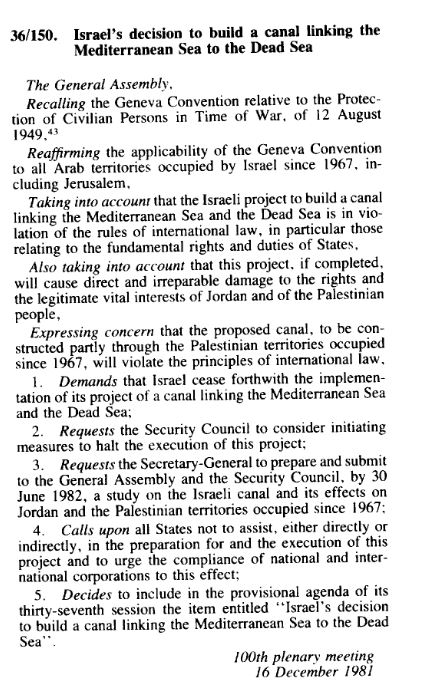
However, since the project was elaborated exclusively by Israel and without any consultation with its Jordanian, Egyptian and Palestinian neighbors, the project ran against a wall of political opposition.
Of course, as with any large scale infrastructure projects, many things needed to be adapted, including tourist equipment, roads, hotels, Jordanian potash exploitation, Palestinian farmland, etc.
Questions were also raised about (very infrequent) potential earthquakes and the difference of salinity of water from the Mediterranean and the Dead Sea.
On Dec. 16, 1981, the UN General Assembly, arguing the canal project « will violate the principle of international law » adopted Resolution 36-150.
That resolution requested the UN Security Council « to consider initiating measures to halt the execution of this project » and calling « upon all States not to assist, either directly or indirectly, in the preparation for and the execution of this project. »
The request, in article 3, to submit a study was fulfilled. The report, not really convincing, details various objections but doesn’t call into question the technical feasability of the project.
E. Red Sea – Dead Sea Water Conveyance
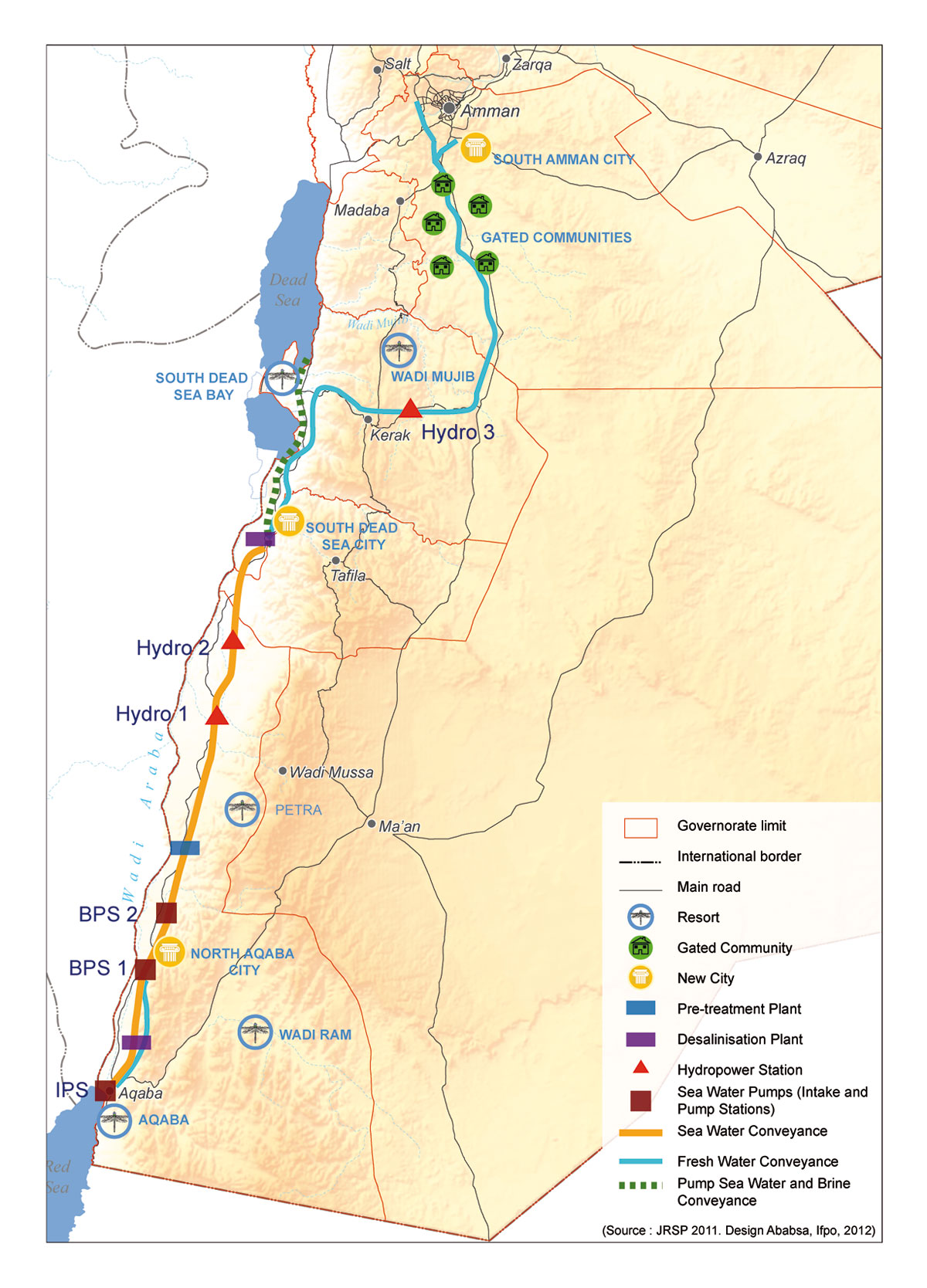
OBJECTIVES: Build a desalination plant close to the Dead Sea to provide fresh water to Jordan, Israel and Palestine by desalinating seawater arriving via a pipeline from the Red Sea. Use the brine to refill the Dead Sea. Use the watersharing as a model for peaceful mutual beneficial cooperation. Make the project the heart of a development corridor.
In the framework of the peace treaty between Israel and the Hashemite Kingdom of Jordan the integrated development Master Plan for the Jordan Rift Valley (JRV) was studied in the mid 1990’s.
The Red Sea – Dead Sea Canal (RSDSC) was considered to be one of the most important potential elements for implementing this Master Plan. The principal development objective of the RSDSC was to provide desalinated drinking water for the people of the area.
On October 17, 1994, then Israeli Prime Minister Yitzhak Rabin and King Hussein of Jordan validated the draft peace treaty between their two countries in Amman, after reaching agreement on the last two points in dispute – the water issue and border demarcation.

On November 26, the Israeli-Jordanian peace treaty was signed with great fanfare in the Arava Valley, between the Red Sea and the Dead Sea, by the prime ministers of the two countries, in the presence of US President Bill Clinton, whose country had helped bring the negotiations between Jerusalem and Amman to a successful conclusion.
This created the condition where the old idea of linking the Red Sea with the Dead Sea, a project renamed and supported by Shimon Peres as the « Peace Canal », could come back on the table.
Former Israeli water commissioner Professor Dan Zaslavsky, who opposed the project on cost grounds, wrote in the Jerusalem Post in 2006 about Peres’ obstinacy. To listen to the scientists, Peres summoned five of them. Each had to present his objections in a few minutes.
« At one point, Peres got up and said, ‘Excuse me. Don’t you remember that I built the nuclear reactor in Dimona? Do you remember that everyone was against it? Well I was right in the end. And this will prove to be the same thing! » And with that, Zaslavsky said with a flourish, « he left! »
The Dead Sea
For millennia, the Dead Sea was filled with fresh water from the Jordan River, via Lake Tiberias. Over the last fifty years, however, it has lost 28% of its depth and a third of its surface area. Its water level is falling inexorably, at an average rate of 1.45 meters per year. Its high salinity – over 27%, compared with the average for oceans and seas of 2-4% – and a level 430 meters below sea level, has always fascinated visitors and provided therapeutic benefits. Stretching 51 kilometers long and 18 kilometers wide, it is shared by Israel, Jordan and the West Bank.
The over-exploitation of upstream water resources (the National Aqueduct in Israel, the Ghor Canal in Jordan), together with potassium mining, is the cause of the sand desert which, if nothing is done, will continue to replace the Dead Sea.
If the Dead Sea needs the Jordan River, the Jordan River needs Lake Tiberias, from which it takes its source. However, the lake too has been affected by drastic drops in its water level in recent years, triggering a vicious circle between the three systems (Lake Tiberias, Jordan River and Dead Sea).
Aqueduct
In response, at the end of 2006, the World Bank and Agence Française de Développement (AFD) assisted Israel and Jordan in the design of a colossal project to link the Dead Sea to the Red Sea via a 180-kilometer mainly underground pipeline.
In the end, the project for an aqueduct starting from the Red Sea and built entirely on Jordanian territory was chosen, with the signing of a tripartite agreement between Israelis, Jordanians and Palestinians in December 2013.
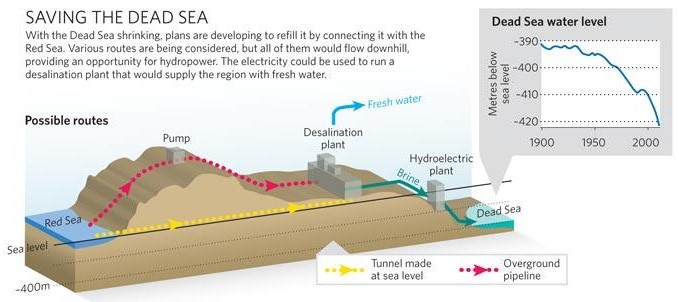
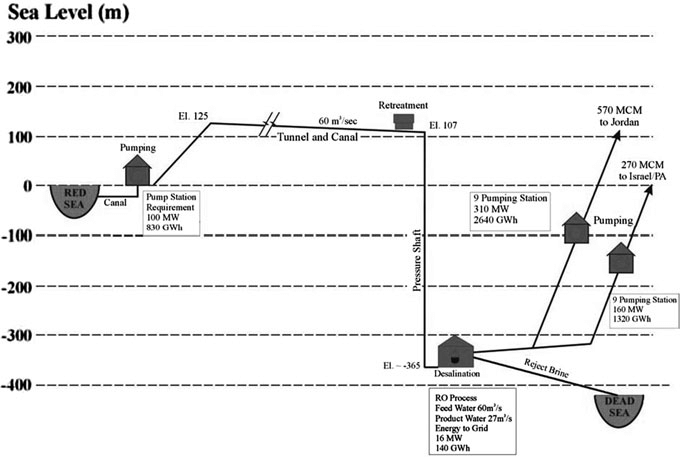

- Sea intake and pumping station
The seawater is pumped to +125 m above sea level at the Red Sea. - Pressure pipeline
The first part of the conveyance system transmits the seawater to the planned elevation. The length is 5 km from Aqaba (3% of the whole alignment). - A tunnel and canal conveyance system
Seawater is transmitted to the regulating and pretreatment reservoirs with a design flow of 60 m3 /s. A 121 km tunnel with 7 m diameter and 39 km canal were designed. - Regulating and pre-treatment reservoirs
Several reservoirs were designed at +107 m at Wadi G’mal at the southeastern margin of the Dead Sea. - Desalination plants
The 2 desalination plants are designed to operate by using the process of hydrostatically supported reverse osmosis to provide desalinated seawater. The main plant will be located at Safi at 365 m below the sea level with a water column of 475 m. - Fresh water
The project will produce around 850 MMC of fresh water per year, to be shared between Jordan, Israel and Palestine, the three countries that manage the Dead Sea. For the transmission of the water to Amman a double pipeline of 200 km with 2.75 m diameter was designed with nine pumping stations for the uplift of 1,500 m. For the transmission to Hebron a double pipeline of 125 km with an elevation difference of 1,415 m was designed. - The brine
The brine reject water will be conveyed from the desalination plant via a 7 km canal to the Dead Sea. 1,100 MMC per year of brine reject water will enter the Dead Sea. - Electricity generation
As the brine runs through the tunnel and canal, the turbines of one or more hydroelectric power plants will generate around 800 megawatts of electricity to partially offset the electricity consumed by pumping; - Three new cities will be built: North Aqaba city in northern Aqaba, South Dead Sea City, close to the desalination plant south of the Dead Sea, and South Amman City (see map at the beginning of this section).
In terms of environmental impact, scientists have expressed concern that mixing the brine (rich in sulfate) from the desalination plants with the Dead Sea water (rich in calcium) could cause the latter to turn white. It would therefore be necessary to proceed with a gradual water transfer to observe the effects of water transfer in this particular ecosystem.
Not enough to stabilize the level of the Dead Sea, but a first step to start slowing down its drying up, emphasized Frédéric Maurel, in charge of this project for AFD, in 2018. « We also need to use water more sparingly, both in agriculture and in the potash industry, » he stressed.
Political will?

In 2015, as a supplement to the program, agreements had been reached on reciprocal water sales: Jordan would supply drinking water to Israel in the south, which in return would increase its sales of water from Lake Tiberias to supply northern Jordan. And the Palestinians would also receive additional water supplies from Israel. By the end of 2016, five consortia of companies had been shortlisted.
In 2017, the European Investment Bank produced a 264 page detailed study to support the plan.
On the Israeli side, saving the Dead Sea is a necessity to maintain seaside tourism and thermalism. It is also a lever to guarantee its hydraulic control over the West Bank, as Israel does not trust the Palestinian Authority to manage water. Honest elements of the Hebrew state are aware of the peacemaking potential of this project, and need a stable partner in the region. Jordan, for its part, was by far the most interested in this project, given its critical situation.
In 2021, Jordan decided to put an end to the joint water pipeline project, believing that there was « no real desire on the part of the Israelis » for the plan, which had stagnated for several years, to go ahead.
To face its growing needs, Jordan has decided to build its own desalination plant directly on the Red Sea. The Aqaba-Amman Water Desalination and Conveyance Project will take water from the Red Sea at the Gulf of Aqaba in the south, desalinate it, and channel it 450 kilometres north to the capital Amman and its surrounding area, supplying a desperately needed 300 million cubic metres of water a year. Studies are complete and construction will start on July 2024. The plant will be powered with solar energy.
In 2022, Jordan, the UAE and Israel signed a memorandum of understanding (MoU) to continue feasibility studies for two interconnected projects: establishing the water desalination station at the Red Sea (Prosperity Blue) and establishing a solar power plant in Jordan (Prosperity Green). However, due to the ongoing war against Gaza and the rejection of the Jordanian public regarding the agreement’s signing, the Jordan government announced the suspension of the agreement.
The Dead Sea might slowly reappear

With huge desalinization capacities in hand, Israel adopted in 2023 the National Carrier Flow Reversal Project to return water to its natural resources, in particular to Lake Tiberias, the very source of freshwater for its entire national water system.
Lake Tiberias, as we have seen, is therefore a national treasure, a centerpiece of tourism, agriculture and, as we have seen, geopolitics.
According to Dodi Belser, Director of Innovation at water state giant Mekorot, if Israel wants to increase the water it sends to its Jordanian neighbors and to protect its reservoir, it’s vital to retain the lake’s water level. Currently Israel taps 100 million cubic meters of water from Lake Tiberias to send to Jordan, and did so even during the drought years of 2013 to 2018.
Increase resilience to climate chaos and preparing eventual futur water sharing, gave birth to the idea to pump desalinated water into the Lake Tiberias, up to 120 million cubic meters a year until 2026. That is happening right now.
It can partly increase the level of the Jordan river and therefore the water arriving into the Dead Sea. But the salt in the Dead Sea comes from the waters of the Jordan River. Every year, the famous river brings it some 850,000 tonnes of salt.
F. Turkish water sales

Turkye, a veritable « water tower » in the region, has long dreamed of exporting its water to Israel, Palestine, Cyprus and other Middle Eastern countries at a premium.
The most ambitious of these projects was President Turgut Ozal‘s « Peace Water Pipeline » in 1986, a $21 billion project to pipe water from the Seyhan and Ceyhan rivers to cities in Syria, Jordan and the Arab states of the Gulf.
In 2000, Israel was strongly considering purchasing 50 million m3 per year for 20 years from the Manavgat river near Antalya, but since November 2006, the deal has been put on hold.

The Manavgat project, technically completed in mid-March 2000, was a pilot project.
The complex on the Manavgat river – which rises in the Taurus mountains and flows into the Mediterranean between Antalya and Alanya – includes a pumping station, a refining center and a ten-kilometer-long canal. The aim was then to transport this fresh water by 250,000-ton tankers to the Israeli port of Ashkelon for injection into the Israeli NWC.
Eventually, Jordan was also interested in Turkey’s aquatic manna. A second customer downstream of its network would enable Israel to share costs. Another possibility would be to transport the water via a water pipeline linking Turkey to Syria and Jordan, and ultimately to Israel and Palestine if the latter could reach an agreement with its partners. The Palestinians, for their part, have been looking for a donor country to subsidize freshwater imports by tanker to Gaza.
The Manavgat project is not the only one through which Ankara hopes to sell its water. In 1992, Suleyman Demirel, then Prime Minister, expressed a credo that went viral: « Turkey can use the waters of the Tigris and Euphrates rivers as it sees fit: Turkey’s water resources belong to Turkey, just as oil belongs to Arab countries.”
The countries downstream of the two rivers – Iraq and above all Syria – immediately protested. For them, the multiple dams that Ankara plans to build on the region’s main freshwater sources for irrigation or power generation are simply a way for the heir to the Ottoman Empire to assert its authority over the region.
Whatever Ankara’s real ambitions, the country has a real treasure trove at its disposal, especially given the dwindling resources of neighboring countries.
In the end, since November 2006, Israeli supporters of desalination have objected to the price of Turkish water and questioned the wisdom of relying on Ankara, whose government is critical of Israeli policies. Desalination or importation? The choice is a Cornelian one for Israel. And an eminently political one, since it comes down to knowing whether to stick to positions based on self-sufficiency or whether to play the regional cooperation card, which amounts to betting on trust…
G. Hidden defects and non-implementation of Oslo
The recognition of Israel by Yasser Arafat – leader of the Palestinian Liberation Organisation –, and the election of Yitzhak Rabin as Israel’s Prime minister in 1992 opened new opportunities for peace and cooperation. The Oslo accords they signed established the Palestinian Authority and determined temporary groundwater allocations from the West Bank to Israel and Palestine. In the declaration, both parties agreed on the principle of “equitable utilisation” between Palestinians and Israelis.
The collapse of mutual trust following the assassination of Rabin in November 1995 and the subsequent election of Benjamin Netanyahu, who had been highly critical of Oslo, negatively affected cooperation on water.
In 2000, during the first six months of the second Intifada, there was hardly any contact between both sides regarding water issues. But with reason coming back, despite the conflict, Israeli and Palestinian leaders committed themselves to separating the water issue from violence and reactivated cooperation over water.
In 2004, Israel reportedly proposed a plan to build a desalination plant in order to increase the quantity of freshwater available and to channel desalinated water to the West Bank. Fearing that this might in effect imply a renunciation to Palestinian water claims on the Mountain aquifer (75% of which is allocated to Israel even though the Aquifer is on Palestinian land), the Palestinians rejected this solution.
The Oslo Accords, signed by Israel and the Palestine Liberation Organization (PLO) in 1993, although stipulating that « Israel recognizes the water rights of Palestine », in reality allowed Israel to continue controlling the region’s water sources… while awaiting a resolution to the conflict. Oslo II provided for the postponement of negotiations on water rights until those on permanent status, as well as on the status of Jerusalem, refugees’ right of return, illegal settlements, security arrangements and other issues.
But final status talks, scheduled to take place five years after the implementation of the Oslo Accords (in 1999, as planned), have not yet taken place.
The Oslo Accords also provided for the creation of a water management authority, and their « Declaration of Principles » stressed the need to ensure « the equitable use of common water resources, for application during the interim period [of the Oslo Accords] and thereafter ».
Hence, for decades, Israel has perpetuated a principle of water distribution that existed before the Oslo Accords were signed, allowing Israelis to consume water at will while limiting Palestinians to a predetermined 15% share.

The Oslo agreements did not take into account the division of the West Bank into zones A, B and C when it came to organizing water distribution between Israel and the Palestinians.
Israel was finally granted the right to control water sources, even in PA-controlled areas A and B.
Most water sources were already located in Area C, which is entirely controlled by Israel and comprises almost 61% of the West Bank.
On the ground, Israel has connected all the settlements built in the West Bank, with the exception of the Jordan Valley, to the Israeli water network. The water supply to Israeli communities on both sides of the Green Line is managed as a single system, under the responsibility of Israel’s national water company, Mekorot.
While the Oslo Accords allowed Israel to pump water from areas under its control to supply settlements in the occupied West Bank, they also prevent the PA from transferring water from one area to another in those it administers in the West Bank. Israel has disavowed most of the provisions of the Oslo Accords, but remains committed to those relating to water.
A member of the Palestinian delegation that signed the Oslo Accords, wishing to remain anonymous, tells Middle East Eye magazine that the delegation’s lack of expertise at the time resulted in the signing of an agreement that
« placed the fate of Palestinian access to water in Israel’s hands (…) Most Palestinian water experts withdrew from the negotiations at the outset of the Oslo process, as they were not satisfied with the way the negotiations were being conducted », he stressed. « As for the political leaders, their main objective was to reach an agreement. »

In practice, this means that Palestinians in the occupied West Bank are at the mercy of the Israeli occupation when it comes to their water supply.
Inequalities in terms of access to water in the West Bank are glaring, as shown by the Israeli NGO B’Tselem in a report entitled Parched, published in May 2023.

In 2020, each Palestinian in the West Bank consumed an average of 82.4 liters of water per day, compared with 247 liters per person in Israel and the settlements.
This figure drops to 26 liters per day for Palestinian communities in the West Bank that are not connected to the water distribution network. 36% of West Bank Palestinians have year-round access to running water, compared with 100% of Israelis, including settlers.
The Palestinian Authority, which claims more water, points out that Palestinian agriculture plays a major role in the economy of the Occupied Territories (15% of GDP, 14% of the working population in 2000). In comparison, Israeli agriculture, while far more productive, employs 2.5% of the working population and produces 3% of GDP.

Added to this the fact that the arable land recognized by Israel under the Oslo Accords as totally or partially autonomous to the Palestinians is located in the limestone uplands, where access to water is difficult, since it is necessary to dig deep to reach the water table.
What’s more, in Israel and the settlements, 47% of land is irrigated, compared with only 6% of Palestinian land. The Palestinian Authority is currently demanding rights to 80% of the mountain aquifer, which Israel cannot conceive of.
Myth of Thirsty Palestinian
Israeli spokespeople, such as Akiva Bigman in his article titled « The Myth of the Thirsty Palestinian » have three answers ready to pull out when they are confronted with the water shortages in West Bank Palestinian towns:
1) “Because the PA does not properly maintain its water system, it suffers from a 33 percent rate of water loss, mostly due to leakage; in contrast to an 11 percent loss from the Israeli system.”
Answer: leakage varies from 20 to 50% in the USA, far above the rate of poor Palestine.
2) “40 potential drilling sites in the Hebron area were identified and approved by the Israeli-Palestinian Joint Water Committee; but in the two decades since then, drilling has taken place in only three places, and this is in spite of substantial funding provided to the PA by donor nations.”
One can ask where the money went. And yes, in reality, at the end of the day, for various technical reasons and unexpected drilling failures in the eastern basin of the aquifer (the only place the agreement allows the Palestinians to drill), the Palestinians ended up producing less water than the agreements set.
3) Israel has in its great generosity “doubled the amount of water it supplies to the Palestinians, compared to what was called for in the Oslo Accords.”

True. However, Oslo didn’t set a limit to the amount of water Israel can take, but limited the Palestinians to 118 MCM from the wells that existed prior to the accords, and another 70-80 MCM from new drilling. According to the Israeli NGO B’Tselem, as of 2014 the Palestinians are only getting 14 percent of the aquifer’s water. That is why the Israeli state company Mekorot (obeying to government directives) is selling the Palestinians the double of water stipulated in the Oslo Agreement – 64 MCM, as opposed to 31 MCM. 64 + 31 = 95 MCM in total, to be compated with current consumption by Palestinians in the West Bank: 239 MCM of water in 2020 of which 77.1 of them purchased from Israel.
A final detail that speaks volumes: Palestinians are charged the price of drinking water for their agricultural water while Jewish settlers benefit from agricultural tariffs and subsidies. The justification being that the Jewish settlers have invested in expensive irrigation techniques such as desalination
H. Ben Gurion Navigation Canal

At the end of 2023, the idea of the Ben-Gurion navigation Canal project was revived in the media. The canal would link the Gulf of Aqaba (Eilat) in the Red Sea to the Mediterranean Sea, passing through Israel to terminate in or near the Gaza Strip (Ashkelon). This is an Israeli alternative to the Suez Canal, which became topical in the 1960s following Nasser’s nationalization of Suez.
The first ideas for a connection between the Red Sea and the Mediterranean appeared in the mid-19th century, on the initiative of the British, who wanted to link the three seas: the Red, the Dead and the Mediterranean. As the Dead Sea lies 430.5 meters below sea level, such an idea was not feasible, but it could be realized in another direction. Frightened by Nasser’s nationalization of Suez, the Americans considered the option of the Israeli canal, their loyal ally in the Middle East.
In July 1963, H. D. Maccabee of Lawrence Livermore National Laboratory, under contract to the U.S. Department of Energy, wrote a memorandum exploring the possibility of using 520 underground nuclear explosions to help dig some 250 kilometers of canals across the Negev desert. The document was classified until 1993. « Such a canal would constitute a strategically valuable alternative to the present Suez Canal and would probably contribute greatly to the economic development of the surrounding region, » says the declassified document.
The idea of the Ben Gurion Canal resurfaced at the same time as the signing of the so-called « Abraham Agreements » between Israel and the United Arab Emirates, Bahrain, Morocco and Sudan.
On October 20, 2020, the unthinkable happened: Israel’s state-owned Europe Asia Pipeline Company (EAPC) and the UAE’s MED-RED Land Bridge signed an agreement to use the Eilat-Ashkelon pipeline to transport oil from the Red Sea to the Mediterranean, avoiding de facto the Suez Canal.
On April 2, 2021, Israel announced that work on the Ben Gurion Canal was due to start in June of the same year. But this has not been the case. Some analysts interpret the current Israeli reoccupation of the Gaza Strip as an event that many Israeli politicians were waiting for to revive an old project.

A closer look at the planned route shows that the canal starts at the southern edge of the Gulf of Aqaba, from the port city of Eilat, close to the Israeli-Palestinian border, and continues through the Arabah valley for around 100 km, between the Negev mountains and the Jordanian highlands. It then turns west before the Dead Sea, continues through a valley in the Negev mountain range, then turns north again to bypass the Gaza Strip and reach the Mediterranean Sea in the Ashkelon region.
The project’s promoters argue that their canal would be more efficient than the Suez Canal because, in addition to being able to accommodate a greater number of ships, it would allow the simultaneous two-way navigation of large vessels thanks to the design of two canal arms.
Unlike the Suez Canal, which runs along sandy banks, the Israeli canal would have hard walls that require almost no maintenance. Israel plans to build small towns, hotels, restaurants and cafés along the canal.
Each proposed branch of the canal would be 50 meters deep and around 200 meters wide. It would be 10 meters deeper than the Suez Canal. Ships 300 meters long and 110 meters wide could pass through the canal, corresponding to the size of the world’s largest ships.
If completed, the Ben-Gurion Canal would be almost a third longer than the Suez Canal, which measures 193.3 km, or 292.9 km. Construction of the canal would take 5 years and involve 300,000 engineers and technicians from all over the world. Construction costs are estimated at between $16 and $55 billion. Israel stands to gain $6 billion a year.
Whoever controls the canal, and apparently it can only be Israel and its allies (mainly the USA and Great Britain), will have enormous influence over international supply chains for oil, gas and grain, as well as world trade in general.
Israel argues that such a project would undermine the power of Egypt, a country strongly allied with Russia, China and the BRICS and therefore « a threat » to the West! With the depopulation of Gaza and the prospect of total Israeli control over this tiny territory, some Israeli politicians, including Netanyahu, are once again salivating over the prospect of such a project.
As Croatian analyst Matia Seric pointed out in Asia Review in November 2023:
« If realized, the Ben Gurion Canal would bring about a tectonic change as it would overshadow the Suez Canal. The project would launch Israel into the center of world shipping and world trade. Egypt would lose its monopoly on the shortest route between Africa, Asia and Europe. The emergence of an alternative Israeli channel would have a devastating impact on the Egyptian economy. President el-Sisi may regret putting his trust in Israel and Western governments above the well-being of the two million Palestinians in Gaza. Egypt, apart from formally condemning the mass crimes committed by Israeli forces against the civilian Palestinian population, has done little to prevent Israeli wrongdoing, which some call genocide. Israeli Prime Minister Benjamin Netanyahu has repeatedly expressed support for the idea of the canal along with the idea of building a high-speed railway from Eilat to Beersheba. Realizing, or at least starting, this project could redeem Netanyahu from his many mistakes during his long reign, including the intelligence and military failures that facilitated the October 7 attack by Hamas. »
I. Oasis Plan

It is in the light of all these failures that the fundamental contribution of the « Oasis Plan » proposed by the American economist Lyndon LaRouche (1922-2019) becomes apparent.
In 1975, following talks with the leaders of the Iraqi Baath Party and sane elements of the Israeli Labor Party, the American economist LaRouche saw his Oasis Plan as the basis for mutual development to the benefit of the entire region.
Instead of waiting for « stability » and « lasting peace » to arrive magically, LaRouche proposed and even launched projects in the interests of all, and « recruited » all partners to participate fully, first and foremost in their own interests, but in reality in the interests of all.


LaRouche’s « Blue Peace » Oasis plan, to be put on the table of diplomatic negotiations as the « spine » of a durable peace agreement », includes:
- Israel’s relinquishment of exclusive control over water resources in favor of a fair resource-sharing agreement between all the countries in the region;
- The reconstruction and economic development of the Gaza Strip, including the Yasser Arafat International Airport (inaugurated in 1998 and bulldozered by Israeli in 2002), a major seaport backed up by a hinterland equipped with industrial and agricultural infrastructure.
- A floating, underwater or off-shore desalination plant will be stationed in front of Gaza.
- The construction of a fast rail network reconnecting Palestine (including Gaza) and Israel to its neighbors;
- The construction, for less than 20 billion US dollars of both the Red-Dead and the Med-Dead water conveyance system composed of tunnels, pipelines, water galeries, pumping stations, hydro-power units and nuclear powered desalination plants.
- Salted sea water, arriving at the Dead Sea, before desalination, will « fall » through a 400 meter deep shaft and generate hydro-electricity.
- Following desalination, the fresh water will go to Jordan, Palestine and Israel; the brine will refill and save the Dead Sea.
- The nuclear powered desalination plant will produce heat and electricity with « hybrid desalination » combining evaporation and Reverse Osmosis (RO) ;
- The industrial heat of the Molten Salt (MSR) high temperature reactors (HTR), will also be tapped for industrial and agricultural purposes;
- The reservoirs of the water conveyance systems will also function as a Pumped Storage Power Plant (PSPP), essential for regulating the region’s power grids;
- Part of the seawater going through the Med-Dead Water conveyance system will be desalinated in Beersheba, the « capital of the Negev » whose population, with new fresh water supplies, can be doubled.
- New cities and « development corridors » will grow around the new water conveyance systems.
- Israel’s Dimona nuclear center and power plant (currently a military reactor and medical nuclear waste treatment center) can form the basis to create a civilian nuclear program and contribute to the construction of nuclear desalination plants. Jordan can supply the uranium.
- US and Israeli plans to prepare the housing of 500,000/1 million people in the Negev exist but should be entirely reconfigured in terms of both scope and intent. They cannot be a mere extension of exclusively Jewish settlements, but should offer the opportunity to all Israeli citizens, in peaceful cooperation with the Bedouins who live there, the Palestinians and others, to roll back a common enemy: the desert.
- The policy of illegal settlements in the West Bank shall be halted. Settlers will be encouraged (through taxation, etc.) to relocate to the Negev, where they, in a shared effort with the Bedouins, Palestinians and others, can take up productive jobs and make the desert bloom (62% of Israeli territory).
PS: The Oasis Plan plan aims to bring peace to all through mutual development. It has nothing to do with Netanyahu’s Ben-Gurion canal project, a megalomaniac plan for a navigation canal connecting the Red Sea with the Mediterranean aimed to compete with the Suez Canal.

Alvin Weinberg, Yitzhak Rabin and Lyndon LaRouche
LaRouche proposed coupling hydrological, energy, agricultural and industrial infrastructures. These agro-industrial complexes, built around small high-temperature nuclear reactors, were called « nuplexes », a concept put forward in the post-war period by the American scientist Alvin Weinberg, head of the Oak Ridge Laboratories in Tennessee (ORNL) and co-inventor of several types of nuclear reactor, notably the molten-salt line using thorium as fuel (and therefore without the production of weapons-grade plutonium).
In chapter 8 of his autobiography, Weinberg recounts how ORNL, « embarked on a great enterprise: desalinating the sea with cheap nuclear power », with « multi-purpose » plants, « producing water, electricity and process heat at the same time ». The assertion that this was possible, Weinberg reports, « caused a stir within the Atomic Energy Commission ».

In the end, it was President John F. Kennedy who reacted most enthusiastically, speaking on September 25, 1963:
“We are now examining in the United States today the mixed economic-technical question of whether the very large scale nuclear reactors can produce unexpected savings in the simultaneous desalination of water and the generation of electricity? We will have before this decade is out or sooner a tremendous nuclear reactor which makes electricity and at the same time gets fresh water from salt water at a competitive price. What a difference this can make to the United States. And indeed, not only the US but all around the globe where there are so many deserts on the ocean’s edge.”
The idea reached later the ear of AEC’s patron Lewis Strauss.
“The time was 1967, just after the Six-Day War, and the Middle East was much on our minds. The ultimate problem of the Middle East is water – a point that is now perhaps more fully recognized than it was in 1967. Why not build dual-purpose nuclear and electric desalting plants in Egypt, Israel and Jordan – literally make the deserts bloom– and thereby create a major new possibility for a settlement in the Israeli-Arab conflict?”
Lewis conveyed this idea to Eisenhower and Ike published in Life magazine an outline of what became known as the Eisenhower plan, based “on what Lewis and I had discussed”, writes Weinberg.
ORNL then sent a team to visit Egypt, Israel and Lebanon where they were warmly received. The visit brought to Tennessee Israeli and Egyptian engineers who were integrated in the Middle East Study Project,
“which studied what we called ‘nuclear-powered agro-industrial complexes,’ something already studied in 1966. Such complexes would use nuclear reactors to produce electricity and water; the electricity would be used for both domestic and industrial purposes; the water would be used to grow high-value crops.”
“The Middle East project adapted these earlier results to the Israeli-Egyptian situation. A multi-volume report of the Middle East project was issued in which we examined the feasibility of nuclear agro-industrial complexes to be built as national projects in the El-Hamman area near Alexandria in Egypt, and the western Negev area of Israel, and as an international project near the Gaza strip. The implication was that the complexes would be subsidized by the United States.”
“I met with then-ambassador Yitzhak Rabin of Israel for about an hour at the Knoxville airport to tell him about our results. Rabin, who became prime minister of Israel, was skeptical – both as to the political feasibility of a project conducted jointly by Israelis and Arabs, and the economic feasibility of such a huge undertaking. But most of all he suggested that we had extraordinary chutzpah, sitting in Tennessee and figuring out a scheme to resolve a bitter ethnic dispute some six thousand miles away! Of course Rabin had a point on both scores; but I couldn’t refrain from saying, ‘But Mr. Ambassador, is our drawing up plans in Tennessee for agro-industrial complexes for the Middle East is any sillier than Theodore Herzl’s drawing up plans for Israel, in a Vienna café in 1896?’”
Weinberg, clearly unaware of the Dulles brothers‘ operations sabotaging anything good Ike wanted to accomplish regretted: “The Eisenhower-Baker plan was never implemented: the political will needed to support building large reactors in the strife-riven Middle East was lacking…”
The LaRouche Oasis plan, like any other proposal along the same lines, has so far been blocked by the Israeli, American and British sides, and we know only too well what happened to Yitzhak Rabin, assassinated after signing the Oslo Accords, to Shimon Peres, ousted, and to a demonized Yasser Arafat. In addition, LaRouche has been slandered and called an anti-Semite.
On April 13, 2034, LaRouche’s Oasis Plan and its relevance for today was discussed and debated during an international zoom conference and endorsed by several high level ambassadors and diplomats from Palestine, South Africa, Russia and Guyana.
Similar events are being prepared to continue the discussion and turn this dream into reality.
« Mutual tuition »: historical curiosity or promise of a better future?


By Karel Vereycken, July 2023, PARIS.
1. Introduction
2. Learning and teaching at the same time, a precious joy
3. Precedents:
A. In India
B. In France
4. Gaspard Monge’s brigades
5. Andrew Bell
6. Joseph Lancaster
7. Mutual Tuition, how it works
A. The class room
B. Teachers and monitors
C. A day at a mutual school
D. Progress according to each pupil’s knowledge
E. Tools
F. Command
8. Bellists vs. Lancasterians
9. France adopting Mutual Tuition
10. Lazare Carnot takes the helm
11. Mutual tuition and choral music
12. The rue Saint-Jean-de-Beauvais pilot project
13. Jomard, Choron, Francœur and elementary knowledge
14. Going Nationwide
15. Critique
16. Mechanistic drift?
17. Death of mutual tuition in France
18. Conclusion
19. Short list of books and texts consulted
« Answer, my friends: it must be sweet for you
To have as your only mentors children like yourselves;
Their age, their mood, their pleasures are your own;
And these victors of one day, tomorrow vanquished by others,
Are, in turn, adorned with modest ribbons,
Your equals in your games, your masters on the benches.
Mute, eyes fixed on your happy emulators,
You are not distracted by the fear of ferulas;
Never an avenging whip, frightening your spirits,
Makes you forget what they taught you;
I listen badly to a fool who wants me to fear him,
And I know much better what a friend teaches me. »
Victor Hugo, Discours sur les avantages de l’Enseignement mutuel, 1817.
1. Introduction

Teaching reading and writing to 1,000 children in the same room, without a teacher, without school books, without paper and ink, is clearly impossible. And yet, it has been imagined and put into practice with great success!
Shh! we mustn’t talk about it, because it could give some people ideas, and not just in emerging countries!
That such a challenge could be taken up could only worry the oligarchy and its servants, who since the dawn of time have been mandated to train an « elite » (the high priests of knowledge, « experts » and other know-it-alls) who reproduce in a vacuum at the top, while ensuring that the great mass of people below are educated just enough to be able to deliver parcels, pay their taxes, abide by the rules defined by the top, and above all, not make (too) much of a mess.
And yet, as Hippolyte Carnot, Minister of Public Instruction in the Second Republic, understood long before us, without a republican education – in other words, without genuine citizen training from kindergarten onwards – universal suffrage often becomes a tragic farce capable of producing monsters.
In the early 19th century, « mutual tuition », (sometimes referred to as the English Monitorial System, also known as Madras System or Lancasterian System), spread like wildfire across Europe and then the rest of the world including the United States of America.
If the teacher addresses a single pupil, it’s the individual mode (as in the case of the preceptor); if he addresses an entire class, it’s the simultaneous mode; if he instructs some children to teach others, it’s the mutual mode. The combination of simultaneous and mutual modes is called mixed mode.
Mutual tuition quickly fell victim to personal quarrels and ideological, political and religious issues. In France, it was seen as an aggression by religious congregations who practiced « simultaneous teaching », codified as early as 1684 by Jean-Baptiste de La Salle : classes by age, division by level, fixed and individual places, strict discipline, repetitive and simultaneous work supervised by an inflexible master.
With the formation of small groups where pupils teach each other and move around the classroom, mutual teaching immediately gave rise, rather foolishly, to the fear of an ass-over-head world straight out of a Hieronymus Bosch painting. What kind of world are we in if the pupil teaches the teacher? the child the parent? the faithful the priest? the citizen the government ! Without a clear leader, aren’t we lost ?
In 1824, Pope Leo XII (not to be confused with the benevolent Leo XIII), the « Pope of the Holy Alliance », a fierce supporter of order and suspect of a vast Protestant plot against the Vatican, forbade such teaching, believing it to « weaken the authority » of both teachers and political and religious authorities.
In France, where in the years following the 1830 revolution over 2,000 mutual schools existed, mainly in towns, in competition with denominational schools, François Guizot, Louis-Philippe’s minister and initially a promoter of broad public education, had them closed down.
2. Learning and teaching at the same time,
a precious joy
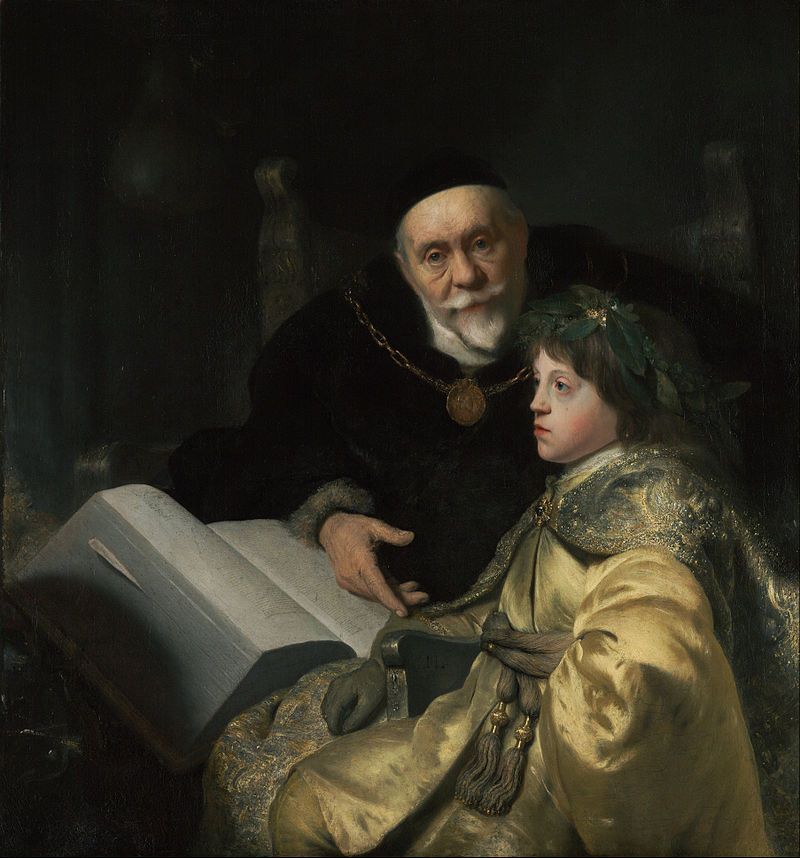
Today, « tutoring » is enjoying a revival in the context of school and vocational training. It is a process of « assistance by more experienced subjects to less experienced subjects, likely to enrich the latter’s acquisitions ».
Tutoring between children, in particular between children of different ages, is encouraged from nursery school right through to university, with the institutionalization of methodological tutoring at undergraduate level. Since the 1980s, elementary and secondary schools in France and abroad have seen the development of numerous tutoring experiments.
In reality, tutoring is no more than the pale heir to the mutual tuition system developed in England and then France in the 19th century.
Hence, the future of humanity depends on an exclusively human faculty: the discovery of new universal physical principles, often totally beyond the limits of our sensory apparatus, enabling Man to increase his capacity to transform the universe to qualitatively improve his lot and that of his environment. A discovery is never the result of the sum or average of opinions, but of an individual, perfectly sovereign act. Are we able to organize our society so that this « sacred » creative principle is cherished, respected and cultivated in any newborn child?
Because, without the socialization of this discovery, it will be useless. The history of mankind is therefore, by its very nature, the history of « mutual tuition ».

Is not the greatest pleasure of those who have just made a discovery – and this is natural for children – to share, with a view to a shared future, not only what he or she has just discovered, but the joy and beauty that every scientific breakthrough represents? And when those who discover teach and those that teach, discover, the pleasure is immense. So let’s give our professional teachers the time they need to make discoveries, for the quality of their teaching will be enhanced!
Precedents:
A. In India
In 1623, the Italian explorer Pietro Della Valle (1586-1652), after a trip to « Industan » (India), in a letter dispatched from Ikkeri (a town in south-west India), reports having seen boys teaching each other how to read and write using singing :
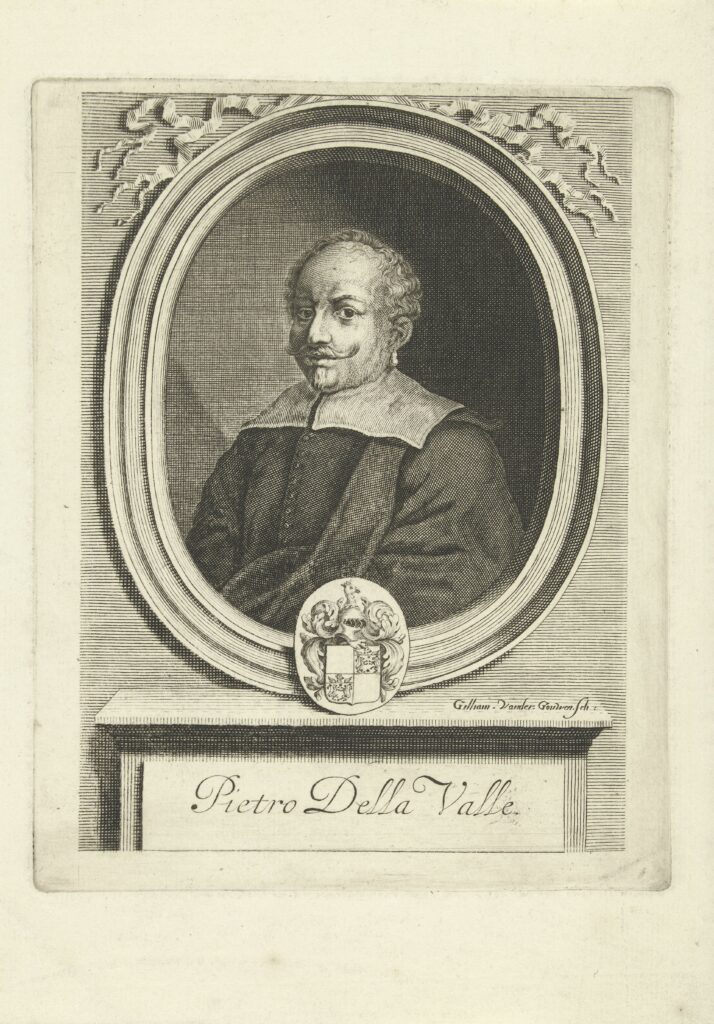
« In order to inculcate it perfectly in their memory, to repeat the previous lessons that had been prescribed to them, lest they forget them, one of them would sing in a certain musical tone a line from the lesson, such as two and two make four. After all, it’s easy to learn a song.
« While he sang this part of the lesson to learn it better, he wrote it down at the same time, not with a pen, nor on paper. But to spare him and not spoil it unnecessarily, they marked the characters with their fingers on the same floor where they were sitting in a circle, which they had covered for this purpose with very loose sand. After the first of these children had written in this way while singing, the others sang and wrote the same thing all together
« (…) When I asked them who (…) corrected them when they missed, given that they were all schoolboys, they answered me very reasonably, that it was impossible that a single difficulty should stop them all, four at the same time, without being able to overcome it and that for the subject they always practiced together so that if one missed, the others would be his teachers.«
In Della Valla‘s report, we can already identify some of the basic principles of mutual tuition, notably the simultaneous learning of reading and writing, the use of sand for writing exercises to avoid wasting paper, which is scarce and very expensive, a group lesson given by a teacher, followed by work in sub-groups in which pupils learn to self-regulate, and finally, an integration of knowledge which, thanks to the use of song, will facilitate memorization.
B. In France

In Lyon, the priest Charles Démia, was one of the precursors of mutual tuition, which he put into practice in the « petites écoles » for poor children he founded and theorized as early as 1688. According to the Nouveau dictionnaire de pédagogie et de l’instruction primaire:
« Démia introduced what later came to be known as mutual tuition into the classroom: he recommended that a certain number of officers be chosen from among the most capable and studious pupils, some of whom, under the name of intendants and decurions, would be responsible for supervision, while the others would have to have the master’s lessons repeated, correct pupils when they made mistakes, guide the hesitant hand of ‘young writers’, etc. » In order to make simultaneous teaching possible, Démia’s idea of ‘mutual teaching’ was based on the principle of ‘teaching to one another’. To make simultaneous teaching possible, the author of the regulations divides the school into eight classes, to be taught in turn by the master; each of these classes can be subdivided into bands ».
In Paris, as early as 1747, mutual education was practiced with great success in a school of over 300 pupils, established by M. Herbault, at the Hospice de la Pitié, in favor of the children of the poor. Unfortunately, the experiment did not survive its founder.
In 1772, the ingenious charity of Chevalier Paulet conceived and carried out the project of applying a similar method to the education of a large number of children, left without support in society by the death of their parents.
4. Gaspard Monge’s « brigades »
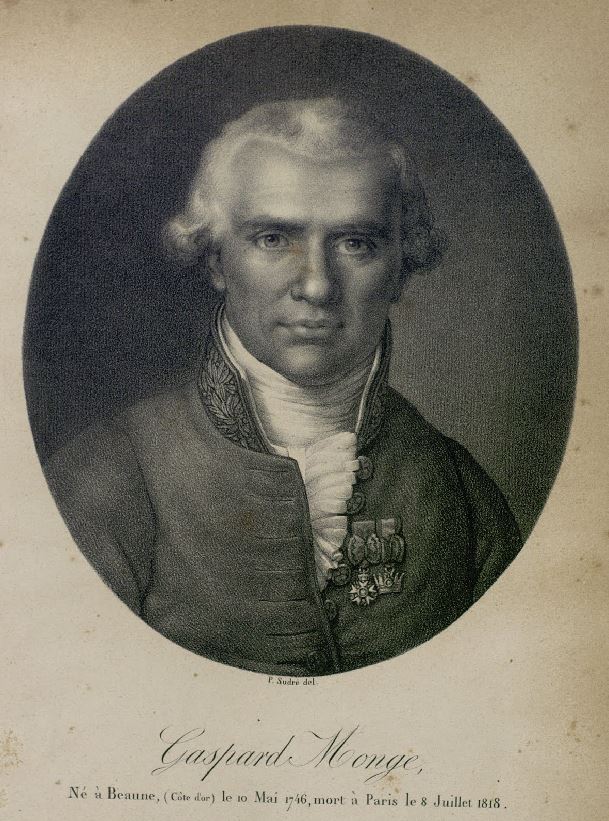
Finally, as recounted in his biography of Gaspard Monge by his most brilliant pupil, the astronomer François Arago (1786-1853), himself a close friend of Alexander von Humboldt, it was at the École Polytechnique that Monge perfected his own system of mutual tuition and tutoring.
Finding it unacceptable to have to wait three years for the first engineers to graduate from the Ecole Polytechnique, Monge decided to speed up student training by organizing « revolutionary courses », an accelerated training program lasting three months for those in charge of teaching to the others. To achieve this, he perfected the concept of « chefs de brigades », a technique he had already successfully tested at the Mézières engineering school.
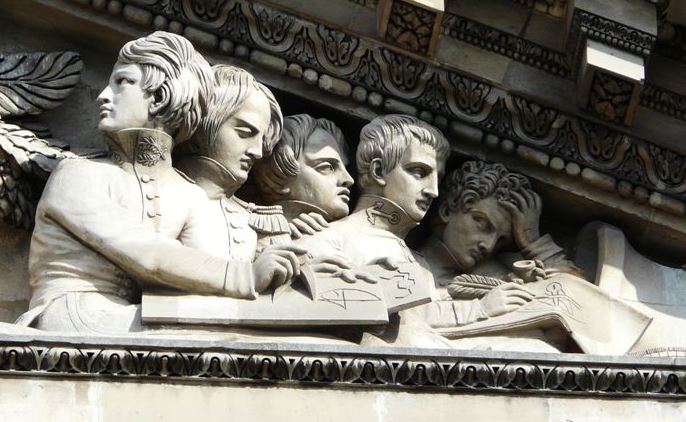
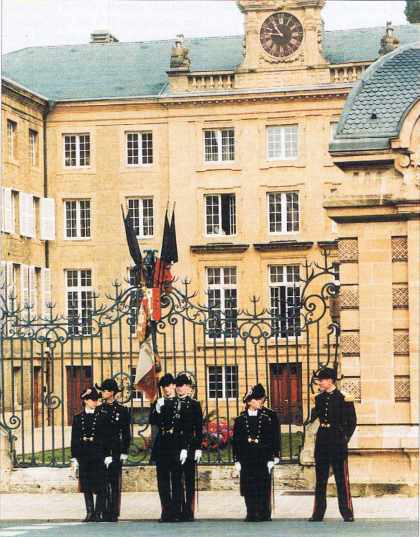
François Arago:
« The brigade leaders, always working with small groups of students in separate rooms, were to have the extremely important task of ironing out difficulties as they arose. Never had a more skilful combination been devised to remove any excuse for mediocrity or laziness.
« This creation belonged to Monge. At Mézières, where the engineering students were divided into two groups of ten, and where, in fact, our colleague acted for some time as permanent brigade leader for both divisions, the presence in the classrooms of a person who was always in a position to overcome objections had produced results that were too fortunate for this former repetiteur, in drafting the developments attached to Fourcroy’s report, not to try to endow the new school with the same advantages.
« Monge did more; he wanted the 23 sections of 16 students each, of which the three divisions were to be composed, to have their brigade leader, as in ordinary times, following the revolutionary lessons, and at the opening of the courses of the three degrees. In a word, he wanted the School, at its beginning, to function as if it had already been in existence for three years.
« Here’s how our colleague achieved this seemingly unattainable goal. It was decided that 25 students, chosen by competitive examination from among the 50 candidates who had received the best marks from the admission examiners, would become brigade leaders of three divisions of the school, after receiving special instruction separately. In the mornings, the 50 young people, like all their classmates, attended revolutionary classes; in the evenings, they were brought together at the Hôtel Pommeuse, near the Palais-Bourbon, and various teachers prepared them for the functions they were destined to perform. Monge presided over this scientific initiation with infinite kindness, ardor and zeal. The memory of his lessons remains indelible in the minds of all those who benefited from them.
Arago then quotes Edme Augustin Sylvain Brissot (1786-1819), son of the famous abolitionist, , one of the 50 students, who reported : « It was there that we began to get to know Monge, this man so kind to youth, so devoted to the propagation of science. Almost always in our midst, he followed lessons in geometry, analysis and physics with private discussions where we found even more to gain. He became a friend to each and every one of the students at the Ecole provisoire, joining in the efforts he was constantly provoking, and applauding, with all the vivacity of his character, the successes of our young minds ».
While mutual teaching is fully practiced, the total dedication of a master as devoted as Monge completes what otherwise becomes nothing more than a « system ».
5. Andrew Bell

It was a Scotsman, the Anglican clergyman Andrew Bell (1753-1832), who claimed the paternity of mutual tuition, which he theorized and practiced in India, at the head of the Egmore Military Asylum for Orphans (Eastern India), an institution created in 1789 to educate and instruct the orphans and destitute sons of the European officers and soldiers of the Madras army.
After 7 years there, Bell returned to London and, in 1797, wrote a report to the East India Company (his employer in Madras) on the incredible benefits of his invention.
Russian physician, naturalist and inventor Iosif Khristianovich (Joseph) Hamel (1788-1862), a member of the Russian Academy of Sciences, was commissioned by Alexander I, Emperor of Russia, to write a full report on this new type of education, which was then being discussed throughout Europe.
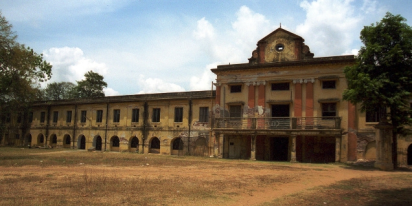
In Der Gegenseitige Unterricht (1818), he reports what Bell wrote in one of his writings: « It happened at this time, that one morning as I was taking my usual walk, I passed a school of young Malabar children, and saw them busy writing on the ground. The idea immediately occurred to me that perhaps the children at my school could be taught the letters of the alphabet by tracing on the sand. I immediately went home and ordered the teacher of the last class to carry out what I had just arranged. Fortunately, the order was very poorly received; for if the master had complied to my satisfaction, it is possible that all further development would have been stopped, and with it the very principle of mutual education… »
Mutual education was coldly received in England, but eventually won over Samuel Nichols, one of the school leaders at St. Botolph’s Aldgate, London’s oldest Anglican Protestant parish. Bell’s precepts were implemented with great success, and his method was taken up by Dr. Briggs when he opened an industrial school in Liverpool.

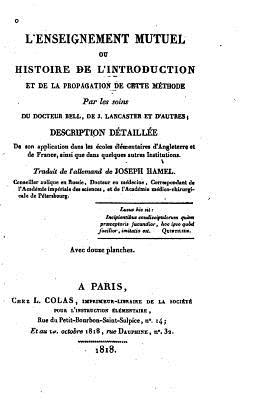

6. Joseph Lancaster

In England, it was Joseph Lancaster (1778-1838), a twenty-year-old London schoolteacher, who seized upon the new way of teaching, perfected it and generalized it on a large scale. (See text of his 1810 booklet)
In 1798, he opened an elementary school for poor children in Borough Road, one of London’s poorest suburbs. Education was not yet totally free, but it was 40% cheaper than other schools in the capital. Lacking money, Lancaster did everything in his power to drive down the costs of what was becoming a veritable « system »: use of sand and slate instead of ink and paper (Erasmus of Rotterdam reported in 1528 that in his day, people wrote with a kind of awl on tables covered in fine dust); boards reproducing the pages of school books hung on the walls to avoid having to buy books; auxiliary teachers replaced by pupils to avoid paying salaries; increase in the number of pupils per class.

By 1804, his school had 700 pupils, and twelve months later, a thousand. Lancaster, getting deeper and deeper into debt, opened a school for 200 girls. To escape his creditors, Lancaster left London in 1806, and on his return was jailed for debt. Two of his friends, dentist Joseph Foxe and straw hat maker William Corston, repaid his debt and founded with him « The Society for the Promotion of the Lancasterian System for the Education of the Poor ».
Other Quakers stepped in with support, notably abolitionist William Wilberforce (1759-1833), whom the french sculptor David d’Angers depicted alongside Condorcet and Abbé Grégoire on his famous monument commemorating Gutenberg in Strasbourg.
From there, as Joseph Hamel recounts in his 1818 report, the new approach spread to the four corners of the world: England, Scotland, France, Prussia, Russia, Italy, Spain, Denmark, Sweden, Poland and Switzerland, not forgetting Senegal and several South American nations such as Brazil and Argentina and of course, the United States of America. Mutual Tuition was adopted as the official pedagogy in New York City (1805), Albany (1810), Georgetown (1811), Washington D.C. (1812), Philadelphia (1817), Boston (1824) and Baltimore (1829), and the Pennsylvania legislature considered statewide adoption.

7. Mutual tuition, how does that works ?
The fundamental principle of « mutual tuition », particularly relevant to elementary school, is reciprocity of instruction between pupils, with the more able serving as teacher to the less able. From the outset, everyone progresses gradually, regardless of the number of pupils.
Bell and Lancaster, and their French disciples, postulated: the diversity of faculties, the inequality of progress, the rhythms of comprehension and acquisition. This led them to divide the school into different classes according to subjects and children’s level of knowledge, with age playing no part in this classification. Schoolchildren thus brought together take part in the same exercises. Their study program is identical in content and methods.
If the number of pupils in a division is too high in a particular subject – reading or arithmetic, for example – sub-groups are formed, which progress in parallel, while the teaching methods and materials remain identical.
So what does a school under the new system look like?
A. The classroom

Whatever the number of pupils – around a 100 in French villages, close to a 1000 in the Lancaster school in London, 200 in Parisian schools – they are grouped together in one single rectangular room with no partitions.
Jomard, who was extraordinarily active and prolific in the early years of the mutual education system, set desirable standards for class sizes ranging from 70 to 1,000 pupils.
For 350 pupils, for example, he indicated the need for a room 18 m long by 9 m wide (graphic).
In England and the French countryside, a barn was often used for the new school. In France, a large number of religious buildings have been disused since the revolutionary period, and meet the required standards perfectly. Many mutual schools were built in these buildings.
B. « Masters » and « monitors »

The mutual method divided responsibility for teaching between the « master » and students designated as « monitors », considered « the linchpin of the method ».
As Bally reminded us as early as 1819: « The basis of mutual teaching rests on the instruction communicated by the strongest pupils to those who are weaker. This principle, which is the merit of this method, required a very special organization to create a reasonable hierarchy, which could contribute in the most effective way to the success of all. »
Each day, in a dedicated « classroom » reserved for instructors, the master imparts knowledge and provides his assistants with technical advice on the proper application of the method. During the course of the day, he remains in charge of the 8th class, and as such is responsible for conducting their exercises. He conducts periodic, monthly or occasional examinations in the classes, and may decide to change classes. Finally, it is he who, at the final stage, distributes punishments and rewards.
C. A day at a mutual school
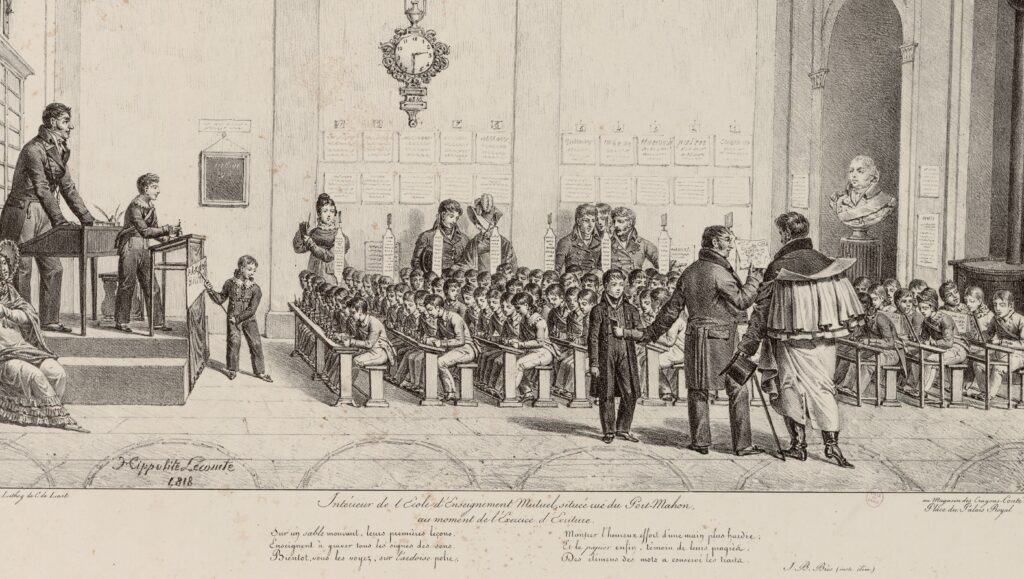
Thus, on a platform, the teacher’s desk with a large drawer where money, reward tickets, registers, writing templates, whistles and children’s notebooks are kept.
Behind the teacher, next to the clock – an essential instrument for organizing teaching life – is a blackboard on which are written sentences and writing models.
At the foot of the platform, benches are attached across the desks, of different sizes, in the middle of the room. The first tables, which are not inclined, have sand on which small children trace signs, while the other tables have slates; on the last of these there are lead inkwells and paper, and chopsticks to indicate words or letters to be read.
At the end of each table are « dictation tables » and telegraphic signals indicating the lesson’s moments, such as « COR » for « correction » or « EX » for « examination of work ». Semicircular table models were then proposed to facilitate the work of the instructors.
D. Progress according to each person’s knowledge

Initially, the mutual school program was limited to the 3 fundamental disciplines of reading, writing and arithmetic, and to the teaching of religion. Geography, grammar, writing, singing and linear drawing were soon added. The instrumental disciplines (music) are taught together, rather than in succession, as is customary in other schools. Pupil groupings are flexible, mobile and differentiated, depending on the nature of the subjects studied and the activities practised in the discipline.
Each subject matter taught in mutual schools is based on a precise, codified curriculum. This program is divided into 8 hierarchical levels, which must be covered in succession. Each degree is called a « class », and this is how we speak of the 8 classes of writing or arithmetic.
The term « class » refers only to acquisitions and knowledge, the 1st class being that of beginners and the 8th that of the completion of the school curriculum. The pace of learning and acquisition varies from student to student and from subject to subject.
Thus, after six months’ attendance, pupil « X » may find himself in 4th class reading, 5th class writing and 2nd class arithmetic. As we said, class assignment is decided on the basis of knowledge level, not age.
But this initial allocation is accompanied, within each class and in each subject, by the constitution of restricted groups established according to the activities to be practiced. In arithmetic, for example, written work is done on the slate. This takes place seated on benches reserved for this purpose, with a maximum of 16 to 18 students per bench, according to the standards established by Jomard.

Oral exercises, in reading or arithmetic, or with the aid of a blackboard, arithmetic or linear drawing, are done standing up, in groups of no more than 9, with pupils standing side by side, forming a semi-circle. Hence the name given to this kind of activity: « circle work ».
So, in a mutual school with 36 students in 3rd arithmetic class, bench work will be done in two groups with two monitors, and blackboard exercises with 4 groups and 4 monitors. Class sizes can therefore vary from school to school and throughout the year, the only limitation being the size of the premises.

D. Tools
Low costs are one of the preoccupations of the new teaching method. Furniture was therefore very basic.
- Benches and desks are made of ordinary planks, fastened with heavy nails. The benches have no backrests: a superfluous luxury!
- The platform is clearly elevated: about 0.65 m. Several steps lead up to the teacher’s desk. The master reigns over the children’s community as much by his material position as by his personal ascendancy.
- The clock is noted as « indispensable », as teaching and maneuvers are strictly timed.
- Half-circles, also known as reading circles, give mutual schools a typical and original appearance. These are usually semi-circular iron hangers that can be raised or lowered at will. Sometimes, the materialization is simply applied to the floor: grooves, large nails or arched strips.
- Blackboards were systematically used for linear drawing and arithmetic. They are 1 m long and 0.70 m wide, with a movable meter at the top. They are placed inside each semicircle.
- Telegraphs. When work takes place at the tables, such as writing, signals are used to link and communicate between the general monitor and the individual monitors: these are the telegraphs. A planchette, attached to the upper end of a round stick 1.70 m high, is installed at the first table of each class, thanks to two holes drilled at the top and bottom of the desk. On one side is the class number (1 to 8); on the other, EX (examen), replaced around 1830 by COR (correction). These telegraphs are portable. They could be moved if the number of students increased or decreased. In this way, the master and the general monitor have the exact composition of each class and the number of tables occupied by each. As soon as an exercise is completed, the class monitor turns the telegraph and presents the EX side to the desk. All monitors do the same. The general monitor gives the order to proceed with inspection and any corrections. Once these have been completed, the class number is presented again. And the exercises resume. Next to the telegraphs are the occasional board stands.
- Monitor rods. These are used to indicate on tables the letters or words to be read, the details of operations to be carried out, and the lines to be reproduced. In rural schools, these are generally only available thanks to the good will and ingenuity of the teachers, who obtain them from nearby woods.
- Sand (for writing) and then slates are constantly used in all subjects. This was an essential innovation in the mutual mode, as other schools did not use them.
- Boards instead of books. The first reason is financial, as a single board is sufficient for up to nine pupils. But the pedagogical reasons are no less important. The format makes them easy to read and store. The concern for presentation and highlighting certain characters is accompanied by a different layout from that of the textbooks.
- Books are reserved for the eighth grade, as are nibs, ink and paper.
- Registers, currently in use, ensure sound management of the schools. One in particular deserves special mention: « Le grand livre de l’école » (the school’s ledger), which is first and foremost a registration book. It records the child’s surname, first name and age, as well as the parents’ occupation and address. The teacher enters the precise date of entry and exit of each child, in each class, including music and linear drawing.
E. Communication

To ensure that dozens or hundreds of pupils are led and developed correctly, and to avoid wasting time, those in charge of mutual education have planned precise, rapid, immediately comprehensible orders:
- The voice is rarely used. Injunctions transmitted in this way are generally addressed to the instructors, sometimes to a specific class;
- The bell attracts attention. It precedes information or a movement to be executed;
- The whistle has a dual function. It is used to intervene in the general order of the school, « to impose silence », for example, and to signal the start or end of certain exercises during the lesson, « to have the pupils say by heart, to spell, to stop reading ». Only the teacher is authorized to use them.
- As for hand signals, they have been used extensively. Intended to evoke the act or movement to be accomplished, they attract the eye and should bring calm to the community.
« Bellists » versus « Lancasterians »
While the two schools, Bell’s and Lancaster’s, were very close to each other in terms of content, methods and organization, they clashed violently over the role and place of religious education. All other program-related differences are a matter of taste, habit or local circumstance.
As Sylvian Tinembert and Edward Pahud point out in « Une innovation pédagogique, le cas de l’enseignement mutuel au XIXe siècle » (Editions Livreo-Alphil, 2019), Lancaster, as a follower of the dissident Quaker movement,
« recognized Christianity but professed that belief belonged to the professional sphere and that each person was free in his or her convictions. He also advocates egalitarianism, tolerance and the idea that, in this country, there is such a variety of religions and sects that it is impossible to teach all doctrines. Consequently, it is necessary to remain neutral, to limit teaching to the reading of the Bible, avoiding any interpretation, and to leave fundamental religious instruction to the various churches, ensuring that pupils follow the services and teachings of the denomination to which they belong ».
Nevertheless, Bellists and Lancasterians had their differences. For the Lancasterians, Bell had invented nothing and was merely describing what he had seen in India. For the Bellists, furious that Lancaster found a positive response from certain members of the Royal family, Lancaster was portrayed as the devil, an « enemy » of the official Anglican religion, who admitted children of all origins and denominations to his schools !
9. France adopting mutuel tuition
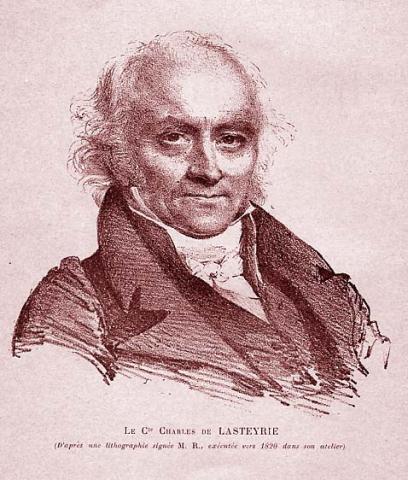
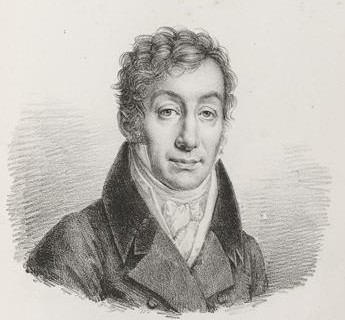
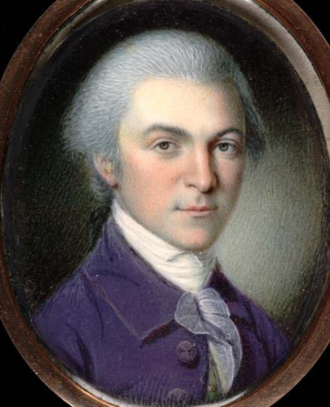
In London, the Lancaster association was joined by a number of high-ranking personalities, both English and foreign. These included Geneva physicist Marc Auguste Pictet de Rochemont (1752-1825), French paleontologist Georges Cuvier (1769-1832) and his compatriots, agronomist Charles Philibert de Lasteyrie (1759-1849) and Lancaster’s future translator into French, archaeologist Alexandre de Laborde (1773-1842).
After the peace of 1814, many countries – notably England, Prussia, France and Russia – bled dry by the Napoleonic wars, which had resulted in the loss of thousands of young teachers and qualified executives on the battlefields, made education their top priority, not least to keep up with the industrial revolution that was coming to shake them to their foundations.
Added to this is the fact that the number of orphans in Europe has become a major problem for all states, especially as the coffers are empty. To keep street children occupied, schools were needed, many of them to be built with very little money and many teachers… nonexistent. Learning of the resounding success of mutual education, several Frenchmen travelled to England to discover the new method.
Laborde brought back his « Plan d’éducation pour les enfants pauvres, d’après les deux méthodes (du docteur Bell et de M. Lancaster) », and Lasteyrie his « Nouveau système d’éducation pour les écoles primaires ». In 1815, the Duc de la Rochefoucauld-Liancourt (1747-1827) published his book on Joseph Lancaster’s « Système anglais d’instruction ».

Since 1802, Paris had been home to the « Société d’encouragement pour l’industrie nationale », whose Secretary General was linguist Joseph-Marie de Gérando (1772-1842), and of whom Laborde was a founder together with Jean-Antoine Chaptal (1752-1832). Unsurprisingly, Gérando had been raised by the Oratorians and was initially destined for the Church.
On March 1, 1815, Lasteyrie, Laborde and Gérando proposed to the Société d’Encouragement the creation of a new association whose purpose would be « to gather and spread enlightenment likely to provide the lower classes of the people with the kind of intellectual and moral education most suited to their needs ».
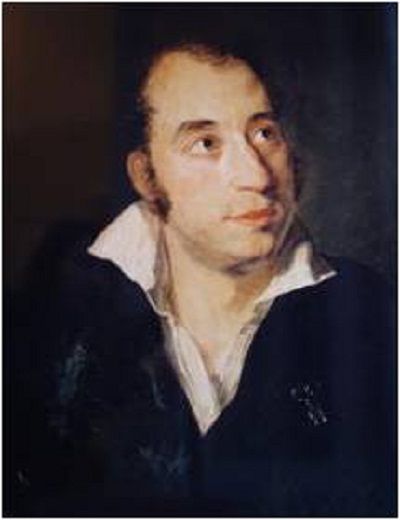
In his report presented to the Société d’Encouragement on March 20, 1815, Gérando proposed that the newly-appointed Minister of the Interior, Lazare Carnot (During les Cents-Jour, i.e. between March 20-June 22, 1815), be asked to promote « the adoption of procedures likely to regenerate primary education in France », i.e. the system of mutual tuition.
Political and social interests were not the only ones at stake. The French economy, too, was much to benefit from the development of education. « What can we expect, » said Carnot in 1815, « if the man who drives the plough is as stupid as the horses that pull it?«
Gérando also proposed the creation of an association dedicated specifically to its propagation, underlining the advantages of the new approach: economic advantage first, since it involves « employing the children themselves, in relation to each other, as teaching aids », and that a single teacher is sufficient for 1,000 pupils; educational advantage second, since it is possible « to teach, in two years, everything that children of inferior conditions need to know, and much more than they learn today by much longer processes »; a moral and social advantage, insofar as children « are imbued from an early age with a sense of duty, a feeling that will one day guarantee their obedience to the law and their respect for the social order ».
The engineer-geographer and polytechnician Edeme-François Jomard (1777-1862), for whom the education of the people is an obligation of society towards itself, said nothing else: « How can we demand that unfortunate people, devoid of all enlightenment, know the social pact and submit to it? Or how can we, without being foolish, count on their invariable and blind submission?«
The Société d’Encouragement then validated the conclusions of its report by subscribing the sum of 500 francs in favor of the new association, and by deciding that, in addition to its moral influence, it would place at the latter’s disposal the various means of execution that might belong to it.
10. Lazare Carnot at the helm

Following the Concordat between Napoleon and the Vatican, the Emperor issued a decree on education on August 15, 1808, requiring schools to follow the « principles of the Catholic Church ».
The Frères des Ecoles Chrétiennes (Institute of the Brothers of the Christian Schools), unconditional advocates of the « simultaneous education » theorized by their founder Jean-Baptiste de La Salle (1651-1719), were to take charge of all primary education and train teachers.
Disbanded during the Revolution, the Brothers resumed their functions in 1810. Encouraged to develop to counter the influence of the Jesuits, authorized in 1816 to return to France, they rapidly expanded throughout France.
But the educational situation was pitiful. This is what senior French officials constantly say when they visit the territories annexed by the Empire, notably North Germany and Holland. The comparison with France makes them blush with shame.
In 1810, the naturalist Georges Cuvier wrote in his report:
« We would be hard pressed to convey the effect produced on us by the first elementary school we entered in Holland. Children, teachers, premises, methods, teaching, everything is in perfect order (…) Several prefects have assured us that we would not find a single young boy in their department today who did not know how to read and write. »
Faced with such a contrast, which was not to the conqueror’s advantage, the Imperial University, like ancient Rome, set out to teach the conquered country. In his decree of November 15, 1811, the Emperor decided:
« The council of our Imperial University will present us with a report on the part of the system established in Holland for primary instruction that would be applicable to the other departments of our Empire. »
The Emperor abdicated on April 4, 1814, before any decision had been taken to regenerate the French « petites écoles ». At least the Imperial University’s reports had exposed their misery and drawn public attention to them.
Appointed Minister of the Interior, and therefore in charge of Education during the Cents-Jours, Lazare Carnot, a co-founder of the Ecole Polytechnique, was completely convinced of the potential excellence of « mutual education ».
On April 10, 1815, he set up a Council for Industry and Charity, at whose first meeting he himself presented Gérando‘s report;
On April 27, 1815, he submitted a report to the Emperor in which he stated:
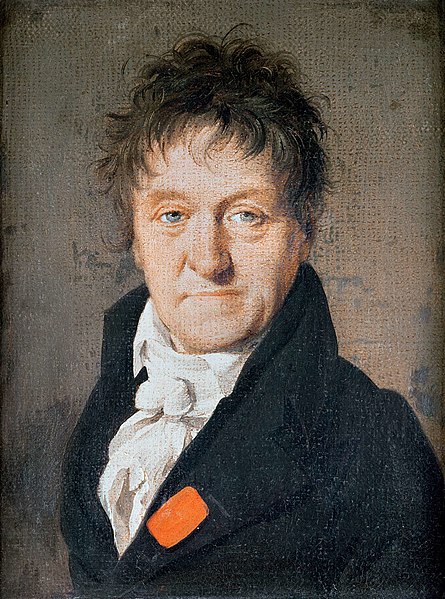
« There are 2 million children in France clamoring for primary education, and of these 2 million, some receive a very imperfect education, while others are completely deprived« .
He then recommended mutual education, whose « purpose is to give primary education the greatest degree of simplicity, rapidity and economy, while also giving it the degree of perfection suitable for the lower classes of society, and also by bringing into it everything that can give rise to and maintain in the hearts of children a sense of duty, justice, honor and respect for the established order ».
Minutes later, Lazare Carnot had the French Emperor sign the following decree:
« Article 1. – Our Minister of the Interior will call upon those persons who deserve to be consulted on the best methods of primary education. He will examine these methods, and decide on and direct the testing of those he deems to be preferable.
« Art. 2 – A primary education test school will be opened in Paris, organized in such a way as to be able to serve as a model and to become a normal school for training primary school teachers.
« Art. 3 – Once satisfactory results have been obtained from the trial school, our Minister of the Interior will propose the appropriate measures to ensure that all departments can rapidly benefit from the new methods that will have been adopted.«
For Carnot, contrary to those in the business of Philanthropy, there were not any longer poor or rich children. All citizens of the Republic required and had to be offered the best education available on Earth.
The advisory board set up by Carnot included his friends Laborde, Jomard, Abbé Gaultier, then Lasteyrie and Gérando, i.e. the very promoters or first founders of the Société en formation.
Thus, on June 17, 1815 (the eve of the defeat at Waterloo), the Société pour l’instruction élémentaire (SIE) was born, still under the impetus of Carnot, determined to win the war for education. The SIE’s first general meeting was held on the premises of the Société d’Encouragement. At its head were several protagonists of the ministerial commission: Jomard became one of the secretaries of the new society, alongside Gérando (president), Lasteyrie (vice-president) and Laborde (general secretary).


for whom Mutual Tuition was the core of their commitment to primary education.
Before the ordinance of 1816, the number of children attending « petites écoles » was 165,000 throughout France, and by the end of 1820 it had risen to 1,123,000. Almost a factor of 10!
Lazare Carnot clearly wanted to perpetuate the offensive he had launched during the Hundred Days to propagate mutual education throughout the country and, in so doing, to rapidly develop the education of all the children of the Patrie.
After its creation, subscriptions for the SIE poured in, and before long 150 names were added to those of the founders to promote and organize mutual education in France. One of these subscribers was Lazare Carnot.
In its first year of existence, the SIE attracted almost 700 members, initially teachers from the École Polytechnique (Ampère, Berthollet, Chaptal, Guyton de Morveau, Hachette, Mérimée, Thénard), and then some 30 alumni, around half of them from the first graduating class (1794) of the École Polytechnique. Among the latter were a fellow student of Jomard‘s at the geographers’ school, Louis-Benjamin Francœur, professor of higher algebra at the Paris Faculty of Science, comrades from the Egyptian campaign, and Chabrol de Volvic, prefect of the Seine since 1812.
All had but one hope: that Monge’s genial methods of brigades and mutual tuition, which had been diminished and banned once Napoleon turned Polytechnique into a mere military school under the direction of mathematician Pierre-Simon Laplace (1749-1827), could benefit the greatest number and organize a national recovery.
Based in Paris, the SIE extended its operations to the provinces, where it encouraged the founding of subsidiary companies, to which it offered « to send them teachers, to provide them with any information they might need, to give them paintings and books at cost price… ».

The SIE was also interested in education girls (art. 10). It set up a committee of ladies to look after them: president, Baroness de Gérando; vice-president, Countess de Laborde.
Beyond women, the movement spread to uneducated adults, so numerous at the time. On May 1, 1816, the Society set up a commission for the establishment of adult schools. It was also concerned with barracks, which were to be turned into military schools; prisons, especially children’s prisons; and the colored inhabitants of the colonies, who were to be regenerated by the development of education.
Finally, the members of the Society, attributing a human and general value to their mission, dreamed of founding branches abroad. In November 1818, Laborde called for the creation of a special committee to do so.
Last but not least, the Society did not limit its activities to simply creating schools, but also organized inspections and examinations. It published works (on the mutual tuition method, elementary books on reading, grammar and arithmetic). It distributed awards to the best teachers and instructors.

Following the promulgation of the ordinance of July 29, 1818 authorizing Caisse d’Epargne societies (Saving Banks associations), it asked teachers to entrust part of their salaries to these funds to ensure their retirement; setting an example, it deposited funds with the Caisse for the teachers of the schools it had set up.
Today, the SIE, whose head office is a specially-built building at 6, rue du Fouarre in the 5th arrondissement of Paris, remains the oldest and largest secular primary education association in France.
11. The rue Saint-Jean-de-Beauvais pilot program
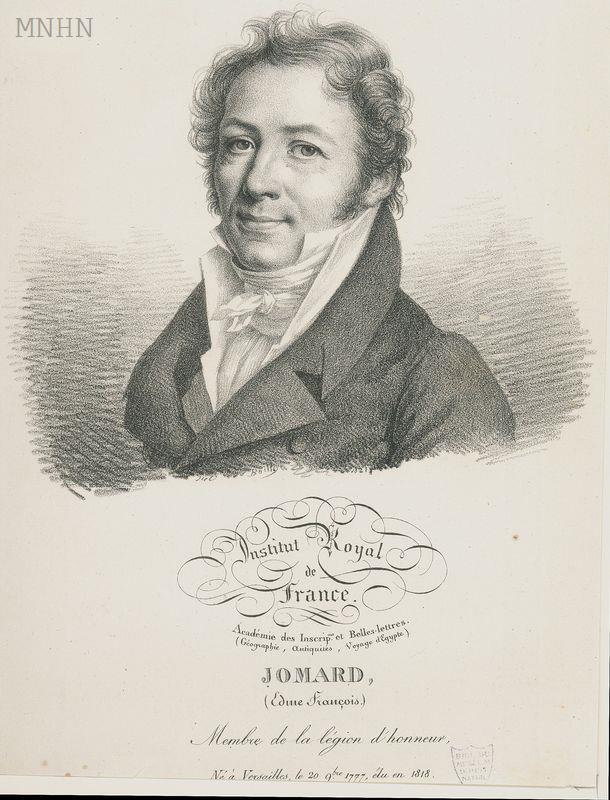
As said before, after his trip to England, Jomard, whose portrait appears in a medaillon on the façade of the SIE, also embraced the new system.
In his « reflections on the state of English industry », he wrote, after expressing his enthusiasm for various inventions observed across the Channel: « There is, however, something even more extraordinary: these are schools without teachers: nothing, however, is more real. We now know that there are thousands of children taught without a teacher, and at no cost to their families or the State: an admirable method that will soon spread to France.«
A graduate of the Ecole Polytechnique, and an exceptionnal scientist who went with Monge to Egypt, Jomard was the ideal man to oversee the material organization of the test school, in particular by arranging for furniture to be made and teaching aids to be printed in accordance with English principles. Jomard also supervised the training of a small nucleus of students – around 20 – as « monitors » before the opening of the school proper in September 1815, planned for 350 students: a modality reminiscent of the « chefs de brigade » of the first graduating class of the École polytechnique.
However, the members of the SIE soon realized that they needed to train trainers. The English therefore welcomed several Frenchmen to train them in mutual teaching. A pastor from the Cévennes, François Martin (1793-1837), after training as a « monitor » in England, was called in by Lasteyrie to run the first mutual school, which opened its doors on June 13, 1815, on rue Saint-Jean-de-Beauvais in Paris, close to Place Maubert. This was the model school that would enable other mutual schools to be opened, thanks to the training of competent « monitors ». The school was soon unable to keep up with demand from hundreds of communes, which were considering sending one of their own to be trained in the new method.
Pastor Paul-Emile Frossard, also trained by the English, took charge of a Parisian school on rue Popincourt, while Bellot ran another. In July, Martin submitted his report. The model class takes in some 15 students destined to become monitors and principals of elementary schools with up to 350 children. Martin reports that in six weeks, they read, write, calculate and « know how to execute the movements that form the gymnastic part of the new education system ».
12. Mutual tuition and music
As Christine Bierre amply documents in her article « La musique et formation du citoyen à l’ère de la Révolution française » (1990):
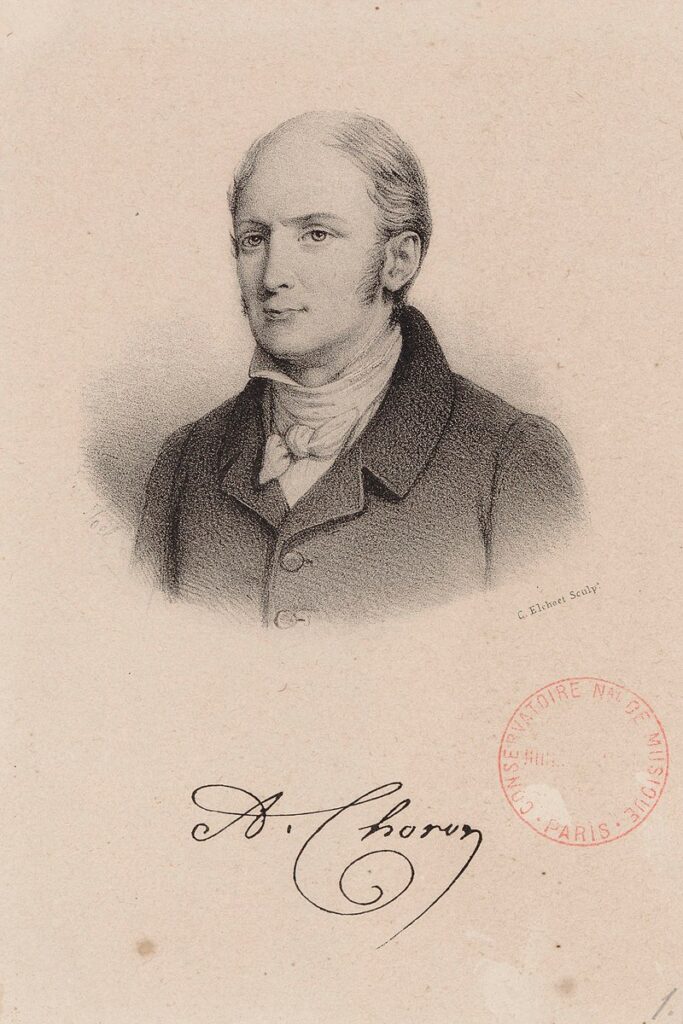
« It was at this school on rue Saint-Jean-de-Beauvais, under the direction of a Commission comprising Gérando, Jomard, Lasteyrie, Laborde and Abbé Gaultier, that the application of mutual teaching to the learning of solfeggio and singing was tested for the first time. Alexandre Choron (1771-1834), who since 1814 had opened two music schools for boys and girls, was also a member of the Commission. Not surprisingly, it was on the initiative of Baron de Gérando that the idea of introducing singing into primary education was adopted. When Monsieur le baron de Gérando proposed the introduction of elementary singing in primary schools’, says Jomard in a report presented to the Board of Directors of the Société pour l’Enseignement mutuel, ‘you were all struck by the correctness of the views developed by our colleague (…) It showed the happy influence that such a practice could have, and the real connection that exists between the proper use of song and the perfecting of morals, the ultimate goal of instruction and of all our efforts. Not only was the application of mutual instruction to music revolutionary in itself, but what was equally revolutionary was the fact that children were learning to read and write, almost as intensively. Children studied singing, for four to five hours a week! »
In fact, it was Lazare Carnot himself who wanted to introduce music into the mutual education schools. To this end, he met several times with musician Alexandre Choron (1771-1834), who brought together a number of children and had them perform in his presence several pieces learned in very few lessons. Carnot also was acquinted with Guillaume-Louis Bocquillon, known as Wilhem (1781-1842) for ten years. He saw the possibility of using him to introduce singing into schools, and together they visited the one on rue Saint-Jean-de-Beauvais, a free pilot school for mutual education in Paris open to three hundred children.
Michael Werner‘s recent article, « Musique et pacification sociale, missions fondatrices de l’éducation musicale (1795-1860) », echoes and confirms the groundbreaking research initiated by Christine Bierre in 1990.

Excerpt:
« One of the fields in which the results of mutualist pedagogy are clearly visible is musical education. Several players played a decisive role here, and deserve a brief mention.
The first is Guillaume-Louis Bocquillon, known as Wilhem (1781-1842). The son of an officer and himself from a military background, he then devoted himself to musical composition and teaching, particularly at the Lycée Napoléon (later Collège Henri-IV). His friend Pierre Jean de Béranger put him in touch with Joseph-Marie de Gérando and François Jomard, the leading lights of the SIE. Through them, he learned about mutual teaching and immediately understood the benefits of this method for musical education. In 1818, the Paris municipality allowed him to set up a first experiment at the elementary school on rue Saint-Jean-de-Beauvais. Wilhem developed a method, the necessary teaching materials (in the form of charts) and instructed the chosen student monitors. The results were, according to Jomard, spectacular. At the end of a few months’ instruction, the pupils had not only acquired the basic notions of solfeggio and musical notation, chromatic scales, intervals and measures, but were also performing collective songs in several voices (Jomard 1842: 228 ff)
This success led the SIE to propose to the Prefect and Minister of the Interior that music be introduced into the teaching of elementary schools in the city of Paris, a move officially endorsed in 1820. Wilhem himself was appointed full professor of music teaching in Paris, and music classes were introduced in many of the city’s schools, before spreading to the départements and regions. At the same time, the municipality opened two teacher-training colleges to train future singing teachers.
The second early player in the debate was the composer Alexandre Choron (1771-1834). A member, like Jomard and Francœur, of the first graduating class of the École polytechnique (1795), composer and friend of André Grétry, he had been concerned since 1805 about the decline of choral singing following the abolition of the master classes. An opponent of the Conservatoire, whose academicism and lack of interest in the teaching of choral singing he criticized, in 1812 he was entrusted by the Ministry with a mission to « reorganize the choir and the choirmasters of the churches of France ». He developed a teaching method known as the « concertante method », but also remained committed to the social vocation of choral music. Choron was also one of the founding members of the SIE in 1815, a sign of his commitment to educational issues. During the Restoration, he turned more to religious songs, which he considered to be the historical heart of choral practice. (…) Finally, with the king’s support, he founded the Institution royale de musique classique et religieuse, successfully competing with the Conservatoire in the teaching of vocal art.
For the general public, he arranged for oratorios, requiems and cantatas to be performed by singers from his school in a number of spacious churches, thus ensuring a new presence for sacred music on the Parisian stage. For some of these concerts, he sometimes mobilized student singers from elementary and poor schools, whom he never ceased to follow throughout his career. »
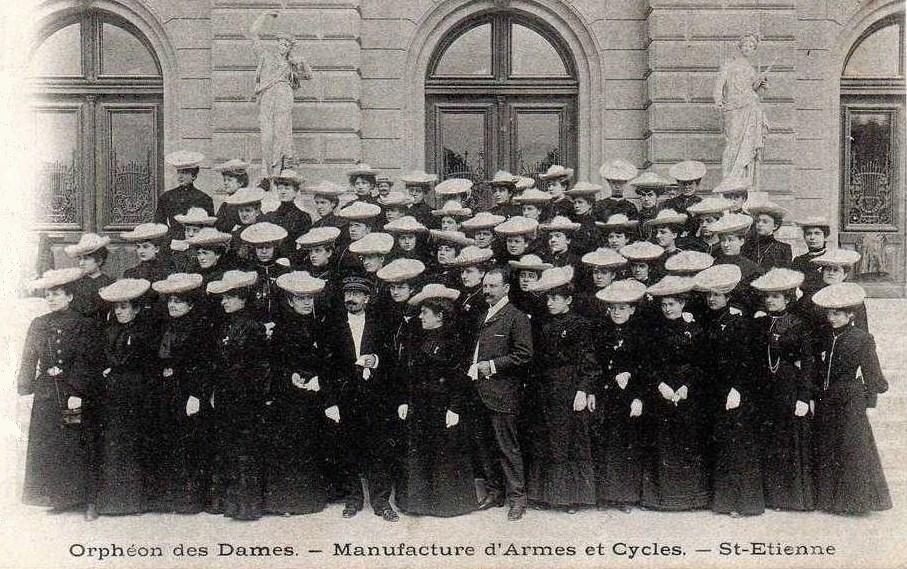
« (…) What fostered this expansion of music education for young people and the working classes from 1820 onwards was a political will shared by a broad spectrum of leaders and stakeholders. The liberals who formed the core of the SIE continued to adhere to the emancipatory mission of education set out by the Convention. By focusing on both the inner formation of the soul and the blossoming of a collective conscience, music – and singing in particular – became a prime field for popular education. Liberals therefore emphasized the moral benefits of music. Thus, in his proposal to introduce singing into elementary school, Gérando remarks:
‘Those of us who have visited Germany have been surprised to see how much simple music plays a part in popular entertainment and family pleasures, even in the poorest conditions, and have observed how salutary its influence is on morals. And Joseph d’Ortigue states lapidary: ‘A people that sings is a happy people, and therefore a moral people. This emphasis on the social benefits of musical activity fits in well with the idea of ‘universal education’, inherited from the Enlightenment and the foundation of the pedagogies of Lancaster in England or Johann Heinrich Pestalozzi in Switzerland.' »
After a trial run at the St-Jean-de-Beauvais school in 1819, singing quickly spread to all the mutual schools. Wilhem was both the creator and the architect of the development of this teaching method, which soon spread to adult and apprentice classes. Periodic meetings of children initiated into vocal music were organized. Thus was born the first French post-school organization: the Orphéon, which, after Wilhem, counted Charles Gounod and Jules Pasdeloup among its directors.
In an 1842 speech to the SIE, Hippolyte Carnot asserted that Wilhem had « elevated music to the rank of a civic institution », and that the « ennoblement » of the individual soul was to be achieved in the new collective order of the reunited nation.
13. Jomard, Choron, Francoeur and « elementary » knowledge
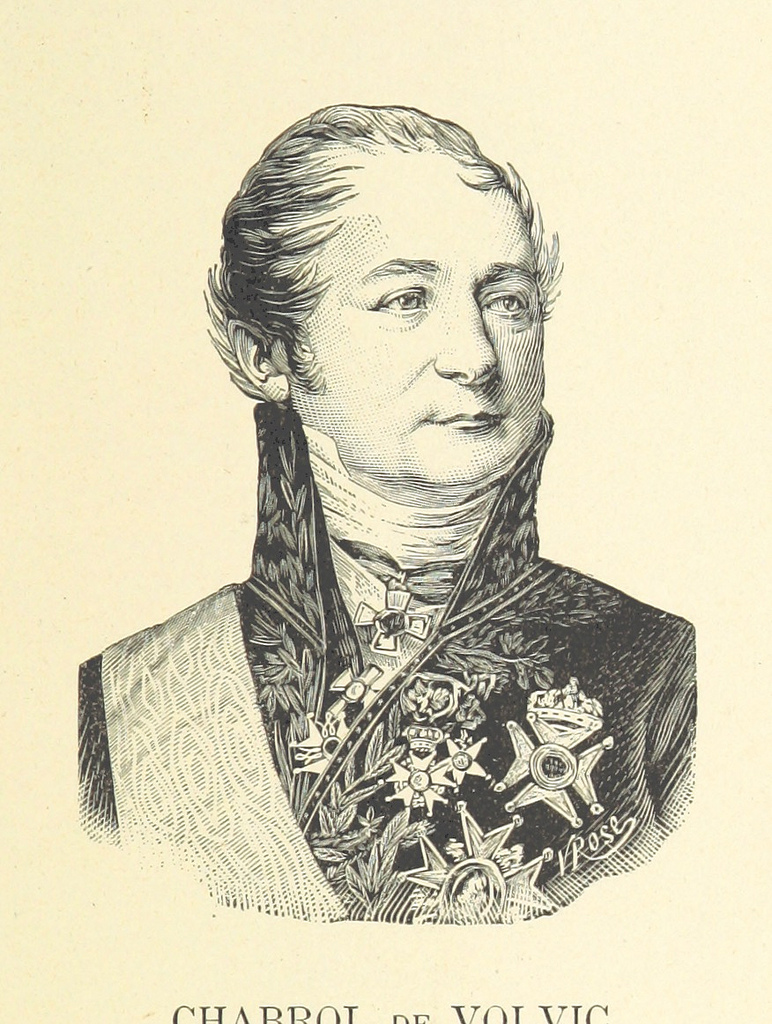
Renaud d’Enfert‘s comprehensive article, published on the website of the Société de la bibliothèque et de l’histoire de l’Ecole polytechique (SABIX), completes the picture with a close-up on the work of Jomard and Francoeur, whose portraits are featured in a medallion on the façade of the SIE headquarters on rue du Fouarre in Paris.
Right from the start of the Second Restoration, the SEI received the backing and support of the Prefect of the Seine, Gaspard de Chabrol de Volvic (1773-1843). In the summer of 1815, the latter appointed Jomard, a linguist in contact with the Humboldt brothers who had been part of the short-lived commission under Carnot and who had protected him during the Hundred Days, « head of the office of public instruction and arts », a position he held until 1823.
In a decree dated November 3, 1815, Volvic, in order to take « the necessary measures to extend the benefits of instruction to all poor families domiciled within the prefecture » and to develop « the new system of elementary instruction » throughout the Seine department, created an eleven-person committee « to extend the benefits of free education to the Seine department », and included all the influential members of the SIE (Jomard, Gérando, Laborde, Doudeauville, Lasteyrie, Gaultier, etc.). ).
In this role, Jomard was responsible for finding sites for new schools. These rapidly multiplied in and around the capital: in 1818, he counted 18 free and 32 fee-paying mutual schools covering all of the capital’s arrondissements, as well as 13 schools in the arrondissements of Sceaux and Saint-Denis. From this work, he drew up his « Abrégé des écoles élémentaires » (1816), a sort of practical guide in which he compiled everything a cityen decided to set up a mutual school needed to know about material organization.
On the pedagogical front, Jomard was the author, in 1816, of a reading method produced in collaboration with the composer and musician Alexandre Choron, who had published a method for learning to read and write as early as 1802, and Abbé Gaultier, a pedagogue who had developed a teaching method under the name of « jeux instructifs » and had traveled to London to study English methods.

Designed for the new elementary school on rue Saint-Jean-de-Beauvais, where Choron was appointed music teacher, it breaks with the traditional spelling method.
Instead of saying « b-o-n = bon », she uses the musical sounds of the language to say « b-on = bon ». In 1821-1822, Jomard also published « Arithmétique élémentaire » (Elementary Arithmetic), designed to remedy the weaknesses of Lancaster’s arithmetic method, which he accused of « making children contract a simple, routine and mechanical habit » instead of serving « to fortify their attention and train them in reasoning ». In the meantime, he and Francœur and Lasteyrie had set up a « calligraphy commission » at the SIE, to develop the principles that would guide the teaching of writing in mutual schools, a writing style intended to be « national », to replace the English models.

For his part, Louis-Benjamin Francoeur (1773-1849) provides, according to Jomard, « a long series of luminous reports on treatises on arithmetic, weights and measures, singing and musical art, drawing and geometry, which it would take far too long to relate or quote ». Filling a gap, in 1819 Francœur published « Le dessin linéaire » (Linear Drawing), a drawing method based on freehand drawing of geometric figures, which broke with traditional, academically inspired ways of teaching and learning drawing.
For Jomard and Francoeur, the idea behind « mutuel tuition » was to broaden the range of subjects taught in primary schools beyond the traditional « reading, writing and arithmetic »: in addition to drawing, also singing, gymnastics, geography and grammar now made their appearance in elementary school.

Linear drawing was nonetheless seen as an elementary skill in its own right, on a par with reading, writing and arithmetic.
Presenting Francœur‘s method to the Société d’Encouragement, Jomard declared:
« The usefulness that industry may one day derive from it is so great and so visible, that it would be superfluous to insist on it. It is not without reason that this result has been considered as precious for the people, as the knowledge of reading and writing ».
Finally, for Jomard, the widespread teaching of reading, writing, arithmetic, linear drawing and singing is the prerequisite for the scientific education of the people:
« In recent times, we have rightly insisted on the usefulness of teaching the elements of the physical and mathematical sciences to the working class. On this depends the advancement of industry and agriculture, which, despite all their progress, are still backward in many respects. It is only through the possession of these elementary notions that workers will perfect their processes, their means, their instruments and their products, and will be able to become skilful foremen and good workshop managers. But how can this be achieved when the mass of the population is still so ignorant?
How, without the art of reading and writing, could they not understand a single word of the chemical and mechanical arts, but only feel their advantage and consent to engage in arduous studies? What’s this! Fifteen million Frenchmen and more perhaps, do not know how to do the first two rules of arithmetic, and we would flatter ourselves to propagate among them the first principles of mechanics and geometry! The basis of this improvement is obviously primary education made more general or even universal ».
14. Nationwide

The results of mutual education are spectacular and rapid, both in terms of learning time and the quality of skills acquired. Whereas in the Lasalle Brothers’ schools it took 4 years to learn to read, this time was reduced to a year and a half in the mutuel establishments!
The enthusiastic French of 1815, with their vivid imagination, saw in this teaching system a veritable panacea. It had undeniable advantages. First of all, it was economical, requiring few teachers and enabling a considerable number of children to be taught at low cost. It is estimated that 4,000 to 5,000 fr. a year were sufficient to maintain a school of 1,000 children: 4 fr. per pupil! Education would never have been so cheap. It also ensured rapid development of primary education, since the shortage of teachers was no longer a limiting factor. With figures to back it up, it was calculated that it would only take a dozen years to extend the benefits of primary education to the whole of France!
To these indisputable advantages, the travelers of 1815 added qualitative arguments. They considered the teaching of instructors superior to that of masters: « He does not know his lesson better than the master, » wrote Laborde, « but he knows it differently ». The child instructor (monitor) takes pleasure in communicating his newly acquired knowledge to his classmates, doing his job « with as much charm as a preceptor finds it disgusting » (Laborde).
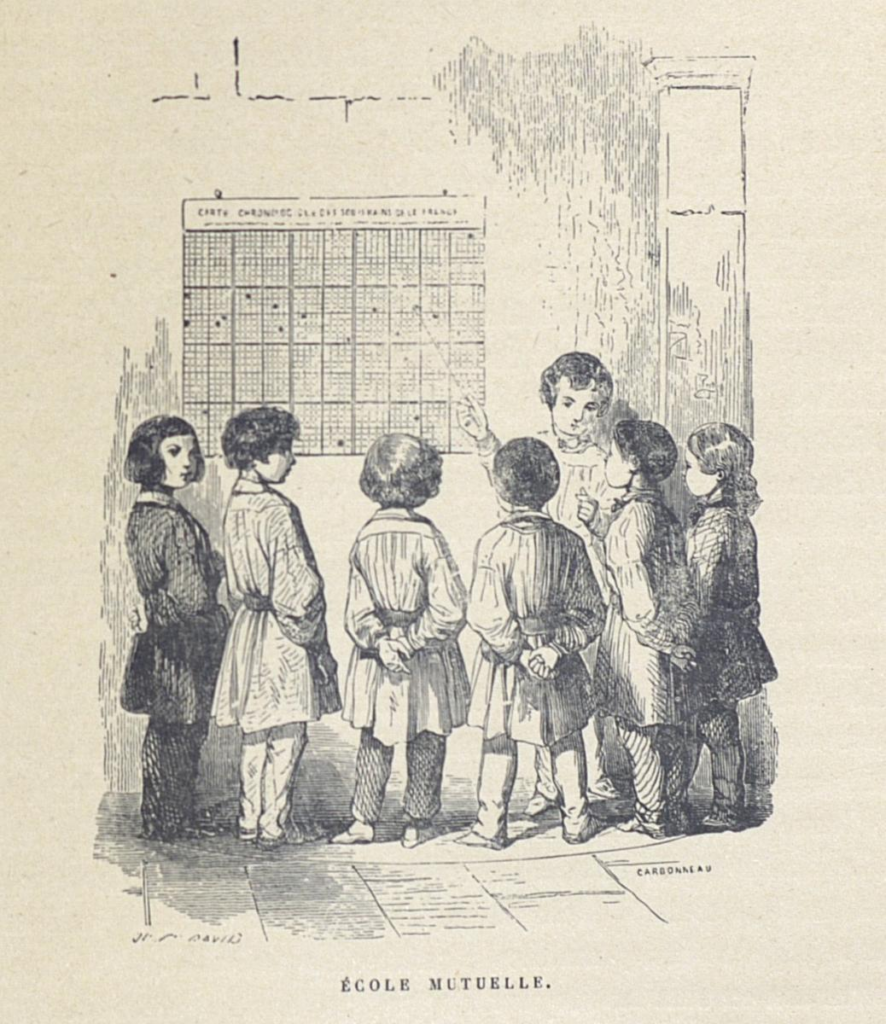
On the other hand, being a child himself, he knows better than the teacher the difficulties of the task, the pitfalls of the lesson, over which he has just stumbled. He will therefore lead his classmates more slowly, more surely, and be a better guide for them.
But teaching won’t be the only thing to benefit from the mutual system; school discipline and morals will also benefit. The child, submissive to his classmate, will obey him more readily than the teacher, since the young instructor owes his superiority solely to his own merit. Finally, the child, with his classmate who knows him well because he lives with him, will not have, as with the teacher, the resource of lying to hide his intimate thoughts or faults: and dissimulation, the social scourge that was learned from the school benches, will thus disappear from mutual establishments.
And Laborde concluded his apology for the method : in the new schools, « work is for them a game, science a struggle, authority a reward ».
The benefits of this teaching were not to be confined to the school: children returning home would in turn exert a happy influence on their parents, becoming « missionaries » of both morality and truth in their families.
Gontard wrote in 1956:
« And let no evil spirits say that these are the daydreams and utopias of idealists! There is irrefutable proof of the value of this method. Look at Scotland. At the end of the 17th century, it was a land of beggary and misery, living without law, without religion, without morals, men drinking, women blaspheming, all fighting. In 1815, thanks to the magic wand of the mutual school, Scotland became a paradise. « It is not uncommon in Scotland to find a shepherd reading Virgil… but it is almost unheard of to meet a malefactor there, »
Laborde agrees.
« Let’s develop the method in France and, by 1850, it will be a land of prosperity and happiness, from which immorality, fanaticism, revolutions and social unrest, all sons and daughters of ignorance, will be banished. »
In 1818, Joseph Hamel, in his report to the Emperor of Russia, notes:
« The method of mutual education has been introduced throughout France with a rapidity and success far greater than could reasonably be expected, and in less than three years more than 400 schools have already been founded. There is every reason to hope that, in the not-too-distant future, more than 2 million children who were still in complete ignorance will be able to receive the benefits of a free education, sufficient for their future vocation.«
Right from the start, with Carnot and a generation of brilliant scientist coming out of Polytechnique, France was giving leadership !
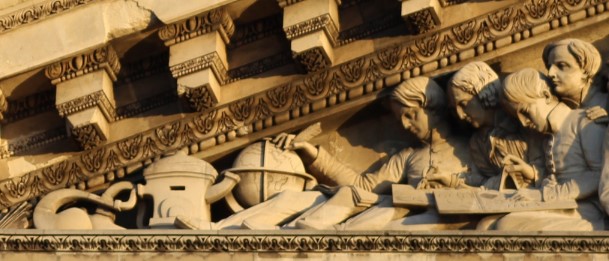
Amiens and the Somme department
Interesting in that regard, the following account of the adoption of mutual tuition methods in Amiens and the Somme department.
« On May 15, 1817, after much mistrust and hesitation, the Amiens town council founded a society to encourage elementary education in the department. More than ennobling the pupils’ souls, for the rector, it was a question of ‘giving the children of these workers an elementary education, [to prepare them] not only for the habit of order and subordination that is acquired in the mutual education schools and which they carry over to the workshops, but also to put them in a position to serve more usefully inside the factories, how to study the industrial processes whose preservation and improvement are so essential to national prosperity' ».
For the Rector, speed of acquisition was a guarantee of success for the new method compared to the « simultaneous method »:
« That a primary education which takes children away for whole years from work necessary for the family’s subsistence becomes for the poor a very onerous burden; but that experience teaches the father of a family that a few months will suffice to procure for his children an advantage which he has regretted so many times in the course of life not to have been able to enjoy himself, we must hope that he will not sway to make a slight sacrifice in order to obtain an important result ».
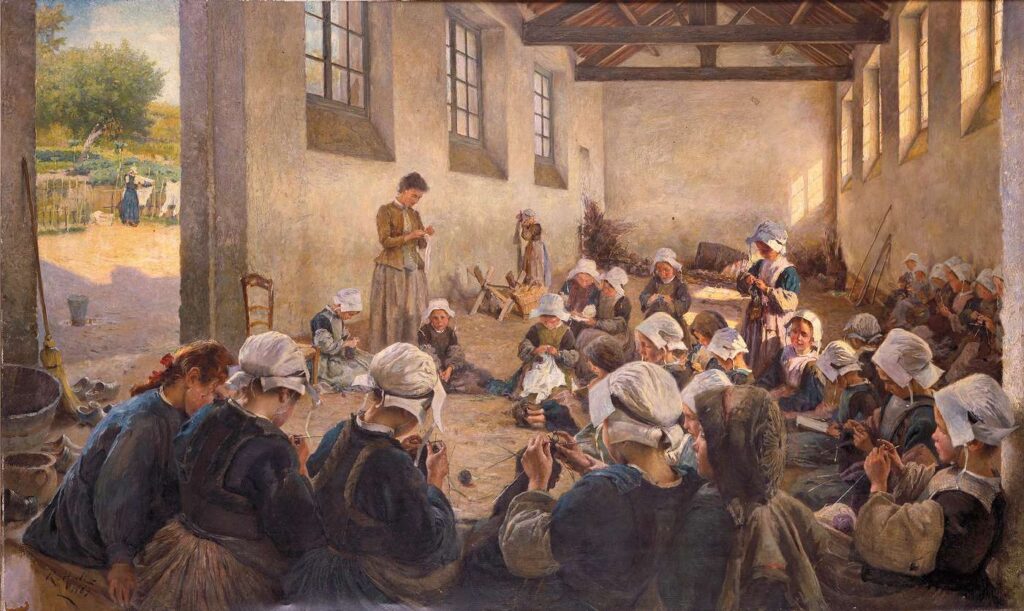
These are mainly boys’ schools. There are a few girls’ schools and evening classes for adults. They mainly catered for the children of small craftsmen: dyers, octroi clerks, innkeepers, foremen, tailors, millers, dressmakers, coopers, dressmakers, locksmiths, butchers, spinners, ironers, laborers, car loaders, carpenters, booksellers, lamplighters, cutlers, bookbinders and so on.
At its peak, in 1821, mutual education in the Somme department included not one but 25 schools, 4 of them for girls (for a fee): 4 out of 10 were located in towns. In 1833, there were 16 more. The network shrank considerably thereafter, but did not disappear altogether. The last two schools in Amiens closed their doors involuntarily in 1879, and the one in Abbeville in 1880: until then, it played an important role in preparing candidates for examinations.
The Amiens Model School – the first provincial model school – prepares future teachers for the practice of mutual education. It was founded on May 26, 1817. It welcomed over 200 pupils. By 1818, 6 teachers from the Somme had graduated. Most of the teachers from the Aisne, Oise and Pas-de-Calais departments spent some time there before taking up their duties.
In 1831, when the Prefect created the Ecole normale de garçons, it was called the « Ecole normale primaire d’enseignement mutuel ». At first, it served as a training school: student teachers were required to visit the school once a week to observe and practice the mutual teaching method.

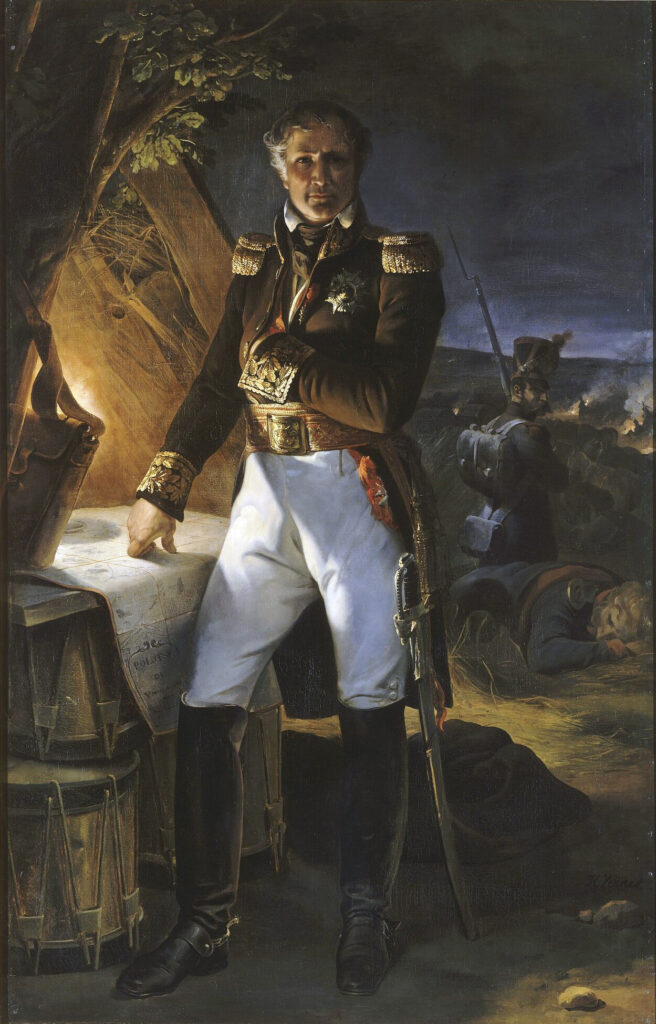

After the government reshuffles of 1817-1818, several SIE members were appointed to important ministries: Mathieu Molé (1778-1838) to the Navy, Laurent Gouvion-Saint-Cyr (1764-1830) to the War, Elie Decazes (1780-1860) above all to the Interior, the ministry on which primary education depended. Government support became systematic.
The Minister of the Interior supported the SIE de Paris and its subsidiaries with grants for school foundations and maintenance. He invited the prefects to contribute in any way they could to the development of the method. Prefects took the initiative in setting up local companies, and lobbied local assemblies for subsidies.
A growing number of General and Municipal Councils voted to set up mutual schools. Once a school had been founded, the local authorities (prefect and mayor) visited it and presided over the prize-giving ceremony. For its part, on July 22, 1817, the Commission d’Instruction Publique, which since 1815 had replaced the Grand Master of the University, decided to establish a model mutual-education school in the chief towns of France’s twelve Academies, as a breeding ground for future teachers. Other ministers, each in their own sphere, supported the method.
Molé, in charge of the colonies, founded mutual tuition schools in Senegal.
In 1818, Gouvion-Saint-Cyr established a full-fledged « Ecole normale militaire d’enseignement mutuel » in the caserne Babylone of Paris. Each regiment in Paris and the provinces was required to send one officer and one non-commissioned officer, who would return after a few months’ training to teach the troops the benefits of primary education.
In 1817-1818, mutual tuition triumphed. An irresistible enthusiasm carried France towards it. The network of schools continued to expand. From term to term, more and more reports arrived in Paris from the provinces, counting schools and their pupils.
It was a song of victory that Jomard could sing at the SIE meeting in January 1819. Of the 81 départements in France, only 5 had no mutual school; the other 76 had 687 schools, attended by over 40,000 pupils. There were also 105 regimental schools, 5 adult schools, 4 prison schools and 2 or 3 schools in Senegal.

Exemplifying what was becoming a new Promethean paradigm of scientific optimism, on December 15, 1821, at a meeting at Paris City Hall, the Geographical Society was founded by 217 leading figures, including some of the greatest scientists of the day, such as Jomard, Champollion, Cuvier, Chaptal, Denon, Fourier, Gay Lussac, Berthollet, von Humboldt and Chateaubriand. Other illustrious members include Jean-Baptiste Charcot, Dumont d’Urville, Élisée Reclus and Jules Verne.
The collection and study of geographical data from many continents enabled certain members, such as Gustave Eiffel and Ferdinand de Lesseps, to propose major infrastructure projects, notably the Suez and Panama Canals.
15. Criticism
The first criticisms of mutual education came not from its failure, but from its success. The first « risk » was that the children, having learned too effectively and too quickly (2 to 3 times faster !), would return « to the streets » too soon, not yet being old enough to go to work!
Children weren’t « locked up » at school long enough, and so mutual education disturbed the existing social order. In 1818, the General Council of Calvados heard:
« The greatest service to be rendered to society would perhaps be to devise a method that would make instruction for the lower and indigent classes of society more difficult and time-consuming »…
The second « risk » was that, by continuing to use mutual education, these newly-educated people, mostly from the poorer classes, would become too intelligent, too « enlightened », and begin to express political or social demands, in particular that everyone should have the same rights as the better-off social classes.
Imagine the mess if the social order were challenged! French urban planner and sociologist Anne Querrien notes that, in fact, most of the organizers of the labor movement at the time came from the mutual school, where they had of course learned to read, write and count, but also to trust themselves and their comrades. The mutual school encouraged its pupils to think, and in particular to reflect on the organization of society, a society that assigned them a destiny of submission and obedience.


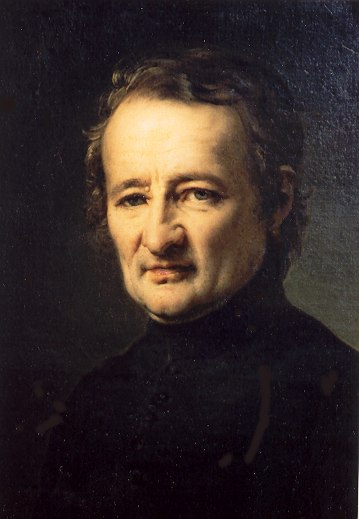
The influential theologian and politician Félicité Robert de Lamennais (1782-1854) said it loud and clearly :
« Lancaster-style schools are the craze of the day. All the authorities in this country, and especially the Prefect, are infatuated beyond expression. Hatred for priests has a lot to do with this mania. The fact is that everything good about this method has been practiced for over a century by the Brothers of the Christian Schools; the rest is pure charlatanism. There is talk of teaching children to read and write in four months: in the first place, this would be a great misfortune, for what can be done with such well-educated children, whose age would not yet allow them to work? Secondly, nothing could be further from the truth than these marvellous results. »
If one has « to decide between the instruction of Abbé de La Salle and that of Lancaster, the question is quite simple; it’s a question of choosing between society and anarchy ».
His brother, the vicar Jean-Marie de la Mennais (1780-1860), took the lead in what can only be described as a political witch-hunt. He said:
« Mutual education was introduced into France by Protestants during the disastrous Hundred Days. M. Carnot was then Minister of the Interior; under his auspices, the Société d’Encouragement, established to propagate this method, held its first meeting on May 16, 1815 ».
He struggled to prove that « the Lancastrian method is defective in its procedures, dangerous for religion and morals in its results » and in a brochure, De l’Enseignement mutuel, published in 1819 in Saint-Brieuc, Brittany, he vigorously attacked this teaching method.
It’s true that questioning authority and the established order is inherent to mutual education. The « simultaneous » method is based on the premise that to pass on knowledge, you need to be qualified (to be the teacher). Conversely, in the mutual school, the teacher is no longer the repository of knowledge, as each student can enlighten his or her classmates.
Another concern for the elites was that, with this method, children are merely instructed, not « educated », and no Christian moral education is imparted.
Last but not least, mutual teaching required fewer supervisors, given the pupils’ role as creators, transmitters and bearers of knowledge. Some may have feared for their jobs…

In 1818, in his report to the Emperor of Russia, Joseph Hamel told the mutualists’ main opponents, the « Brothers of the Christian Schools », that they were almost entirely unaware of what they were denouncing. Hamel also points out that there are 40,000 communes to be provided with elementary school, and that the number of Brothers‘ schools « does not amount to more than one hundred in the kingdom… ».
On the negative side, what is striking, when examining the incriminations, is that one thing is said in the morning and its opposite in the afternoon. In the morning, it’s said that mutual education blurs minds by diluting the authority of teachers; in the afternoon, it’s asserted that it overly « militarizes » education through a totally hierarchical command structure!
On the question of « morality », Lazare Carnot would never have endorsed an education that ruined the Christian spirit, let alone the notion of legitimate authority, while vigorously combating those that lacked it, such as the Monarchy of divine right or the Consulate for life imposed by Napoleon. In the same way, in the morning, the mutualist system was accused of failing to transmit Christian « morals »; in the afternoon, it was seen as a Protestant plot…
And yet, the national impulse in favor of « the fatherland » and future generations has succeeded in uniting personalities from all political and religious backgrounds in a single effort.
Cuvier (Protestant) and Gérando (Catholic), both fervent republicans and promoters of the mutual mode, as well as the Inspector General of the University, Ambroise Rendu (1778-1860, Catholic), even took part in drafting the ordinance of February 29, 1816, promulgated by Louis XVIII and the Minister of the Interior, de Vaublanc (1756-1845).
Following massive pressure from the congregations, mutualist teachers Martin, Frossard and Bellot, all Protestants, were forced to leave their school headships. Martin went on to be very useful in other European countries, notably Brussels, where in 1820 he organized a mutual school at Les Minimes.
16. Mechanistic drift?

Without grasping the state of mind and enthusiasm that young polytechnicians might have had for the blossoming of an industrial culture and the wonders of machinismo, the defenders of a feudal France see only a « fundamentally mechanistic vision », when Jomard compares the mutual method to a machine, with its cogs and springs, of which the teacher is a mere operator:
« Once the school has been establisehd out and equipped with all the furniture it needs, all that remains to be done is to introduce the pupils and the teacher, and then to set in motion all the springs of this kind of mechanism, by means of the new practices ».
While Victor Hugo evoked a « happy swarm », Laborde was accused of a « mechanistic » drift when he compared the buzzing activity of pupils in English mutual schools to the noise of machines in cotton mills.
Communication, argued critiques, is « entirely mechanical and hierarchical ». It flows « only from the master or general instructor to the instructors and pupils, not in the other direction. It’s a means of action, not a means of exchange.«
Let’s face it, any pedagogical approach, no matter which one, set up as a system and postulating that it’s « enough » to apply mechanically to a human being, can be horrifying. It’s easy, then, to accuse the mutual school of all the ills from which those who accused them suffered, perhaps even more so.
At the mutual school, corporal punishment is banned. It was a courageous decision that Octave Greard was quick to point out:
« It is one of the claims of the founders of the mutual schools to public recognition that they outlawed the corporal punishments, ferulas and whips, which were still in use, and we cannot be too grateful to them for having sought to replace in the hearts of pupils the feeling of fear with the feeling of honor, or, as M. de Laborde used to say, the feeling of well-administered shame ».
Knowing the immense happiness of the thousands of children who quickly gained access to a minimum of public instruction and experienced the indescribable joy of educating their peers, one can only suspect the pen of jealous congregations behind this poem falsely lamenting the misfortune of the poor little ones:
« This system, it is said, born of Anglomania,
Contrasts horribly with our genius.
There, everything is mechanism and our sad children
Seem like a machine, in the middle of their benches;
Their absurd discipline, and no doubt fatal,
Governs even the steps, the attitude or the gesture:
Today, we can prophesy the fate
Of this automaton people thus moved by spring ».
17. Death of Mutual Tuition in France
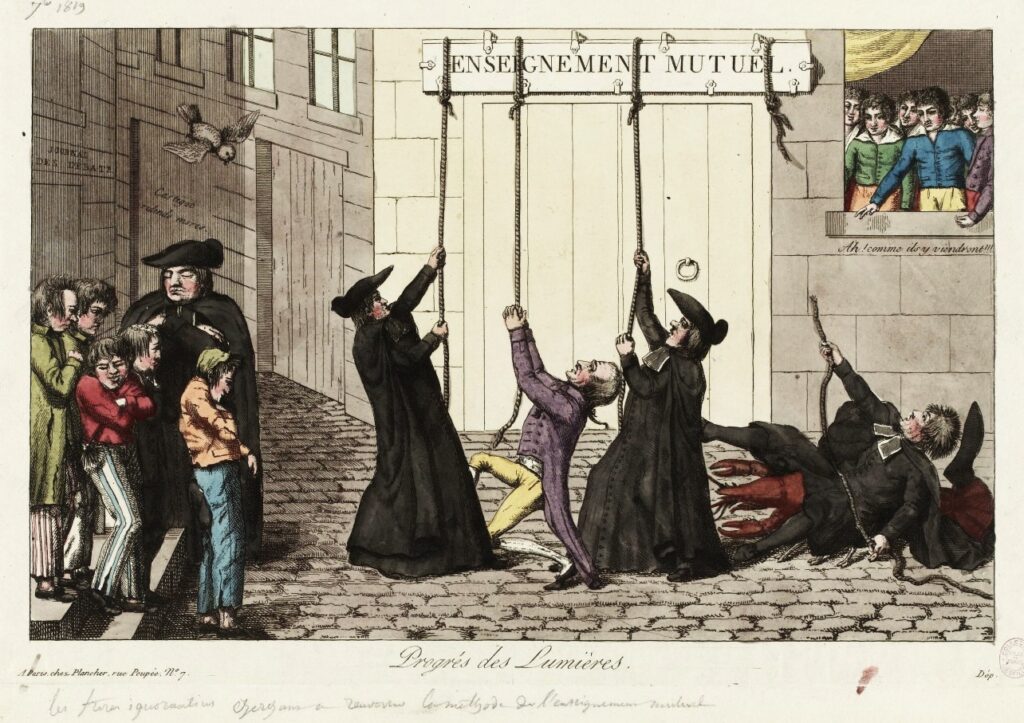
In 1815, after Waterloo, King Louis XVIII, who had fled, returned on July 8, 1815. Unlike his brother, the future Charles X, leader of the ultra-royalists, was fully aware that the history of the Revolution could not be erased. He realized that France could no longer be a country of « subjects », and that it had become a Nation. Hence the « Constitutional Charter » he promulgated, which had the force of a constitution. In the same spirit, in view of the popularity of mutual education, he granted it favors (subsidies, creation of model schools, protection from the Ministry of the Interior).
Mutual education soon lost its protectors, as the ministerial commission created by the decree of April 27 did not survive Napoleon’s fall in June 1815.
By the autumn of 1816, criticism was pouring in from the Congregationalists. The Grand Chaplain of France, Cardinal de Talleyrand-Périgord, Archbishop of Reims (John Baptist de La Salle’s birthplace…), for his part, addressed the King to express the alarm of Catholics.
By 1820, the SIE already had a network of 1,500 mutual schools, grouping together more than 170,000 pupils thanks to an audacious collective pedagogy. However, mutualism came under fire from the ultras, who considered it too liberal, too favorable to children’s autonomy and incapable of « raising youth in religious and monarchical sentiments ».
The child who leaves this school, they say, « is a learned parrot, without religious ideas, without moral values, more dangerous than the ignorant for the political and social order, since instruction has developed new needs in him, always ready to engage in new scenes of revolution or dechristianization. Ah, Carnot, the regicidal conventionalist and patron of mutual education, knew what he was up to when he introduced it into France with the decree of 1815! »

As said earlier, in France, mutual tuition was seen as an aggression by the religious congregations who practiced « simultaneous teaching », codified as early as 1684 by Jean-Baptiste de La Salle (1651-1719) for Institute of the Brothers of the Christian Schools (Latin : Fratres Scholarum Christianarum; French Frères des Écoles Chrétiennes; Italian: Fratelli delle Scuole Cristiane, abbreviated FSC) : classes by age, division by level, fixed and individual places, strict discipline, repetitive and simultaneous work supervised by an inflexible master.
And the merits of the FSC’s schools and « simultaneous teaching », confirmed by centuries of experience, were considered in total opposition to those of mutual education, the « mania of the moment », and considered the work of « charlatans » speculating on primary education.
A fierce supporter of order and suspecting a vast Protestant plot against the Vatican, Pope Leo XII, the « Pope of the Holy Alliance », decided in Quod Divina Sapientia, his papal bull of August 28, 1824 (art. XXVII, 299), that « public schools of mutual instruction will be suppressed and abolished in all the Papal States. The bishops will prosecute those who continue to use this teaching method or who attempt to introduce it into their dioceses ».
In anticipation of the Papal Bull, the Ordinance of April 1824 placed mutual education in France under the strict supervision of the traditional Church, which took over the entire educational question. In August, just after Leo XII’s bull, a Ministry of « Ecclesiastical Affairs and Public Instruction » was created, a name that reflected the Church’s return to business. The accession of Charles X only exacerbated this situation. The Church of the time loved the Enlightenment, but above all it loved candlelight…

From then on, the schooling situation took a dramatic turn for the worse.
In 1828, of the 39,381 communes :
- around 24,000 had boys’ schools, catering for 1,070,000 children ;
- no more than 430,000 girls attended elementary school;
- 15,381 communes have no boys’ schools ;
- and perhaps 20,000 without girls’ schools;
- 1,680,000 boys and 2,320,000 girls attend no school at all, making a total of 4 million.
Despite an upturn between 1828 and 1829, mutuellism was rejected, its schools closed one after the other (their number fell by three-quarters compared to 1820), although the electoral weight of the ultras diminished from election to election. However, the people’s educators resisted.
In the years following the 1830 revolution, over 2,000 mutual schools were still in operation, mainly in towns, in competition with the denominational schools promoted by the regime. Officially, the mutual school was not a guarantor of morality, and was said to be « industrial » and inhumane.

Then came the famous « Guizot moment ». Although he had initially campaigned for the development of mutual education within the SIE, François Guizot (1787-1874), Louis-Philippe’s Minister of Public Instruction from 1832 onwards, gave mutual education the coup de grâce in France by having the « simultaneous » method endorsed as the only official teaching method.
Schools adopting mutual tuition were no longer subsidized, nor did they receive any support from the government or the Church. Faced with material difficulties, the majority of pupils mostly admitted free of charge had now to pay a fee. Many parents in need withdrew their children and sent them to the newly opened Brother of the Christian Schools, who had become free of charge…
The Church slanders, casts doubt on the morality of the teachers, tried to keep the children of Catholic families away from the « devil’s school », persecutes and threatens to keep them away from catechism and communion in order to break mutual tuition. Most of the teachers using that method felt obliged to bandon it and embrace the official « simultanous » method. With no more pupils, no more teachers, mutual schools gradually disappeared.
It was Guizot who put the final nail in the coffin of mutual tuition, creating the École normale des instituteurs in 1867 to train the future teachers of Jules Ferry’s school in the simultaneous method still the norm today.
The young Hippolyte Carnot also joined the SIE in order to reconnect, post mortem, with his father. In 1847, when he became Minister of Public Instruction under the Second Republic, he attempted to revive the mutual education cherished by his father Lazare Carnot, but although his work was great, his enemies were many and his term of office very short.
18. Conclusion
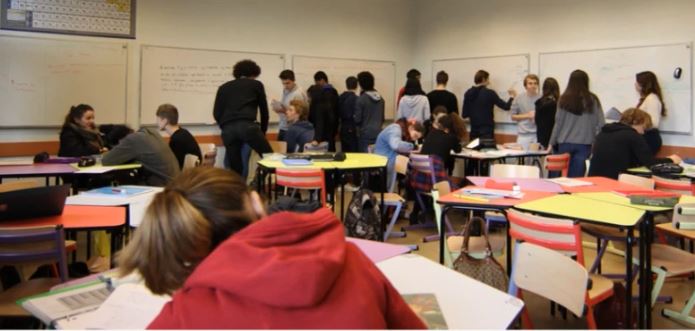
Education is in deep crisis. Everything that was largely accomplished by Lazare Carnot and his son Hippolyte has been systematically destroyed by the new church of our time: the financial, transhumanist and decadent oligarchy, having led the world to the brink of collapse, still determined to save its privileges by organizing the physical and moral ruin of humanity.
To rebuild an education worthy of the name, we are convinced that mutual education, provided it is adapted to our times, is an extremely promising avenue. Several African countries, currently lacking sufficient resources, are already taking inspiration from it.
Mutual tuition is not a relic of the past, but an experiment to be renewed to open the gates of the futur. For the Global South, still plagued by post-colonial exploitation, war and epidemics, education of this kind is the way to go: efficient, rapid and cheap but also humanizing and joyfull, it is the way to go.
It’s a message that Vincent Faillet, a young french teacher with a doctorate in education and training in the Paris region, who is reviving this method, cleary expresses in this video:
19. Short list of works consulted
- François Arago, Biography of Gaspard Monge, read at the Académie des Sciences, 1846.
- Joseph Hamel, L’enseignement mutuel, 1818, Paris.
- John Franklin Reigart, The Lancastrian System of Instruction in the schools of New York City, Teachers College, Columbia University, 1916.
- Sylviane Tinembart, Edward Pahud, Une innovation pédagogique, le cas de l’enseignement mutuel au XIXe siècle. Editions Livreo-Alphil, 2019, Neuchâtel, Switzerland;
- Bruno Poucet, Petite histoire de l’enseignement mutuel : l’exemple du département de la Somme, Carrefours de l’éducation, N° 27, 2009/1, pages 7 to 18;
- Michel Chalopin, L’enseignement mutuel en Bretagne, Presses Universitaires de Rennes, 2011;
- Claire Giordanengo, La grande vogue de l’enseignement mutuel, Hypotheses, Bibliothèque Diderot de Lyon;
- M. Gontard, Un aspect des luttes de partis en France au début de la Restauration : la question de l’enseignement mutuel, Revue d’Histoire du XIXe siècle – 1849, Année 1953, pp. 48-63.
- Dell Upton, Lancasterian Schools, Republican Citizenship, and the Spatial Imagination in Early Nineteenth-Century America, Journal of the Society of Architectural Historians, Vol. 55, No. 3 (Sep., 1996), pp. 238-253,University of California Press;
- Alexis de Garaudé, Manuel de l’enseignement mutuel et populaire de la musique, 1854;
- Anne Querrien, L’école mutuelle – Une pédagogie trop efficace?, Les Empêcheurs De Penser En Rond, 2005.
- René Girard, Carnot et l’éducation populaire pendant les Cents Jours, 1907, Paris.
- Michael Werner, Musique et pacification sociale, missions fondatrices de l’éducation musicale (1795-1860) « , Gradhiva (N° 31/2020);
- Rémi Dalisson, Hippolyte Carnot – 1801-1888, La liberté, l’école et la République, CNRS, Paris, 2019;
- Renaud d’Enfert, Jomard, Francœur et les autres… Des polytechniciens engagés dans le développement de l’instruction élémentaire (1815-1850), Bulletin de la Société des amis de la Bibliothèque et de l’Histoire de l’École polytechnique (SABIX), 2014.
With Kondiaronk and Leibniz, re-inventing a society without oligarchy
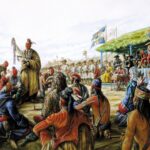

By Karel Vereycken, May 2023.
Helga Zepp-LaRouche, the founder of the Schiller Institute, in her keynote address to the Schiller Institute’s Nov. 22, 2022 videoconference, “For World Peace—Stop the Danger of Nuclear War: Third Seminar of Political and Social Leaders of the World,” called on world leaders to eradicate the evil principle of oligarchy.
Oligarchy is defined as a power structure in which power rests with a small number of people having certain characteristics (nobility, fame, wealth, education, or corporate, religious, political, or military control) and who impose their own power over that of their people.
To be precise, Zepp-LaRouche said :
“For 600 years, there has been a continuous battle between two forms of government, between the sovereign nation state and the oligarchical form of society, vacillating back and forth with sometimes a greater emphasis in this or that direction.
All empires based on the oligarchical model have been oriented towards protecting the privileges of the ruling elite, while trying to keep the masses of the population as backward as possible,
because as sheep they are easier to control (…)”
Now, unfortunately, most of the citizens of the transatlantic world and elsewhere will tell you that abolishing the oligarchical principle is “a good idea”, a “beautiful dream”, but that reality tells us “it can’t happen” for the very simple reason that “it never happened before”.
Societies, by definition, they argue, are in-egalitarian. Kings and Presidents of Republics, they argue, eventually might have “pretended” they ruled over the masses for their “common good”, but in reality, our fellow-citizens think, it was always the rule of a handful favoring their own interest over the majority.
The BRICS
Interesting for all of us, is that some leading thinkers involved in the BRICS movement, are trying to imagine new ways of collective rule excluding oligarchical principles.
For example, going in that direction, economist Pedro Paez, former advisor to Ecuador’s Rafael Correa, in his intervention at the April 15-16 Schiller Institute’s video conference, defended
“a new concept of currency based on monetary arrangements of clearing houses for regional payments, that can be joined into a world clearing house system, which could also prevent another type of unilateral, unipolar hegemony from arising, such as the one that was established with Bretton Woods, and that would instead open the doors to multipolar management”.
Also Belgian philosopher and theologian Marc Luyckx, a former member of the Jacques Delors famous taskforce « Cellule de Prospective » of the European Commission, in a video interview on the de-dollarization of the world economy, underlined that the BRICS countries are creating a world order whose nature makes it so that not a single member of their own group can become the dominant power.
The Dawn of Everything
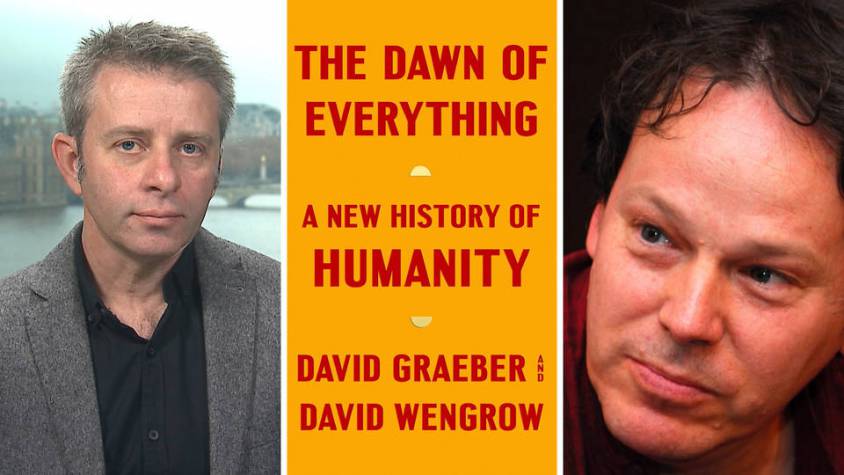
The good news is that a mind-provoking, 700-page book, titled “The Dawn of Everything: A New History of Humanity”, written and published in 2021 by the American anthropologist David Graeber and the British archaeologist David Wengrow, destroys the conventional notions of ancient human cultures making linear progress toward the neo-liberal economic model and therefore, by implication, high levels of inequality.
Even better, based on hard facts, the book largely debunks the “narrative” that oligarchical rule is somehow “natural”. Of course, the oligarchical principle ruled often and often for a long time. But, surprisingly, the book offers overwhelming indications and “hard facts” proving that in ancient times, some societies, though not all, which eventually prospered over centuries, through political choices, consciously adopted modes of governance preventing minority groups from permanently keeping a hegemonic grip over societies.
Zepp-LaRouche’s 10th point

The subject matter of this issue is intimately linked to the 10th point raised by Helga Zepp-LaRouche, which, in order to demonstrate that all sources of evil can be eradicated by education and political decision, that man’s natural inclination, is intrinsically to do the good. The very existence of historical precedents of societies surviving without oligarchy over hundreds of years, is of course, the “practical” proof of man’s axiomatic inclination to do the good.
Unsurprisingly, some argue that the issue of “good” and “evil” is nothing but a “theological debate”, since the concepts of “good” and “evil” are concepts made up by humans in order to compare themselves with one another. They argue it would never occur to anyone to argue about whether a fish, or a tree, were good or evil, since they lack any form of self-conscience enabling them to measure if their deeds and actions fulfill their own inclination or that of their creator.
Now, part of the “Biblical answer” to this question, if man is bad or evil, claims that people “once lived in a state of innocence”, yet were tainted by original sin. We desired to be godlike and have been punished for it; now we live in a fallen state while hoping for future redemption.
Overturning the evil Rousseau and Hobbes
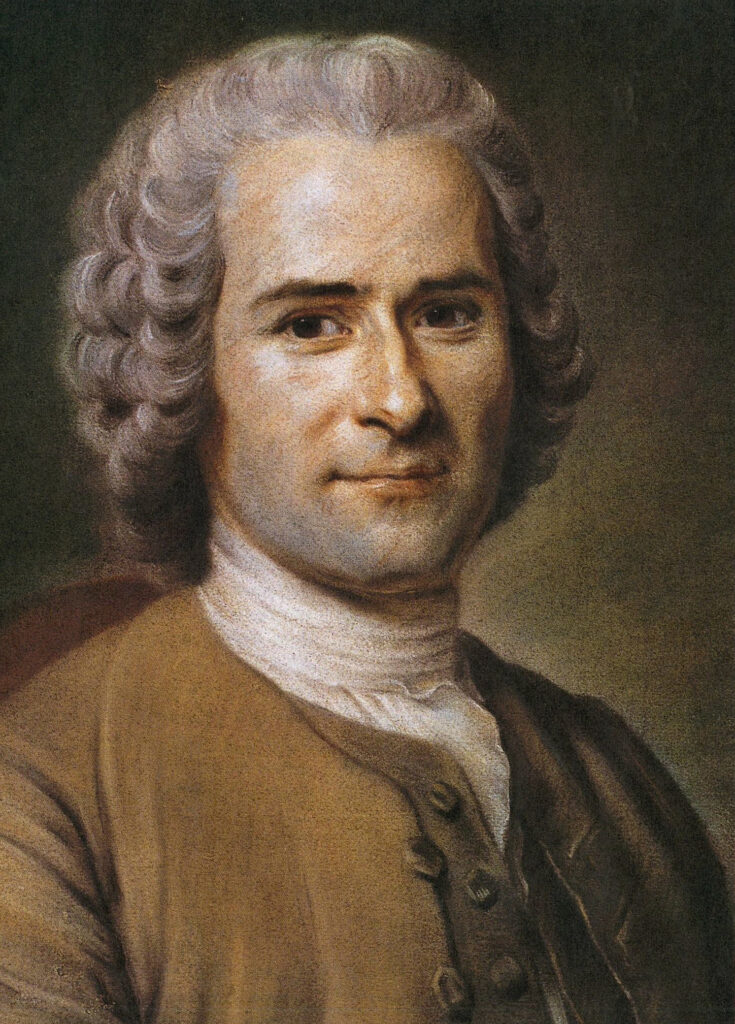
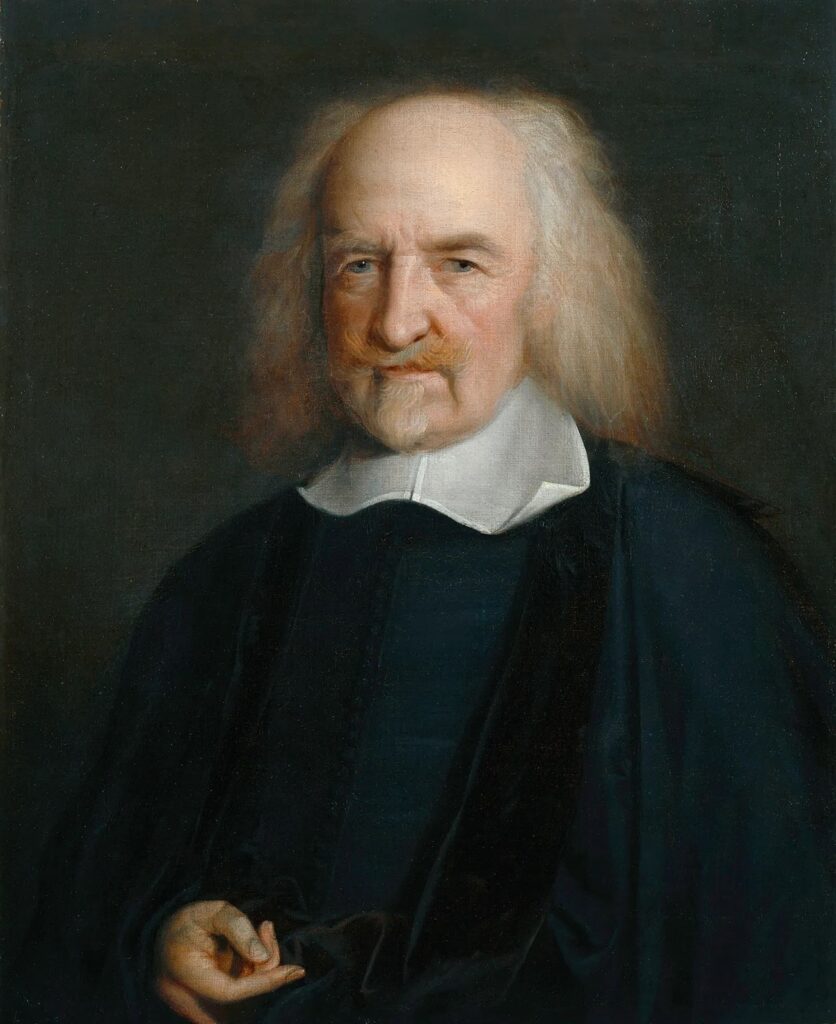
Graeber and Wengrow, establishing the core argument of their entire book, demonstrate in a very provocative way how we got brainwashed by the pessimistic and destructive oligarchical ideology, especially that promoted by both Rousseau and Hobbes, for whom inequality is the natural state of man, a humanity which might have eventually been good as “a noble savage”, before becoming “civilized” and a society only surviving thanks to a “social contract” (voluntary bottom-up submission) or a “Leviathan” (top down dictatorship) :
“Today, the popular version of this [biblical] story [of man thrown out of the Garden of Eden] is typically some updated variation on Jean-Jacques Rousseau’s Discourse on the Origin and the Foundation of Inequality Among Mankind, which he wrote in 1754. Once upon a time, the story goes, we were hunter-gatherers, living in a prolonged state of childlike innocence, in tiny bands. These bands were egalitarian; they could be for the very reason that they were so small. It was only after the “Agricultural Revolution,” and then still more the rise of cities, that this happy condition came to an end, ushering in ‘civilization’ and ‘the state’—which also meant the appearance of written literature, science and philosophy, but at the same time, almost everything bad in human life: patriarchy, standing armies, mass executions and annoying bureaucrats demanding that we spend much of our lives filling in forms.
“Of course, this is a very crude simplification, but it really does seem to be the foundational story that rises to the surface whenever anyone, from industrial psychologists to revolutionary theorists, says something like ‘but of course human beings spent most of their evolutionary history living in groups of ten or twenty people,’ or ‘agriculture was perhaps humanity’s worst mistake.’ And as we’ll see, many popular writers make the argument quite explicitly. The problem is that anyone seeking an alternative to this rather depressing view of history will quickly find that the only one on offer is actually even worse: if not Rousseau, then Thomas Hobbes.
“Hobbes’s Leviathan, published in 1651, is in many ways the founding text of modern political theory. It held that, humans being the selfish creatures they are, life in an original State of Nature was in no sense innocent; it must instead have been ‘solitary, poor, nasty, brutish, and short’—basically, a state of war, with everybody fighting against everybody else. Insofar as there has been any progress from this benighted state of affairs, a Hobbesian would argue, it has been largely due to exactly those repressive mechanisms that Rousseau was complaining about: governments, courts, bureaucracies, police. This view of things has been around for a very long time as well. There’s a reason why, in English, the words ‘politics’ ‘polite’ and ‘police’ all sound the same—they’re all derived from the Greek word polis, or city, the Latin equivalent of which is civitas, which also gives us ‘civility,’ ‘civic’ and a certain modern understanding of ‘civilization.
“Human society, in this view, is founded on the collective repression of our baser instincts, which becomes all the more necessary when humans are living in large numbers in the same place. The modern-day Hobbesian, then, would argue that, yes, we did live most of our evolutionary history in tiny bands, who could get along mainly because they shared a common interest in the survival of their offspring (‘parental investment,’ as evolutionary biologists call it). But even these were in no sense founded on equality. There was always, in this version, some ‘alpha-male’ leader. Hierarchy and domination, and cynical self-interest, have always been the basis of human society. It’s just that, collectively, we have learned it’s to our advantage to prioritize our long-term interests over our short-term instincts; or, better, to create laws that force us to confine our worst impulses to socially useful areas like the economy, while forbidding them everywhere else
“As the reader can probably detect from our tone, we don’t much like the choice between these two alternatives. Our objections can be classified into three broad categories. As accounts of the general course of human history, they:
1) simply aren’t true;
2) have dire political implications and
3) make the past needlessly dull.”
As a consequence of the victory of imperial models of political power, the only accepted “narrative” of man’s “evolution”, automatically validating an oligarchical grip over society, is that which allows “confirming” the pre-agreed-upon dogma erected as immortal “truth”. And any historical findings or artifacts contradicting or invalidating the Rousseau-Hobbes narrative will be, at best, declared anomalies.
Open our eyes
Graeber and Wengrow’s book is an attempt
“to tell another, more hopeful and more interesting story; one which, at the same time, takes better account of what the last few decades of research have taught us. Partly, this is a matter of bringing together evidence that has accumulated in archaeology, anthropology and kindred disciplines; evidence that points towards a completely new account of how human societies developed over roughly the last 30,000 years. Almost all of this research goes against the familiar narrative, but too often the most remarkable discoveries remain confined to the work of specialists, or have to be teased out by reading between the lines of scientific publications.”
To give just a sense of how different the emerging picture is:
“[I]t is clear now that human societies before the advent of farming were not confined to small, egalitarian bands. On the contrary, the world of hunter-gatherers as it existed before the coming of agriculture was one of bold social experiments, resembling a carnival parade of political forms, far more than it does the drab abstractions of evolutionary theory. Agriculture, in turn, did not mean the inception of private property, nor did it mark an irreversible step towards inequality. In fact, many of the first farming communities were relatively free of ranks and hierarchies. And far from setting class differences in stone, a surprising number of the world’s earliest cities were organized on robustly egalitarian lines, with no need for authoritarian rulers,
ambitious warrior-politicians, or even bossy administrators.”
Kondiaronk, Leibniz and the Enlightenment


In fact, Rousseau’s story, argue the authors, was in part a response to critiques of European civilization, which began in the early decades of the 18th century. “The origins of that critique, however, lie not with the philosophers of the Enlightenment (much though they initially admired and imitated it), but with indigenous commentators and observers of European society, such as the Native American (Huron-Wendat) statesman Kondiaronk,” and many others.
And when prominent thinkers, such as Leibniz, “urged his patriots to adopt Chinese models of statecraft, there is a tendency for contemporary historians to insist they weren’t really serious”.
However, many influential Enlightenment thinkers did in fact claim that some of their ideas on the subject of inequality were directly taken from Chinese or Native American sources!
Just as Leibniz became familiar with Chinese civilization through his contact with the Jesuit missions, the ideas from Native Americans reached Europe by way of books such as the widely read seventy-one-volume report The Jesuit Relations, published between 1633 and 1673.
While today, we would think personal freedom is a good thing, this was not the case for the Jesuits complaining about the Native Americans. The Jesuits were opposed to freedom in principle:
“This, without doubt, is a disposition quite contrary to the spirit of the Faith, which requires us to submit not only our wills, but our minds, our judgments, and all the sentiments of man
to a power unknown to the laws and sentiments of corrupt nature.”
Jesuit father Jérôme Lallemant, whose correspondence provided an initial model for The Jesuit Relations, noted of the Wendat Indians in 1644: “I do not believe that there is a people on earth freer than they, and less able to allow to the subjection of their wills to any power whatever”.

Even more worrisome, their high level of intelligence. Father Paul Le Jeune, Superior of the Jesuits in Canada in the 1630:
“There are almost none of them incapable of conversing or reasoning very well, and in good terms, on matters within their knowledge. The councils, held almost every day in the Villages, and on almost all matters, improve their capacity for talking”.
Or in Lallemant’s words:
“I can say in truth that, as regards intelligence, they are in no ways inferior to Europeans and to those who dwell in France. I would never have believed that, without instruction, nature could have supplied a most ready and vigorous eloquence, which I have admired in many Hurons (American Natives); or more clear-nearsightedness in public affairs, or a more discreet management in things to which they are accustomed”.
(The Jesuit Relations, vol. XXVIII, p. 62.)
Some Jesuits went much further, noting – not without a trace of frustration – that New World “savages” seemed rather cleverer overall than the people they were used to dealing with at home.
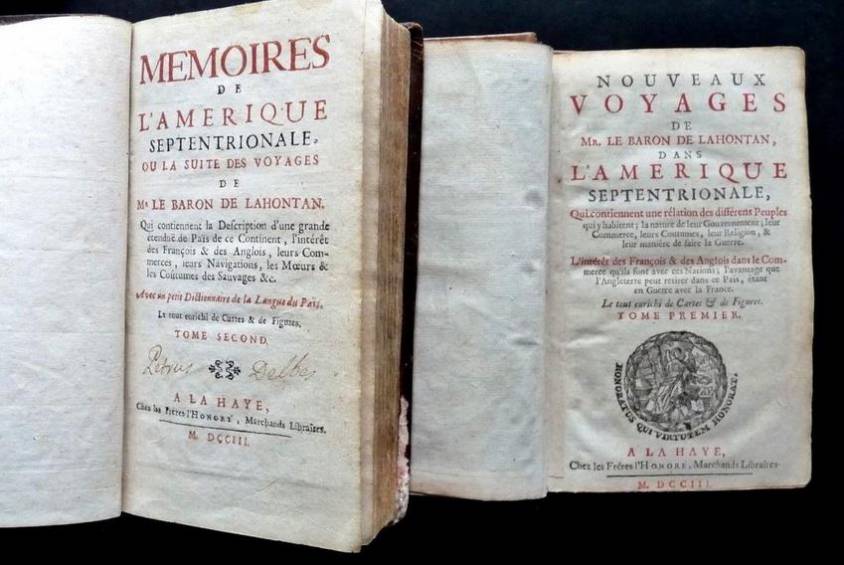
The ideas of Native Indian statesman Kondiaronk (c. 1649–1701), known as “The Rat” and the Chief of the Native American Wendat people at Michilimackinac in New France, reached Leibniz via an impoverished French aristocrat named Louis-Armand de Lom d’Arce, Baron de la Hontan, better known as Lahontan.
In 1683, Lahontan, age 17, joined the French army and was posted in Canada. In his various missions, he became fluent in both Algonkian and Wendat and good friends with a number of indigenous political figures, including the brilliant Wendat statesman Kondiaronk. The latter impressed many French observers with his eloquence and brilliance and frequently met with the royal governor, Count Louis de Buade de Frontenac. Kondiaronk himself, as Speaker of the Council (their governing body) of the Wendat Confederation, is thought to have been sent as an ambassador to the Court of the French King, Louis XIV, in 1691.
The Great Peace of Montreal


Even after being betrayed by the French, and obliged to conduct his own wars to secure his fellow men, Kondiaronk, played a key role in what is remembered as the “Great Peace of Montreal” of August 1, 1701, which ended the bloody Beaver Wars, in reality proxy wars between the British and the French, each of them using the native Indians as “cannon fodder” for their own geopolitical schemes
France was increasingly cornered by the British. Therefore, at the request of the French, in the summer of 1701, more than 1,300 Indians, from forty different nations, gathered near Montreal, dispite the fact that the city was ravaged by influenza. They came from the Mississippi Valley, the Great Lakes, and Acadia. Many were lifelong enemies, but all had responded to an invitation from the French governor. Their future and the fate of the colony were at stake. Their goal was to negotiate a comprehensive peace, among themselves and with the French. The negotiations dragged on for days, and peace was far from being guaranteed. The chiefs were wary. The main stumbling block to peace was the return of prisoners who had been captured during previous campaigns and enslaved or adopted.
Without Kondiaronk’s support, peace was unattainable. On August 1, seriously ill, he spoke for two hours in favor of a peace treaty that would be guaranteed by the French. Many were moved by his speech. The following night, Kondiaronk died, struck down by influenza at the age of 52.
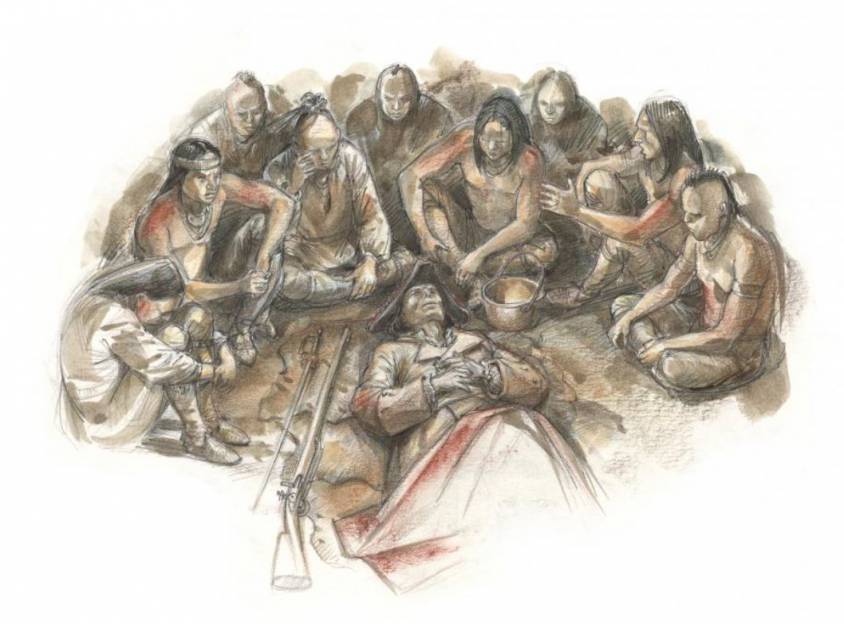
But the next day, the peace treaty was signed. From now on there would be no more wars between the French and the Indians. Thirty-eight nations signed the treaty, including the Iroquois. The Iroquois promised to remain neutral in any future conflict between the French and the Iroquois’ former allies, the English colonists of New England.
Kondiaronk was praised by the French and presented as a “model” of peace-loving natives. The Jesuits immediately put out the lie that, just before dying, he had “converted” to the Catholic faith in the hope other natives would follow his model.
Lahontan from Amsterdam to Hanover

Now, following various events, Lahontan ended up in Amsterdam. In order to make a living he wrote a series of books about his adventures in Canada, the third one entitled Curious Dialogues with a Savage of Good Sense Who Has Travelled (1703), comprising four dialogues with a fictional figure, “Adario” (in reality Kondiaronk), which were rapidly translated into German, Dutch, English, and Italian. Lahontan, himself, gaining some sort of celebrity, settled in Hannover, where he befriended the great philosopher and scientist Wilhelm Gottfried Leibniz.
On the lookout for everything that was being discussed in Europe, the philosopher, then 64 years old, seems to have been put on the track of Lahontan by Dutch and German journalists, but also by the text of an obscure theologian from Helmstedt, Conrad Schramm, whose introductory lecture, the « The Stammering Philosophy of the Canadians », had been published in Latin in 1707. Referring first to Plato and Aristotle (which he abandoned almost immediately), Schramm used the Dialogues and the Memoirs of Lahontan to show how the « Canadian barbarians knock on the door of philosophy but do not enter because they lack the means or are locked into their customs”.

Far less narrow-minded, Leibniz saw in Lahontan a confirmation of his own political optimism, which allowed him to affirm that the birth of society does not come from the need to get out of a terrible state of war, as Thomas Hobbes believed, but from a natural aspiration to concord.
But what captured his main interest, was not so much whether the “American savages” were capable, or not, of philosophizing, but whether they really lived in concord without government.
To his correspondent Wilhelm Bierling, who asked him how the Indians of Canada could live “in peace although they have neither laws nor public magistracies [tribunals]”, Leibniz replied:
“It is quite true […] that the Americans of these regions live together without any government but in peace; they know neither fights, nor hatreds, nor battles, or very few, except against men of different nations and languages.
I would almost say that this is a political miracle,
unknown to Aristotle and ignored by Hobbes.”
Leibniz, who claimed to know Lahontan well, underlined that Adario, “who came in France a few years ago and who, even if he belongs to the Huron nation, judged its institutions superior to ours.”
This conviction of Leibniz will be expressed again in his Judgment on the works of M. le Comte Shaftesbury, published in London in 1711 under the title of Charactersticks:
« The Iroquois and the Hurons, savages neighboring New France and New England, have overturned the too universal political maxims of Aristotle and Hobbes. They have shown, by their super-prominent conduct, that entire peoples can be without magistrates and without quarrels, and that consequently men are neither sufficiently motivated by their good nature, nor sufficiently forced by their wickedness to provide themselves with a government and to renounce their liberty. But these savages shows that it is not so much the necessity, as the inclination to go to the best and to approach felicity, by mutual assistance, which makes the foundation of societies and states; and it must be admitted that security is the most essential point”.
While these dialogues are often downplayed as fictional and therefore merely invented for the sake of literature, Leibniz, in a letter to Bierling dated November 10, 1719, responded: « The Lahontan’s Dialogues, although not entirely true, are not completely invented either.”
As a matter of fact, Lahontan himself, in the preface to the dialogues, wrote:
“When I was in the village of this [Native] American, I took on the agreeable task of carefully noting all his arguments. No sooner had I returned from my trip to the Canadian lakes than I showed my manuscript to Count Frontenac, who was so pleased to read it that he made the effort to help me put these Dialogues into their present state.”
People today tend to forget that tape-recorders weren’t around in those days.
For Leibniz, of course, political institutions were born of a natural aspiration to happiness and harmony. In this perspective, Lahontan’s work does not contribute to the construction of a new knowledge; it only confirms a thesis Leibniz had already constituted.
A critical view on the Europeans and the French in particular
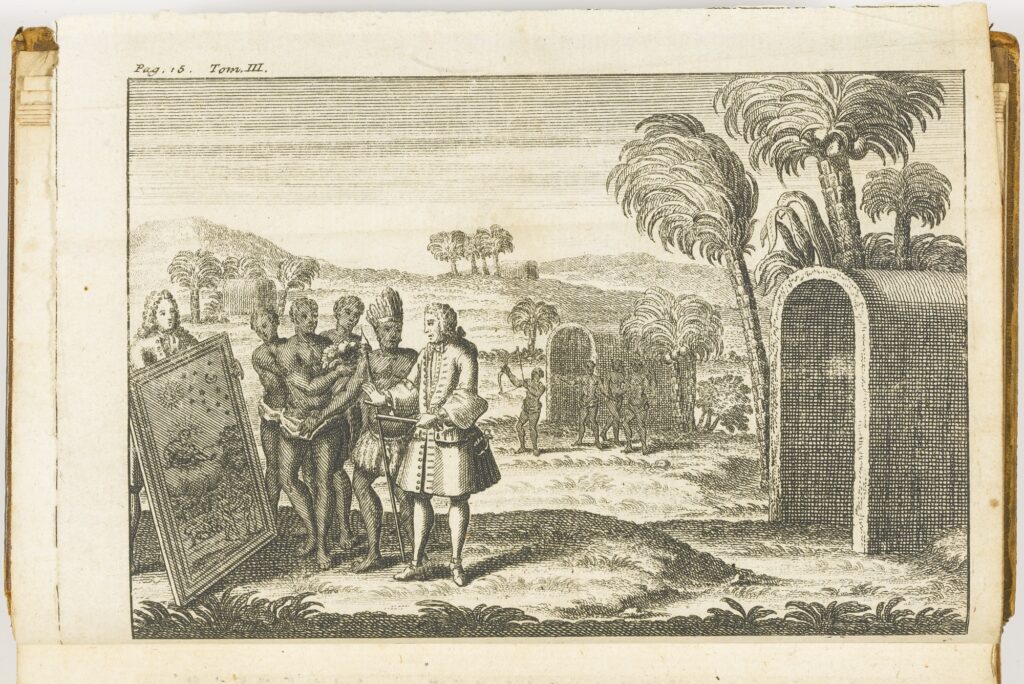
Hence, Lahontan, in his memoirs, says that Native Americans, such as Kondiaronk, who had been in France,
“were continually teasing us with the faults and disorders they observed in our towns, as being occasioned by money. There’s no point in trying to remonstrate with them about how useful the distinction of property is for the support of society: they make a joke of everything you say on that account. In short, they neither quarrel nor fight, nor slander one another; they scoff at arts and sciences, and laugh at the difference of ranks which is observed with us. They brand us for slaves, and call us miserable souls, whose life is not worth having, alleging that we degrade ourselves in subjecting ourselves to one man [the king] who possesses all power, and is bound by no law but his own will.”
Lahontan continues:
“They think it unaccountable that one man should have more than another,
and that the rich should have more respect than the poor.
In short, they say, the name of savages, which we bestow upon them, would fit ourselves better,
since there is nothing in our actions that bears an appearance of wisdom.”
In his dialogue with Kondiaronk, Lahontan tells him that if the wicked remained unpunished, we would become the most miserable people of the earth. Kondiaronk responds:
“For my part, I find it hard to see how you could be much more miserable than you already are. What kind of human, what species or creature, most Europeans be, that they have to be forced to do the good, and only refrain from evil because of fear of punishment?… You have observed we lack judges. What is the reason for that? Well, we never bring lawsuits against one another. And why do we never bring lawsuits? Well because we made a decision neither to accept or make use of money. And why do we refuse to allow money in our communities? The reason is this: we are determined not to have laws – because, since the world was a world, our ancestors have been able to live contentedly without them.”
Brother Gabriel Sagard, a French Recollect Friar, reported that the Wendat people were particularly offended by the French lack of generosity to one another:
“They reciprocate hospitality and give such assistance to one another that the necessities of all are provided for without there being any indigent beggar in their towns and villages;
and they considered it a very bad thing when they heard it said
that there were in France a great many of these needy beggars,
and thought that this was for lack of charity in us, and blamed us for it severely”.

Money, thinks Kondiaronk, creates an environment that encourages people to behave badly:
“I have spent six years reflecting on the state of European society and I still can’t think of a single way they act that’s not inhuman, and I genuinely think this can only be the case, as long as you stick to your distinctions of ‘mine’ and ‘thine’. I affirm that what you call money is the devil of devils; the tyrant of the French, the source of all evils; the bane of souls and the slaughterhouse of the living. To imagine one can live in the country of money and preserve one’s soul is like imagining one could preserve one’s life at the bottom of a lake. Money is the father of luxury, lasciviousness, intrigues, trickery, lies, betrayal, insincerity, – all of the world’s worst behaviors. Fathers sell their children, husbands their wives, wives betray their husbands, brothers kill each other, friends are false, and all because of money. In the light of all this, tell me that we Wendat are not right in refusing to touch, or so much as to look at money?”
In the third footnote of his speech on the origins on inequality, Jean-Jacques Rousseau, who invented the idea of the “noble savage” presumably existing before man engaged in agriculture, himself refers to
“those happy nations, who do not know even the names of the vices
which we have such trouble controlling,
of those American savages whose simple and natural ways of keeping public order
Montaigne does not hesitate to prefer to Plato’s laws…”
Europeans refusing to return
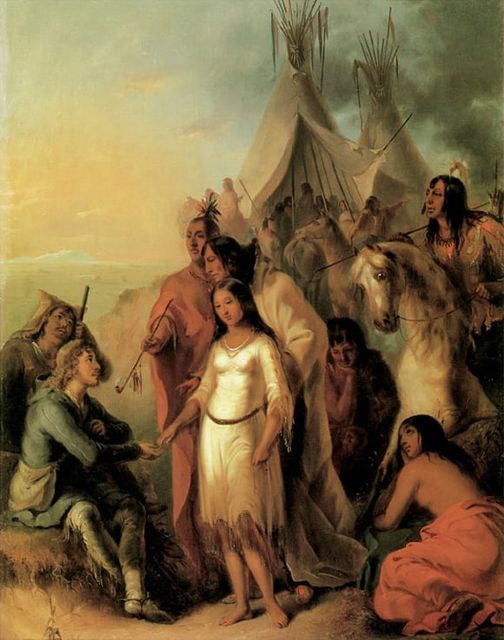
Another observation is that of Swedish botanist Peher Kalm, who, in 1749, was astonished by the fact that a large number of Europeans, exposed to Aboriginal life, did not want to return:
“It is also remarkable that the greater part of the European prisoners who, on the occasion of the war, were taken in this way and mixed with the Indians, especially if they were taken at a young age, never wanted to return to their country of origin afterwards, even though their father and mother or close relatives came to see them to try to persuade them to do so, and they themselves had every freedom to do so. But they found the Indians’ independent way of life preferable to that of the Europeans; they adopted native clothing and conformed in every way to the Indians, to the point where it is difficult to distinguish them from the Indians, except that their skin and complexion are slightly whiter. We also know of several examples of Frenchmen who have voluntarily married native women and adopted their way of life; on the other hand, we have no example of an Indian marrying a European woman and adopting her way of life; if he happens to be taken prisoner by the Europeans during a war, he always looks for an opportunity, on the contrary, to return home, even if he has been detained for several years and has enjoyed all the freedoms that a European can enjoy.”
Before Lahontan:
Thomas More’s Utopians

In 1492, as the joke goes, “America discovered Columbus, a Genoese captain lost at sea”. The mission he had been entrusted with was motivated by a variety of intentions, not least the idea of reaching, by traveling west, China, a continent thought to be populated by vast populations unaware of Christ’s inspiring and optimistic message, and therefore in urgent need of evangelization.
Unfortunately, two years later, a less theological interest arose when, on June 7, 1494, the Portuguese and Spanish signed the Treaty of Tordesillas at the Vatican, under the supervision of Pope Alexander IV (Borgia), dividing the entire world between two dominant world powers:
- the Spanish Empire under top-down control of the continental Habsburg/Venice alliance;
- the Portuguese Empire under that of the banking cartel of Genoese maritime slave traders.
This didn’t stop the best European humanists, two centuries before Lahontan, from raising their voices and showing that some of the so-called “savages” of the United States had virtues and qualities absolutely worthy of consideration and possibly lacking here in Europe.
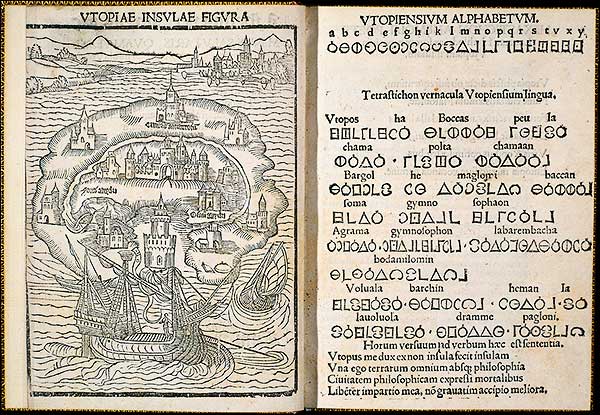
Such was the case with Erasmus of Rotterdam and his close friend and collaborator Thomas More, who shared what are thought to be their views on America in a little book entitled “U-topia” (meaning ‘any’ place), jointly written and published in 1516 in Leuven, Belgium.
By instinct, the reports they received of America and the cultural characteristics of its natives, led them to believe that they were dealing with some lost colony of Greeks or even the famous lost continent of Atlantis described by Plato in both his Timaeus and Critias.
In More’s Utopia, the Portuguese captain Hythlodeus describes a highly organized civilization: it has flat-hulled ships and “sails made of sewn papyrus”, made up of people who “like to be informed about what’s going on in the world” and whom he “believes to be Greek by origin”.
At one point he says:
“Ah, if I were to propose what Plato imagined in his Republic, or what the Utopians put into practice in theirs, these principles, although far superior to ours – and they certainly are –
might come as a surprise, since with us, everyone owns his property,
whereas there, everything is held in common.”
(no private property).
As far as religion is concerned, the Utopians (like the Native Americans)
“have different religions but, just as many roads lead to one and the same place, all their aspects, despite their multiplicity and variety, converge towards the worship of the divine essence. That’s why nothing can be seen or heard in their temples except what is consistent with all beliefs.
The particular rites of each sect are performed in each person’s home;
public ceremonies are performed in a common place;
Public ceremonies are performed in a form that in no way contradicts them.«
And to conclude :
“Some worship the Sun, others the Moon or some other planet (…) The majority, however, and by far the wisest, reject these beliefs, but recognize a unique god, unknown, eternal, in-commensurable, impenetrable, inaccessible to human reason, spread throughout our universe in the manner, not of a body, but of a power. They call him Father, and relate to him alone the origins, growth, progress, vicissitudes and decline of all things. They bestow divine honors on him alone (…) Moreover, despite the multiplicity of their beliefs, the other Utopians at least agree on the existence of a supreme being, creator and protector of the world.”
Exposing the trap of woke ideology
Does that mean that “all Europeans were evil” and that “all Native Americans were good”? Not at all! The authors don’t fall for such simplistic generalizations and “woke” ideology in general.
For example, even with major similarities, the cultural difference between the First Nation of the Canadian Northwest Coast and those of California, was as big as that between Athens and Sparta in Greek antiquity, the first a republic, the latter an oligarchy.
Different people and different societies, at different times, made experiments and different political choices about the axiomatics of their culture.
While in California, forms of egalitarian and anti-oligarchical self-government erupted, in some areas of the north, oligarchical rule prevailed:
“[F]rom the Klamath River northwards, there existed societies dominated by warrior aristocrats engaged in frequent inter-group raiding, an in which, traditionally, a significant portion of the population had consisted of chattel slaves. This apparently had been true as long as anyone living there could remember.”
Northwest societies took delight in displays of excess, notably during festivals known as “potlach” sometimes culminating in
“the sacrificial killing of slaves (…) In many ways, the behavior or Northwest Coast aristocrats resembles that of Mafia dons, with their strict codes of honor and patronage relations; or what sociologists speak of as ‘court societies’ – the sort of arrangement one might expect in, say, feudal Sicily, from which the Mafia derived many of its cultural codes.”
So, the first point made by the authors is that the infinite diversity of human societies has to be taken into account. Second, instead of merely observing the fact, the authors underline that these diversities very often didn’t result from “objective” conditions, but from political choices. That also carries the very optimistic message, that choices different from the current world system, can become reality if people rise to the challenge of changing them for the better.
Urbanization before agriculture

In the largest part of the book, the authors depict the life of hunter-gatherers living thousands of years before the agricultural revolution but able to create huge urban complexes and eventually ruling without a dominant oligarchy.
The book identifies examples in China, Peru, the Indus Valley (Mohenjo-Daru), Ukraine ((Taljanki, Maidenetske, Nebelivka), Mexico (Tlaxcala), the USA (Poverty Point), and Turkey (Catalhoyuk), where large-scale, city-level living was taking place (from about 10,000 BC to 6,000 BC).
But these didn’t involve a ruling caste or aristocratic class; they were explicitly egalitarian in their house building and market trading; made many innovations in plumbing and street design; and were part of continental networks which shared best practice. The agricultural revolution was not a “revolution”, the book argues, but rather a continual transformative process spread across thousands of years when hunter-gatherers were able to flexibly organize themselves into mega-sites (several thousand inhabitants), organized without centers or monumental buildings, but built with standardized houses, comfortable for daily life, all of this achieved without static hierarchies, kings, or overwhelming bureaucracy.

Another case in point is the example of Teotihuacan, which rivaled Rome in grandeur between about 100 BC and 600 AD, where, following a political revolution in 300 AD, an egalitarian culture embarked on a massive social housing program designed to give all residents decent quarters.
Conclusion
Living today, it is very difficult for most of us to imagine that a society, a culture, or a civilization, could survive over centuries without a centralized, forcibly hierarchical power structure.
While, as the authors indicate, archaeological evidence, if we are ready to look at it, tell us the contrary. But are we ready to challenge our own prejudices?
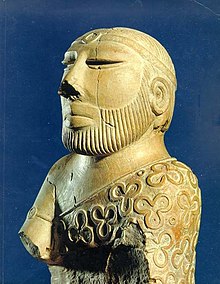
As an example of such self-inflicted blindness, worth mentioning is the case of the “King-Priest”, a small male carved figure showing a neatly bearded man, found during the excavation of the ruined Bronze Age city of Mohenjo-daro (Pakistan), dated to around 2000 BC and considered « the most famous stone sculpture » of the Indus Valley civilization. While in Mohenjo-Daro there exists neither a royal palace or tomb, nor a religious temple of any nature, British archaeologists immediately called it a “King-Priest”, because very simply “it can’t be otherwise”.
Reading Graeber and Wengrow’s book obliges us to adjust our views and become optimistic. They show that radically different human systems are not only possible but have been tried many times by our species. In a public talk in 2022, Wengrow presented what he sees as lessons for the political present from the past, where human beings were much more fluid, conscious and experimental with their social and economic structures :
“Now what do all these details amount to? What does it all mean? Well, at the very least, I’d suggest it’s really a bit far-fetched these days to cling to this notion that the invention of agriculture meant a departure from some egalitarian Eden. Or to cling to the idea that small-scale societies are especially likely to be egalitarian, while large-scale ones must necessarily have kings, presidents and top-down structures of management. And there are also some contemporary implications. Take, for example, the commonplace notion that participatory democracy is somehow natural in a small community—or perhaps an activist group—but couldn’t possibly have a scale-up for anything like a city, a nation or even a region. Well, actually, the evidence of human history, if we’re prepared to look at it, suggests the opposite. If cities and regional confederacies, held together mostly by consensus and cooperation, existed thousands of years ago, who’s to stop us creating them again today with technologies that allow us to overcome the friction of distance and numbers? Perhaps it’s not too late to begin learning from all this new evidence of the human past, even to begin imagining what other kinds of civilization we might create if we can just stop telling ourselves that this particular world is the only one possible.”
Léonard en résonance avec la peinture traditionnelle chinoise

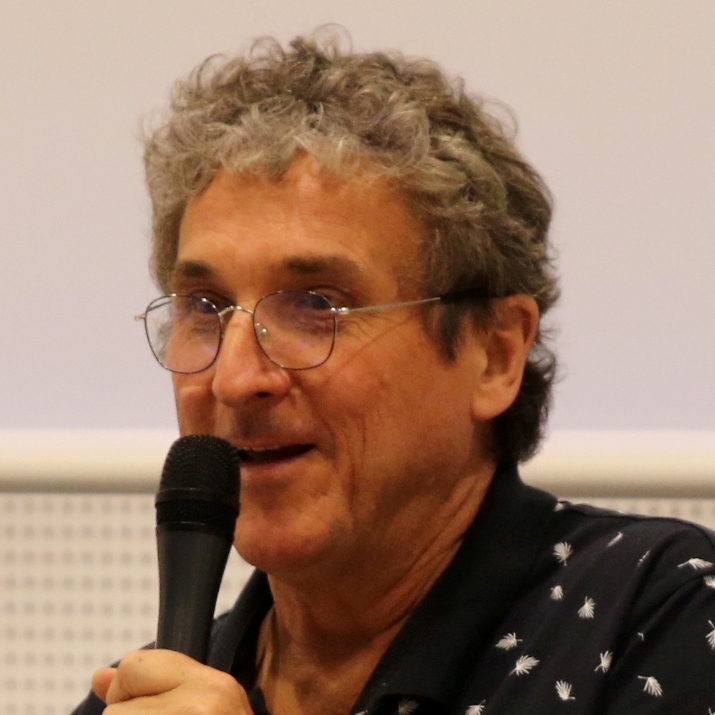
Mon entretien avec le Quotidien du Peuple: (People’s Daily)
Version chinoise (mandarin) suivie de la version française (FR) et anglaise (EN):
2019年12月18日17:03 来源:人民网-国际频道 分享到:
人民网巴黎12月17日电(记者 葛文博)今年是达芬奇逝世500周年,长居法国的比利时版画家、艺术史学家、美术评论家雷尔·维希肯(Karel Vereycken)近日接受人民网记者采访,阐述其多年研究达芬奇绘画技法的心得,认为《蒙娜丽莎》一画同中国古代绘画技法异曲同工。
在他看来,许多人采用“欧洲中心”的视角将透视法归于西方独创和所有,这是错误的。维希肯通过观察中国古代尤其是宋代的绘画作品,提出中国才是透视法的先驱,后世包括达芬奇在内的许多欧洲艺术家的作品都能同中国古代绘画理论和技法产生共鸣。
人民网:您认为中国绘画如何启发了透视法?
维希肯:中国从公元6世纪开始,一些艺术著作不仅记录了文艺实践,也启发了更为活跃的绘画艺术。中国南北朝著名的画家、文艺理论家谢赫提出的“六法”,既要“气韵生动”又要“应物象形” 。宋代画家与书画鉴赏家郭若虚在其《图画见闻志》中写道:“人品既已高矣,气韵不得不高;气韵既已高矣,生动不得不至”。这显然超脱了绘画的“技术”层面,升华进入了精神和道德领域。它突破单纯形制而追求由内而外的生命力,成为透视法的重要理论基础。
人民网:这与达芬奇绘画技法有何契合之处?
维希肯:我在2007年发表的文章《达芬奇,捕捉运动的画家》中就指出,这位画家渴望绘制运动、转变的场景。达芬奇非常认同希腊哲学家赫拉克利特斯的名言“世上唯有‘变化’才是永恒的”。然而,要掌握的不是物体的形式或它们所处的时空,而是要掌握它们在变化过程中在给定时刻的外观,这就有必要深入了解产生变化的原因。
宋代苏轼在其《净因院画记》中提出,人类、家禽、宫殿、居室、器物、使用的东西,都有其经常所处的形态。至于山川、岩石、竹子、柴木,流水、海波、烟雾、云朵,虽没有经常所处的形态,但有其存在的本质。我发现,苏轼追求本质、重视变化的观念同达芬奇寻求运动的思路不谋而合。
唐代诗人王维在其《山水论》中更为详尽地阐述其对透视的理解:“远人无目,远树无枝。远山无石,隐隐如眉;远水无波,高与云齐”。 对画面的空间、层次、疏密、清晰度等做出细致描述。这与达芬奇采用的“空气透视法”也完全契合。
人民网:这种契合如何表现在达芬奇的《蒙娜丽莎》画作中?
韦雷肯:除了形体的运动以外,达芬奇还试图表达一种“非物质的运动”,他将其分为五类。第一个是时间,因为它“包容了所有其他事物”,其他分别还有光、声音和气味的传播。在他看来,这些并非实体的运动恰恰使事物充满生机。
但是,如何描绘这种生机呢?仅凭借固定的形式是不可能的,因为死死抓住形式不放,就如同费心捕捉美丽的蝴蝶却将其用钉子钉住制成标本,生命力就消逝了。雕塑家、诗人和画家必须在作品中制造讽刺、矛盾和模糊,就像伟大的思想家林登·拉鲁什(Lyndon LaRouche)所说的“中间状态”,以揭示潜在的运动和变化。
蒙娜丽莎的脸上就充满了神秘的“矛盾”:嘴巴的一侧微笑,另一侧微笑的程度略小;一只眼睛透出认真的眼神,另一只眼睛则透出愉悦;一只眼睛看着你,另一只眼睛则越过了你,等等。蒙娜丽莎的微笑难下定义,因为它恰好在“中间状态”。她是真的微笑还是哭泣?她的微笑能拥有这样迷人的力量,是因为她身后的风景更为迷人。这副画风景的透视更接近之前我们所述的中国画的规则,而不是彼时欧洲的死板规定。
在中国画中,水与山之间的相互作用是普遍转变的象征,可以将不同层次的山、水、雾等联系起来。从公元10世纪开始,中国画寻求与人类视觉经验相符的构造,不仅采用焦点透视,反而创造运用随着视线投射变化产生的散点透视。这种透视恰恰存在于达芬奇的《蒙娜丽莎》之中,在人物的左侧,视线位于鼻孔的高度,在人物右侧,水平线则升至眼角。这样打破常规的透视法,令我们感受到蒙娜丽莎鲜活的生命和活泼的灵魂,聆听着到画作与中国传统绘画穿越时空的共鸣。 (责编:李婷(实习生)、燕勐)
Cet article a été repris par les sites chinois suivants:
- People’s Daily: http://world.people.com.cn/n1/2019/1218/c1002-31512405.html
- Eastday.com: http://news.eastday.com/w/20191218/u1ai20237205.html
- Chinese Academy of Social Sciences (CASS): http://www.cssn.cn/hqxx/hqwx/hqwxnews/201912/t20191219_5061586.shtml
- art-ville.com: http://www.art-ville.com/zixun/vQBpc.html
- themusicalhacker.com: http://www.themusicalhacker.com/guoji/16.html
- beanstalky.com: http://www.beanstalky.com/guoji/14.html
- Foro-avdi.com: http://www.foro-avdi.com/guoji/2164.html
- Qz123.com : http://www.qz123.com/html/298/20191219/news_show_244384.html
- Myweb.wang: http://www.myweb.wang/news/details/bb529d5833e8650ab25f9220121a125e
- kknews.cc: https://kknews.cc/culture/y5l42og.html
- haxw.net: http://www.haxw.net/guoji/8377.html
- fjshuchi.com: https://www.fjshuchi.com/news/j8jhjdjlh9jmhl8.html
- xw.qq.com: https://xw.qq.com/cmsid/20191218A0KSC300
- news.66wz.com: http://news.66wz.com/system/2019/12/18/105218123.shtml
- zutiyu.com : http://www.zutiyu.com/content/20191219/4037144.htm
- mini.eastday.com: https://mini.eastday.com/a/191218172310279.html
- sapuc.ch: http://www.sapuc.ch/php/indexi_5.php
- dzwww.com: http://www.dzwww.com/xinwen/guojixinwen/201912/t20191218_19480201.htm
- m.regulatingsenses.com: http://m.regulatingsenses.com/guoji/6.html
- Zolix: http://www.loginesia.com/guoji/2196.html
- ncaip.com: http://ncaip.com/guoji/3.html
- pentouweixiu.com: http://www.pentouweixiu.com/guoji/44.html
- mariobahamon.com: http://www.mariobahamon.com/guoji/31.html
- kidsslay.com: http://kidsslay.com/guoji/461.html
- lunarizada.com: http://lunarizada.com/guoji/26.html
- abonhand.com: http://m.adonhand.com/guoji/12.html
- makedesignone.com: http://www.makedesignone.com/guoji/1.html
- monavisadoors.com: http://www.monavisadoors.com/guoji/44.html
- happybreadwinner.com: http://happybreadwinner.com/guoji/3.html
- m2.people.cn: http://m2.people.cn/r/MV8xXzMxNTEyNDA1XzEwMDJfMTU3NjY1OTgyMA==
- indopakgrocerystore.com: http://www.indopakgrocerystore.com/guoji/11.html
- shygit.com: http://www.shygit.com/guoji/57646.html
- bollywoodtonite.com: http://m.bollywoodtonite.com/guoji/8.html
- mesopecia.com: http://www.mesopecia.com/guoji/418.html
- ufitit.com: http://ufitit.com/guoji/3016.html
- codgerconsulting: http://www.codgerconsulting.com/guoji/15.html
- ggmsolutions.net: http://ggmsolutions.net/guoji/13.html
- h.miniu2.com: http://m.miniu2.com/guoji/16.html
- zangkailinguistics.com: http://zhangkailinguistics.com/guoji/13.html
- abcq481.top: http://abcq481.top/guoji/655.html
Version française:
Léonard en résonance avec la peinture traditionnelle chinoise
Karel Vereycken, un peintre-graveur et historien d’art amateur d’origine belge vivant en France, travaille depuis longtemps sur la perspective. En 1996, dans une étude approfondie publiée dans Ibykus, le magazine allemand de l’Institut Schiller, il résuma ses recherches sous le titre « L’invention de la perspective ». Selon lui, par une lecture euro-centrique étriquée, la majorité des « experts » attribuent la paternité de cette découverte (la représentation de l’espace sur un plan) de façon exclusive à l’Occident.
Or, en examinant, non seulement les œuvres mais tout autant les écrits des peintres chinois, notamment ceux de la Dynastie Song (960-1279 après JC), Vereycken s’est rendu à l’évidence que la Chine a été pionnière dans ce domaine et a pu influencer certains artistes européens, dont Léonard de Vinci. Il a développée cette question dès 1996 dans son article intitulé « Sur la peinture chinoise et son influence en Occident ».
Etant donné qu’en 2019-2020 le Musée du Louvre, consacre une belle exposition à ce peintre extra-ordinaire, dans le cadre du 200e anniversaire de sa disparation, nous avons demandé à Karel Vereycken de présenter l’influence chinoise sur son œuvre.
Quotidien du Peuple : M. Vereycken, quel a été l’apport de la Chine à l’invention de la perspective ?
VEREYCKEN: L’avantage de la Chine, et mes confrères chinois me corrigeront le cas échéant, c’est que l’on y trouve, dès le VIe siècle, des écrits témoignant, non seulement de la pratique artistique dans le pays, mais évoquant l’état d’esprit qui doit animer les peintres. Je pense notamment aux six règles de base de la peinture chinoise détaillées par Xie He (500-535) pour qui « la résonance intérieure » doit « donner vie et mouvement » mais exige aussi la « fidélité à l’objet en représentant les formes ». L’on constate tout de suite, que ce qui prime, ce n’est pas la performance « technique » du peintre, mais sa valeur spirituelle et morale. Le peintre des Song, Guo Ruoxo, écrit par exemple en 1074, que « Si la valeur spirituelle (renpin) d’une personne est élevée, il s’ensuit que la résonance intérieure est nécessairement élevée, alors sa peinture est forcément pleine de vie et de mouvement (shendong). On peut dire que, dans les hauteurs les plus élevées du spirituel, il peut rivaliser avec la quintessence ».
Quotidien du Peuple : En quoi cela a un rapport avec Léonard de Vinci ?
VEREYCKEN: Comme j’ai tenté de le développer dans mon article « Léonard, peintre de mouvement » de 2007, ce qui rapproche ce peintre de la philosophie chinoise, c’est sa volonté de peindre les transformations. Léonard se reconnaissait pleinement dans la phrase du philosophe grec Héraclite pour qui « Il n’y a que de permanent que le changement ». Or, pour saisir, non pas la forme des objets ou de l’espace-temps dans lequel ils se situent, mais leur apparition à un moment donné dans un processus de transformation, il faut savoir pénétrer les causes qui les engendrent.
Or, les « Notices sur les peintures du Jingyinuan » de Su Shi (1036-1101), révèlent une approche si semblable à Léonard qu’on risque de les confondre avec ses « carnets » ! Su Shi écrit « Au sujet de la peinture, j’estime que si les figures humaines, les animaux, les bâtiments ou les ustensiles ont une forme constante, par contre, les montagne et rochers, les arbres et bambous, eaux courantes et vagues, comme les brumes et les nuages, n’ont pas de forme constante, mais gardent un principe interne constant. Lorsque la forme constante est défectueuse dans sa représentation, tout le monde s’en aperçoit ; cependant, même un connaisseur peut ne pas s’apercevoir que le principe constant n’est pas respecté. C’est pourquoi tant de peintres médiocres, afin de tromper le monde, peignent ce qui n’a pas une forme constante. Or un défaut dans la représentation d’une forme ne touche qu’une partie de la peinture, alors qu’une erreur dans le principe constant en ruine la totalité. Car lorsqu’il agit de la représentation des choses qui n’ont pas de forme constante, il faut respecter son principe interne (li). Certains artisans sont capables de dessiner les formes exhaustivement ; par contre, pour leur principe, seuls y parviennent les esprits élevés et les talents éminents… »
Quotidien du Peuple : et au niveau de la perspective ?
VEREYCKEN : Léonard, qui décrit la « perspective d’effacement » aurait pu adhérer sans problème à ce qu’écrit l’érudit Wang Wei (701-761) pour qui : « d’un homme à distance, on ne voit pas les yeux ; d’un arbre à distance, on ne distingue pas les branches ; d’une montagne lointaine aux contours doux comme un sourcil, nul rocher est visible ; de même nulle onde sur une eau lointaine, laquelle touche l’horizon des nuages. ». Et pour qui, il est impératif de « distinguer le clair et l’obscur, le net et le flou. Établir la hiérarchie entre les figures ; fixer leurs attitudes, leur démarche, leurs saluts réciproques. Trop d’éléments, c’est le danger de l’encombrement ; trop peu, c’est celui du relâchement. Saisir donc l’exacte mesure et la juste distance. Qu’il y ait du vide entre le lointain et le proche, cela aussi bien pour les montagnes que pour les cours d’eau. »
Quotidien du Peuple : comment voyez-vous cette influence sur La Joconde ?
VEREYCKEN : Il faut bien comprendre, qu’au-delà du mouvement du corps, Léonard chercha à exprimer les « mouvements immatériels » qu’il classe en cinq catégories. La première est le temps car il « embrasse toutes les autres ». Les autres sont la diffusion des images par la lumière, celle des sons et des odeurs, le mouvement « mental » est celui qui anime « la vie des choses » (Codex Atlanticus, 203v-a).
Mais alors, comment peindre ce souffle de la vie ? Formellement c’est totalement impossible car dès qu’on attrape une forme, la vie s’en échappe comme celle d’un papillon qu’on épingle ! Pour y parvenir, sculpteurs, poètes et peintres doivent créer une ironie, une ambiguïté que le grand penseur Lyndon LaRouche (1922-2019) a exprimée en anglais comme mid-motion (un « moment d’entre-deux »), révélant le potentiel d’une transformation potentielle à un moment donné, pour ceux qui veulent bien le voir.
Or, regardez le visage de la Joconde, rempli de paradoxes énigmatiques : un coté de la bouche sourit, l’autre, moins ; un œil est sérieux, l’autre amusé, un œil vous regarde, l’autre regarde au-delà, etc. Ce sourire est indéfinissable car précisément « entre deux ». Va-t-elle sourire réellement ou éclater en pleurs ? L’énigme de son sourire n’aura jamais cette force sans le paysage encore plus énigmatique sur l’arrière plan. Or, la perspective de ce paysage obéit plutôt aux préceptes chinois qu’aux règles rigides de la perspective européenne.
Dans la peinture chinoise, l’interaction entre l’eau et la montagne étant symbole de transformation universelle, différents niveaux peuvent s’enchaîner du type : eau, petite brume, montagne, grande brume, nuage, eau, petite brume, montagne et ainsi de suite. Cherchant à se conformer à la vue humaine, les peintres chinois, dès le Xe siècle, feront appel, non pas à une seule ligne d’horizon, mais à une succession d’horizons accompagnant notre vue là où elle se projette. Or, c’est précisément le procédé mis en œuvre par Léonard dans La Joconde où les horizons se succèdent. A gauche de la figure, la ligne d’horizon s’établit à la hauteur des narines ; à droite, au niveau des yeux, le tout perturbant suffisamment nos habitudes visuelles pour que notre esprit s’ouvre à ce que Léonard jugeait essentiel : l’âme vivante de La Joconde.
English version (via google translate)
Leonardo Da Vinci’s « Mona Lisa » resonates with time and space with traditional Chinese painting
People’s Daily, Paris, December 17 (Reporter Ge Wenbo) This year marks the 500th anniversary of the death of Da Vinci. Belgian printmaker, art historian and art critic Karel Vereycken, who has lived in France, recently accepted an interview with a reporter on the Internet explaining his experience in studying Da Vinci’s painting techniques for many years, and he believed that the painting of « Mona Lisa » is similar to the ancient Chinese painting technique.
In his view, many people use a « European-centric » standpoint to attribute perspective to Western originality and ownership, which is wrong. Through observing the paintings of ancient China, especially the Song Dynasty, Vereycken proposed that China was the pioneer of perspective. The works of many European artists including Da Vinci in later generations could resonate with ancient Chinese painting theories and techniques.
People’s Daily: How do you think Chinese painting inspired perspective?
VEREYCKEN: From the 6th century onwards in China, some art works not only recorded literary practice, but also inspired more active painting art. The « six methods » proposed by Xie He, a well-known painter and literary theorist in the Southern and Northern Dynasties of China, need to be both « spiritual and vivid » and « appropriate ». Song Dynasty painter and calligraphy connoisseur Guo Ruoxu wrote in his « Pictures and Wenwenzhi »: « The character has become high, and the charm must be high« ; This obviously transcends the « technical » level of painting and sublimates into the spiritual and moral realm. It broke through the simplex system and pursued the vitality from the inside to the outside, and became an important theoretical basis of perspective.
People’s Daily: How does this relates to Da Vinci’s painting techniques?
VEREYCKEN: In my 2007 article « Da Vinci, the painter who captures movement, » I pointed out that the artist was eager to paint scenes of movement and change. Da Vinci agreed with the famous quote of the Greek philosopher Heraclitus, « Only ‘change’ in the world is eternal. » However, it is not the form of the objects or their time and space that must be grasped, but the appearance of them at a given moment in the process of change, which requires a deep understanding of the reasons for the change.
In his Song of Jingyinyuan in the Song Dynasty, Su Shi proposed that human beings, poultry, palaces, houses, utensils, and things used often have their forms. As for mountains and rivers, rocks, bamboo, firewood, flowing water, waves, smoke, and clouds, although they don’t often exist, they have their essence. I found that Su Shi’s concept of pursuing essence and value change coincided with Da Vinci’s idea of seeking movement.
The Tang Dynasty poet Wang Wei expounded his understanding of perspective in his « Landscapes and Landscapes » in more detail: « A distant man has no eyes, a distant tree has no branches. A distant mountain has no stones, faint like eyebrows; Yun Qi. » Make a detailed description of the space, layer, density, and sharpness of the picture« . This also fits perfectly with the « air perspective » adopted by Da Vinci.
People’s Daily Online: How does this appears in Da Vinci’s Mona Lisa painting?
VEREYCKEN: In addition to physical movement, Da Vinci also tried to express a « non-material movement », which he divided into five categories. The first is time, because it « contains everything else, » and the other is the spread of light, sound, and smell. In his view, these non-substantial movements just made things full of life.
But how to portray this vitality? It is impossible to rely only on the fixed form, because holding on to the form is like trying to catch a beautiful butterfly but nailing it to make a specimen, and vitality is lost. Sculptors, poets, and painters must create irony, contradiction, and ambiguity in their works, as the great thinker Lyndon LaRouche called « intermediate states » to reveal potential movements and changes.
The face of Mona Lisa is full of mysterious « contradictions »: one side of the mouth smiles, and the other side smiles slightly; one eye reveals a serious look and the other eye expresses pleasure; One eye is looking at you, the other eye is over you, and so on. Mona Lisa’s smile is difficult to define because it happens to be in the « middle state ». Does she really smile or cry? Her smile has such a charming power because the scenery behind her is more charming. The perspective of this landscape is closer to the rules of Chinese painting we described earlier than to the rigid rules of Europe at that time.
In Chinese painting, the interaction between water and mountains is a symbol of universal transformation, which can link different levels of mountains, water, and fog. Starting from the 10th century AD, Chinese painting seeks a structure consistent with human visual experience. Instead of using focal perspective, it has created and used scatter perspective produced by changes in line of sight projection. This perspective exists precisely in Da Vinci’s Mona Lisa. On the left side of the character, the line of sight is at the height of the nostril, and on the right side of the character, the horizontal line rises to the corner of the eye. This way of breaking the conventional perspective allows us to feel the lively life and lively soul of Mona Lisa, listening to the resonance between the painting and traditional Chinese painting through time and space.
Les secrets du dôme de Florence

Après une enquête approfondie sur les techniques de construction des voûtes et des coupoles depuis l’antiquité jusqu’à nos jours, Karel Vereycken explore et valide la place centrale de la courbe chaînette, une courbe physique, dans la conception du dôme de Florence par Brunelleschi.
Cet article a été initialement publié dans le N°96 de la revue scientifique Fusion de juin 2003 (fichier pdf: Les secrets du dôme de Florence, Fusion). En 2013, Karel Vereycken contribua au numéro hors série « Florence, l’invention de la Renaissance« du magazine Beaux-Arts.
Pour le sage, au contraire, il n’est rien d’invisible, sinon ce qui n’est pas, sinon la pure absence. (Filippo Brunelleschi, en réponse à un de ses détracteurs)
Introduction
Tout le monde pense connaître l’énorme dôme à pans coupés sur plan octogonal de l’église Santa Maria del Fiore dominant la belle ville de Florence de ses quelques cent douze mètres, car chacun l’a vu, au moins en photo.
Le 25 mars 1436, un motet en quatre voix, le Nuper Rosarum Flores composé pour sa consécration par le flamand Guillaume Dufay, annonça : « Naguère des guirlandes de roses, par la grâce pontificale et en dépit d’un hiver sauvage, te furent offertes, Vierge céleste, comme ornement perpétuel, avec un temple de grande ingénuité, à toi dédié avec pitié et sainteté. » (*)
Les deux escaliers de 463 marches qui serpentent entre les deux calottes conduisent à la base d’un lanternon qui se trouve à la hauteur équivalente d’un immeuble de quarante étages. Achevé en 1436 après seize ans et deux semaines de travail acharné, nécessitant près de quatre millions de briques et pesant environ 37.000 tonnes, le dôme est devenu non seulement l’emblème de Florence mais le symbole même de la Renaissance.
Avec ses 42,2 m de diamètre, sa largeur est quasiment l’équivalent de celui de la coupole sphérique du Panthéon de Rome (43,4m) et son diamètre ne sera que légèrement dépassé en 1765 par la Halle aux Blés de Paris (44m). Ni la basilique Saint-Pierre de Rome (42m), ni le dôme des Invalides (27,5m) ni la cathédrale Saint-Paul de Londres (30,7m), ni même la coupole (en métal) du Capitole de Washington D.C. ne le dépassent.
Sa réalisation, tenu pour impossible à son époque, est associée au nom d’un seul homme -Filippo Brunelleschi (1377-1446) – à qui l’on attribue également l’invention de la perspective linéaire. L’architecte, Léon Battista Alberti (1404-1472), dans le prologue de son traité sur la perspective De Pictura (1435) disait de lui : « Quel homme, si dur ou si jaloux, ne louerait l’architecte Filippo en voyant cette énorme construction se dressant jusqu’au ciel, assez vaste pour couvrir de son ombre toute la population de Toscane, et exécutée sans l’aide de poutrages ni de renfort de supports de bois. »
Comme nous allons le voir ici, ce grand chantier, mettant au défi toutes les connaissances humaines de l’époque, fut la véritable locomotive d’une révolution dans les sciences et les techniques qui entraînera, pendant des siècles, une vague d’optimisme au grand bénéfice de l’ensemble de l’humanité.
Avec le duomo, Brunelleschi tracera de nouveaux horizons, bien au-delà de la simple construction d’un édifice.
Qui était Brunelleschi ?
Brunelleschi (Fig. 1) fut le fils d’un notaire de Florence. Doué dès son enfance pour le dessin, son père lui assura une carrière d’orfèvre (orafo). Passionné d’horlogerie et de machines, Brunelleschi eut la chance d’être initié à la géométrie par Paolo Toscanelli del Pozzo (1397-1482) (**), avec lequel il entretint une amitié pendant toute sa vie adulte.
Avec Nicolas de Cuse, Toscanelli, Niccoli, Cesarini et possiblement Brunelleschi, faisaient parti du groupe d’action politique et de réflexion qu’animait le général de l’ordre des Camaldules, Ambrogio Traversari (***) avec l’appui bienveillant de Côme de Medici, grand patron de l’industrie lainière et mécène de la Renaissance.
Cependant, cet engagement n’est pas sans risque. Exploitant politiquement la défaite militaire de Florence contre Lucca de 1433, la famille oligarchique des Albizzi jette tout le blâme sur Côme et le fit jeter en prison, le forçant même en exil à Venise. Ayant perdu son protecteur, Filippo Brunelleschi fut arrêté à son tour sous prétexte de ne pas être à jour avec sa cotisation de membre de la guilde du bâtiment, chose plutôt habituelle à l’époque. Quinze jours plus tard, les Albizzi furent écartés, Filippo relâché et Côme de retour à Florence. Martin V et Eugène IV, qui ouvrit la cathédrale après cent quarante ans de construction, intervinrent personnellement à plusieurs reprises pour protéger et promouvoir l’architecte génial Brunelleschi. Celui-ci, mort en 1446, ne verra ni le lanternon qu’il avait conçu – terminé en 1471- ni la sphère en bronze de 2,5m, fabriquée et posée par l’atelier d’où sortait Léonard de Vinci, celui d’Andrea del Verrocchio.
Genèse du projet
Il fallait enfin achever cet immense chantier sur l’emplacement de l’ancienne église Santa Reparata, commencé en 1296 par Arnolfo di Cambio et agrandi en 1351 par Francesco Talenti. A Florence, tout le monde connaissait bien la forme finale du « dôme à pans coupés sur plan octogonal » à réaliser. Depuis 1367, une maquette du projet était exposée au public dans une des ailes de la Basilique en voie d’agrandissement. Déjà à cette époque, un concours avait opposé deux groupes d’architectes. Le premier, dirigé par Lapo Ghini plaida en faveur d’un concept architectural proche du style gothique traditionnel, combinant des murs assez minces avec un ensemble d’énormes contreforts et arcs-boutants semblables à ceux des cathédrales, destinés à soutenir la coupole.
L’autre groupe, dirigé par l’architecte Neri di Fioravanti, celui qui réalisa la voûte (large de 18m) de la maison d’arrêt Bargello et le Ponto Vecchio. Il exigea, quant à lui, une solution « à l’antique ». Neri, comme beaucoup d’autres en Italie à l’époque, considérait que les arcs-boutants non seulement n’étaient pas très esthétiques mais appartenaient au patrimoine culturel des ennemies traditionnelles des Florentins : les Allemands, les Français, les Milanais et autres « barbares » (Goths).
Selon Neri, on pouvait très bien faire l’économie de ces contreforts et arcs-boutants en incorporant des tirants, en pierre et en bois, autour de la circonférence, semblable à la façon dont les cerceaux cerclent les douves d’un tonneau. Ce concept est intéressant mais, comme nous allons le voir, insuffisant. L’emploi du métal en architecture était encore à un stade assez expérimental. Toutefois, lors de la reconstruction du cœur demi-circulaire de la cathédrale de Beauvais, après son effondrement en 1284, on relia déjà les arcs-boutants entre eux par des tirants en fer afin de renforcer la cohésion de la structure.
Pour la coupole, Neri prévoyait l’utilisation, très rare mais pas exceptionnelle à l’époque, d’une double calotte. Cette technique d’origine Perse est devenue caractéristique des mosquées et des mausolées islamiques, comme le Mausolée à base octogonale de Oljeitü (26m de diamètre) construit en 1309 à Sultanyia (Azerbaïdjan). Une calotte interne porte l’édifice avec sa force structurelle, tandis qu’une calotte externe, en plus d’une protection contre les éléments, permet d’ajouter du volume supplémentaire.
En s’éloignant fortement de la conception du Panthéon de Rome où le dôme sphérique est coincé dans une masse de béton, Neri avait également l’intention d’élever les courbes des pans à élever sous forme d’arcs brisés gothiques, connu en Italie sous le nom de quinto acuto (quinte pointée). Il s’agissait en fait de diviser le diamètre de l’octogone en cinq parties égales, les 4/5ième constituant le rayon de la courbe du dôme (Fig. 2). Après moult débats, le projet de Neri l’emporta et fut dans la foulée approuvé par référendum populaire à Florence. Toutefois , Neri mourut sans laisser aucune instruction précise.
A partir de 1415, tout fut enfin prêt. Avec le tambour nouvellement construit, l’édifice atteignait déjà une hauteur impressionnante de 52 mètres, mais exhibant un trou béant large de plus de 42m. L’heure de la vérité avait sonné.
Antonio di Tuccio Manetti (1423-1497), auteur de La vie de Filippo Brunelleschi, qui a connu Brunelleschi de son vivant, raconte : « D’autant plus que les maîtres d’œuvres s’inquiétaient déjà de la difficulté d’avoir à construire une voûte si large et si haute : étant donné la hauteur et la largeur, donc le poids, les étaiements et soutiens, arcs ou autres armatures, devaient partir de terre, de sorte que, non seulement la dépense leur paraissait effrayante, mais la réalisation à vrai dire absolument impossible. »
A ceux qui évoquèrent cette impossibilité, Brunelleschi répondait que le dôme était un édifice sacré, et que « Dieu, à qui rien n’est impossible, ne nous abandonnerait pas. »
Pour lancer le projet il suggérait aux maîtres d’œuvres, les Fabriciens, d’organiser un colloque international et de réunir tous les architectes, maîtres maçons et ingénieurs « autant qu’on en trouverait dans la chrétienté. »
Cette réunion eut lieu et voici comment Antonio di Tuccio Manetti la relate : « Des paroles de Filippo, les Fabriciens tiraient avec accord le verdict qu’un édifice aussi grand et d’une telle nature ne pouvait être achevé et que ç’avait été une naïveté, de la part des architectes du passé et de ceux qui l’avaient projeté, de le croire. Quand Filippo disait, à l’encontre de cette opinion fausse, qu’on pouvait le faire, ils répondaient tous ensemble : ‘Comment fera-t-on les cintres ?’, mais lui revenait toujours à l’idée qu’on voûterait sans cintre [échafaudage]. Comme ils discutaient la-dessus depuis plusieurs jours, à deux reprises les Fabriciens le firent jeter dehors par des gens à eux et de l’Art de la Laine, comme s’il raisonnait stupidement et ne disait que des paroles ridicules ; au point qu’il lui arriva souvent de raconter que dans ce laps de temps, il n’osait pas se promener dans Florence, ayant l’impression qu’on disait derrière lui : ‘Regarde ce fou qui a de telles prétentions’ »
-
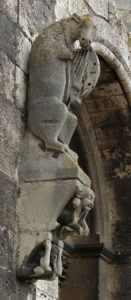
Fig. 3: « l’Âne qui vielle » vous lance d’une façon provocante le défi suivant : le monument que tu contemples est comme une lyre, prête à vibrer sous tes doigts. Sauras-tu en extraire la secrète harmonie, ou bien seras-tu comme moi, l’âne avec ses gros sabots, qui ayant trouvé une lyre, fut incapable d’en jouer…
Dans une autre réunion de travail, et avant d’être nommé capomaestro [architecte en chef] du chantier, on lui demanda d’indiquer sa méthode et les moyens d’exécution qu’il envisageait pour relever ce défi. Craignant qu’on lui vole le projet, Brunelleschi se contenta de leur présenter un oeuf en disant : « Celui qui le fera tenir debout sera digne de faire la coupole. » Après que chacun avait essayé sans succès, Brunelleschi écrasa la pointe de l’œuf sur une table en marbre. Chacun s’écria qu’il en aurait fait autant « s’il avait su », et Brunelleschi répondait en riant qu’ils sauraient également faire la coupole s’il leur montrait son modèle.
Mais en examinant aujourd’hui toutes les solutions créatrices que l’infatigable Brunelleschi aligna pour résoudre les problèmes scientifiques, dans les domaines de la physique, de la géométrie, des machines et des matériaux, sans parler des problèmes politiques, financiers ou de la formation permanente d’une main d’œuvre impliqué dans l’élaboration de technologies révolutionnaires, on doit mesurer la part de courage et de détermination sans laquelle les meilleures idées ne restent que rêveries.
Passionné par le sujet depuis sa tendre enfance, Brunelleschi va imposer des solutions longuement réfléchies. Etant donné qu’excepté un poème, aucun écrit de Brunelleschi ne nous est parvenu, le procédé exact et surtout sa mise en oeuvre resteront un sujet éternel de spéculation. Bien que notre inventeur se battait pour breveter les nouvelles inventions, nous savons que, craignant de se voir dérober sa méthode, il ne communiquait que par des chiffres, et de façon codée.
Ce qui reste à lire est le dôme lui-même, et le spectateur se retrouve un peu comme celui du visiteur de la Cathédrale de Chartres devant l’Ane qui vielle (Fig. 3), cette statue qui vous lance d’une façon provocante le défi suivant : le monument que tu contemples est comme une lyre, prête à vibrer sous tes doigts. Sauras-tu en extraire la secrète harmonie, ou bien seras-tu comme moi, l’âne avec ses gros sabots, qui ayant trouvé une lyre, fut incapable d’en jouer…
Cintrage, ou construire sans bois
Pendant la construction d’un édifice ou d’une coupole, il faut affronter deux forces majeures : d’une part la compression qui provoque un écrasement et, d’autre part, la poussée latérale qui crée une rupture à l’écartement (Fig. 4).

Figure 4. L’architecte doit affronter deux forces majeures : la compression qui provoque un écrasement et la poussée latérale qui crée une rupture à l’écartement.
La compression étant un problème relativement mineur, puisqu’il faut une hauteur importante avant que les pierres du bas ne s’écrasent sous la pression de celles d’en haut, c’est surtout la maîtrise de la pression latérale résultant des poussées verticales qui seront la première préoccupation de l’architecte.
En général, la construction d’arcs s’opérait à partir d’une fausse charpente [supports temporaires] – le cintrage (Fig. 5) – permettant d’élever les voussoirs d’un arc de plein-cintre (roman) ou en arc brisé (gothique).
Ce support n’était retiré qu’après le séchage du mortier, et surtout après la pose de la clef de voûte, laquelle répartissait la poussée sur l’ensemble des voussoirs et la conduisait sur les colonnes qui soutiennent la voûte. Il est indiscutable que, pour des voûtes en berceau ou les nefs gothiques, un cintrage lourd s’avérait indispensable.
Cette technique n’est apparue que très tardivement dans des sociétés capables de produire du bois assez solide, soit au moins d’en disposer. Là, où le bois faisait défaut ou était de mauvaise qualité, on tentait de construire sans cintrage.
Auguste Choisi, dans son Histoire de l’architecture , signale déjà l’existence d’un dôme à Abydos en Egypte où, grâce au limon du Nil, l’emploi de briques crues (argile séchée) auraient permis l’élévation de dômes depuis les premières dynasties pharaoniques (3000 avant J.-C.) (Fig. 6) : « De tous les types de voûtes, celui qui se réalise le plus aisément sans cintres, est la voûte sphérique : le dôme est une des formes usuelles de la voûte égyptienne. Le profil est en ogive ; et la maçonnerie se compose d’assises planes et horizontales, véritables anneaux de briques dont le rayon va sans cesse décroissant. Chaque assise surplombe assez peu sur la précédente pour qu’un support auxiliaire soit superflu. Dès qu’une assise est achevée, elle constitue une couronne indéformable, prête à recevoir en encorbellement une assise nouvelle. »
Nous savons que cette science permettant de bâtir des dômes sans cintrage n’était pas exclusive à l’Egypte, car en remplaçant les briques d’Abydos par des pierres, et en suivant une surface continue, la Grèce mycénienne a pu construire des dômes en « ruches d’abeilles », également exécutés sans cintres, comme celui de la promenade dite « Trésor d’Atrée » dont le diamètre dépasse les 14m (Fig. 7).
-

Figure 7. La Grèce mycénienne a pu construire des dômes en « ruches d’abeilles », également exécutés sans cintres, comme celui de la promenade dite « Trésor d’Atrée » .
Alberti, dans son traité sur l’architecture De re aedificatoria (écrit vers 1440, publié en 1452) affirme que « la voûte sphérique [coupole], unique parmi les voûtes, ne requiert pas de cintrage parce qu’elle n’est pas composé d’arches, mais d’anneaux superposés ».
La plupart des historiens s’accordent aujourd’hui à dire que Brunelleschi, en compagnie de son ami le sculpteur Donatello, a étudié sur place la plupart des monuments que compte Rome.
Pendant plusieurs années, bien avant le concours, les deux amis effectuèrent des relevés de tous les bâtiments et fouillèrent les sous-sols, à tel point qu’on les confondait avec des chasseurs de trésors. Là, ils purent analyser certaines prouesses et faiblesses de l’architecture romaine du IIe siècle en étudiant le Panthéon, (mis en chantier sous Hadrien en 121 après J.C.), le temple de Minerve, ou d’autres bâtiments semblables.
En ce qui concerne le dôme du Panthéon, la calotte intérieure est en réalité soutenue par un énorme contrefort en béton de puzzole (utilisant les cendres du Vésuve) de 5000 tonnes. (Fig. 8). D’environ 44m de diamètre, cette calotte sphérique part de piliers en briques et fait appel à la fameuse « maçonnerie en blocage » (opus caementicium) qui sert de coffrage.
Cette structure est ensuite couronnée par des couches circulaires horizontales de béton. Pour alléger le poids des matériaux, sans porter atteint à leur rigidité, il fut superposé en alternance du béton à la brique, de la brique au tuf et à la toute légère pierre de ponce. Les architectes, dont l’ingéniosité n’avait pas de limite, coulèrent dans le béton des amphores en argile vides pour éviter la surcharge de la voûte.
Par contre, il n’est pas sûr que nos deux artistes aient pu pénétrer dans le Domus Aurea (dôme doré) de Néron, l’emplacement où l’on trouva en 1506 le fameux Laocoon. Néron, après avoir laissé le feu dévaster Rome, fera construire en 64 après J.C. dans sa villa, ce salon à coupole sphérique sur base octogonale d’un diamètre impressionnant de 14m (Fig. 9).
-

Figure 10. La construction sans cintrage à l’époque des cathédrales
La construction sans bois dans un temps moins reculé est aussi documentée dans le livre de John Fitchen The construction of Gothic Cathedrals , qui consacre tout un chapitre aux procédés de construction sans cintrage à l’époque des cathédrales (Fig. 10).
Cependant, les constructeurs firent chaque fois appel à des artifices compliqués intervenant sur le mur « de l’extérieur », sans faire appel à la « géométrie intérieure » de la structure des murs, comme le fera Brunelleschi.
Arcs, voûtes et coupoles
Avec ce survol des techniques de construction sans cintrage il apparaît que la géométrie d’une surface sphérique semble posséder une des qualités fondamentales recherchées par Brunelleschi : l’autosoutènement.
Cette qualité de la courbe est facilement démontrable par une simple expérience. Tout le monde sait qu’une simple feuille de papier A4 de 60 g/m2 ne possède pas la rigidité nécessaire pour soutenir, par exemple, un petit trousseau de clefs. Cependant, si je donne avec ma main une légère courbure à ma feuille, je peux soudainement doter la feuille de cette capacité portante inespérée. Cette force n’appartient pas à la nature de sa matière, mais « émane » du pouvoir de sa structure géométrique.
Avant d’aller plus loin, il est essentiel de s’attarder quelque peu sur les arcs, car certains observateurs prétendent que le dôme de Florence est un mélange de cette science de la construction sphérique « à l’antique » avec le savoir-faire du gothique. Rappelons-le, Neri avait spécifié que les pans devaient s’élever en « quinte pointée », comme les arcs brisés du gothique.
Mais, comme le note Fitchen, p.80 : « Au fur et mesure que le Gothique devenait tardif, un grand nombre de voûtes devenaient de plus en plus pointues, entraînant des problèmes structurels. Dans un système d’arc libre, comme une voûte qui ne porte pas de surcharge et ne fait que se soutenir elle-même, la poussée prend la forme d’une courbe chaînette inversée. Si l’on envisage une chaîne ou un câble librement suspendu entre deux points qui se trouvent à la même hauteur mais séparé par une distance plus petite que la longueur de la chaîne, chaque chaînon possède une unité de poids identique le long du tracée de la chaîne et est en tension avec ses voisins. Ensemble, ses chaînons tracent une ligne courbe dont l’axe est la ligne de la poussée. » (Fig. 11)
-

Figure 11. La construction sans cintrage : grâce à la chaînette, un jeu d’enfant !
Voyons concrètement comment appliquer le principe de la chaînette à l’arc brisé. Si notre arc ne suit (aux extrados ou intrados) le tracé « invisible » de la chaînette, à moins d’être compensé par une rigidité supplémentaire du matériau, nous observons que la poussée provoquera une rupture de l’arc, et les voussoirs du bas, dépourvu de la flexibilité des chaînons, basculeront vers l’extérieur si l’arche est trop pointue, ou s’écrouleront vers l’intérieur si l’arche est faiblement pointue.
En étant plus solide avec moins de matériau, on comprend mieux pourquoi l’arc brisé représente un tel progrès par rapport à l’arc de plein cintre. Bien que beaucoup moins stable, « l’arc chaînette » bénéficie d’une meilleure stabilité statique car harmonique avec le principe physique définissant la gravité. (Fig. 12)

Figure 12. a) Chaque chaînon possède une unité de poids identique le long de la chaînette. b) La poussée sera répartie uniformément
sur un arc qui suit le tracé d’une chaînette inversée.
-

Figure 12 c. c) Si l’arc ne suit pas le tracé « invisible » de la chaînette, à
moins d’être compensé par une rigidité supplémentaire du matériau,
la poussée provoquera une rupture de l’arc.
A partir de l’arc, on peut imaginer la voûte. Des voûtes en berceau ayant la forme d’une chaînette existent, comme l’arc de Ctésiphon (du palais de Taq-i Kisra, près de Baghdad) en Iraq (Fig. 13) (531 après J.-C.), malheureusement endommagé par la crue du Tigre en 1985.
Les lits de briques sont montés à la verticale, voire légèrement inclinés et reposant contre un mur qui absorbe la poussée.
Il est construit sur le même principe que les voutes en berceau, érigées sans cintrage, comme celles du grenier du temple du Ramasséum (Fig. 14), près de Thèbes en Egypte (XIIIième siècle av. J.-C.).
Comprenons bien qu’avec la géométrie de la chaînette utilisée de cette manière, en soumettant l’arc ou la voûte à une poussée qui dépasse son poids propre, il est indispensable d’avoir des renforts. C’est pour cette raison que, dans l’architecture gothique, on utilise des contreforts et des arcs-boutants permettant d’évacuer la poussée s’exerçants sur les murs, contreforts eux-mêmes inscrits de préférence dans les lignes de force d’une… chaînette. (Fig. 15).

Figure 15. En architecture gothique on utilise des contreforts et des arcs-boutants permettant d’évacuer la poussée s’exerçant sur les murs — contreforts eux-mêmes inscrits de préférence dans les lignes de force d’une… chaînette.
Or, soulignons-le, la voûte construite en forme de chaînette inversée « ne fait que se soutenir elle-même ».
En ce qui concerne le dôme de Brunelleschi, nous avons tenté de connaître les tracés décrits par les huit sproni (éperons en marbre blanc) qui suivent les courbes définies à l’extérieur par l’intersection des pans du dôme. En vain. En effet, les « experts » se disputent sur leur nature exacte – ellipse, tractrice, arc de cercle, chaînette, etc.- et il serait opportun de reprendre les mesures exactes de la construction afin d’avoir une bonne base d’étude.
Par contre, ce que nous savons, c’est l’accusation porté à l’époque contre Brunelleschi par l’un de ses détracteurs, Giovanni Gherardo da Prato, selon laquelle il mettait en danger la construction par son ignorance et pour ne pas avoir respecté la « quinte pointée » comme stipulée dans le contrat.
Da Prato exprima toute sa jalousie dans un poème adressé à Brunelleschi : « O puits profond et noir de totale ignorance, misérable animal, et tellement risible qui veut que l’incertain par chacun soit visible, ton absurde alchimie est sans grande puissance, etc. »
Brunelleschi, qui ne se laissa pas démonter, répondit également par un poème : « Quand le ciel a donné de hautes espérances, ô toi dont l’animale apparence est visible, tout homme peut enfin laisser le corruptible, et disposer en tout d’une grande puissance. Qui mal en juge perd toute son assurance, car il n’affronte rien qui ne lui soit terrible ; pour le sage, au contraire, il n’est rien d’invisible, sinon ce qui n’est pas, sinon la pure absence. L’artiste ne voit pas ces fadaises d’un sot, mais il voit, s’il n’a pas de faux jugements, ce que scelle Nature en dessous son manteau. […] »
Au-delà de l’anecdote, ce poème met bien en évidence la passion de Brunelleschi pour la découverte d’un principe universel invisible qu’il est en train d’arracher aux secrets de la Nature. Comme nous allons le démontrer par la suite, Brunelleschi et ses amis maîtrisaient le principe de la chaînette, et dans le visible et dans l’invisible.
A ce stade, Brunelleschi, chargé de couronner la coupole avec un lanternon pesant plusieurs tonnes, devait écarter les solutions suivantes :
- Les arcs-boutants, il est vrai écartés d’emblée par le contrat, posaient problème car la hauteur de 53m à partir de laquelle il fallait amorcer le dôme rendait inenvisageable l’installation des lourds contreforts qui devaient partir du sol et pour lesquels, de toute façon, il n’y avait plus de place.
- La sphère parfaite constructible sans cintrage par encorbellement de lits de briques était également une fausse voie, car incapable de soutenir le poids du lanternon.
- Un dôme formé par une chaînette en révolution – une caténoïde (Fig. 16) – aurait été lui aussi trop faible pour soutenir la surcharge par sa faible capacité de portance.
-

Figure 16. Un volume formé par une chaînette en révolution – une caténoïde.
Brunelleschi était donc obligé d’inventer la structure et la géométrie physique d’une « surface autoportante », assez légère pour ne pas s’écrouler sous son propre poids, tout en étant assez solide pour porter le lanternon et assez stable pour éviter tout besoin de cintrage.
Les propriétés de la chaînette
Ce fut l’économiste américain Lyndon H. LaRouche qui, en 1988, fut le premier à identifier le principe physique de la chaînette comme étant l’élément fondamental dans la conception du dôme. Toutefois, pour comprendre comment Brunelleschi trouva cette solution, nous devons, probablement comme lui, retourner aux propriétés de la chaînette. C’est en jouant avec celle-ci que l’on peut, éventuellement, en découvrir les propriétés fondamentales :
Équilibre
-

Figure 17. Une corde à deux clous le long d’un mur.
Si on l’accroche une corde à deux clous le long d’un mur (Fig. 17), tout en veillant qu’elle puisse glisser sur les clous pour trouver son propre équilibre, on découvre que la forme de la chaînette dépend presque exclusivement de sa longueur.
Allant à l’encontre de notre bon sens habituel, pour obtenir une chaînette avec un « ventre » plus grand, il faut une corde plus longue, et inversement, pour une courbe de chaînette plus proche de la ligne droite, il faut une plus courte.
Pourquoi ? Parce que la chaînette va chercher son propre équilibre, c’est-à-dire que la somme du poids des parties extérieures va s’égaliser avec le poids de la partie de la chaînette entre les deux clous.
Harmonie préétablie
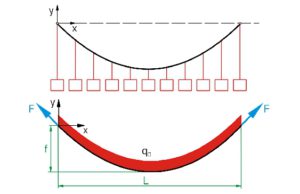
Depuis le début le temps, pour construire des ponts suspendus, l’homme a su utiliser les propriétés de la chaînette, notamment celle de repartir de façon égale sur chaque chainon l’effort à fournir.
Ce principe de répartition égale des tensions, et donc du poids sur l’ensemble des chaînons, fait que si nous déplaçons un petit bout de la chaînette avec notre doigt, la courbe de l’ensemble de la chaînette sera affectée et transformée. Il s’agit de l’expression du principe de moindre action développé par Nicolas de Cuse et Leibniz (****). Il dévoile une « harmonie préétablie » qui fait que n’importe quel évènement à un endroit donné affecte l’ensemble de l’univers, une réalité que la physique Newtonienne est incapable d’expliquer correctement.
Microcosme et macrocosme
-

Figure 18. Si sur une chaînette ACDB, nous relâchons A et B, alors CD reste la même chaînette qu’auparavant.
Le principe précédant fait que chaque bout de chaînette est lui-même une chaînette (Fig. 18), que le macrocosme se reflète dans le microcosme. Si sur une chaînette ACDB, nous relâchons A et B, alors CD reste la même chaînette qu’auparavant. Inversement, selon le même principe, la chaînette (entre ses points de suspension) est définie par n’importe quelles de ses parties, peu importe la taille. De la même façon que le grand se reflète dans le petit, le petit à son tour définit le grand (le microcosme définissant le macrocosme). Dans un sens, si l’on regarde différentes parties d’une chaînette, on regarde différentes expressions locales, d’une réalité globale, harmonieuse et équilibrée.
La sphericam angularem [sphère angulaire]
Avant de poursuivre sur la chaînette, il nous faut approfondir notre concept de surface autoportante. Impressionnée par sa visite du Panthéon, comme le commentaire d’Alberti le reflète, la première approche de Brunelleschi semble avoir été le concept d’une sphericam angularem – une sphère angulaire. Son idée consistait à transférer ou « projeter » les propriétés de solidité inhérente à la géométrie de la sphère sur les huit pans des calottes octogonales.
Ainsi, on pourrait presque dire que la coupole est composé non pas de deux calottes, mais de trois, la troisième étant ce qu’on pourrait appeler une « calotte sphérique imaginaire » (invisible) reliant les deux parois, par un anneau inscrit et circonscrit entre les deux calottes octogonales (Fig. 19).

Figure 19. La coupole semble composé non pas de deux calottes, mais de trois. La troisième étant ce qu’on pourrait appeler une « calotte sphérique imaginaire » (invisible) reliant les deux parois par un anneau inscrit et circonscrit entre les deux calottes octogonales.
Quelques années après l’achèvement du dôme, l’architecte Alberti, affirme que l’ « On peut lever des dômes angulaires sans cintrage si vous construisez une [coupole] parfaite (sphérique) à l’intérieur de l’épaisseur de votre ouvrage. Mais là, vous aurez une occasion particulière pour fixer des ligatures afin d’attacher les parties faibles extérieures aux parties fortes de l’intérieur. » (L’art d’édifier, Livre III, Chap. XIV)
Rowland Mainstone, un ingénieur des structures, explique que la calotte intérieure a été construite « comme s’il s’agissait d’une calotte sphérique… mais avec des parties coupées de l’intérieur et de l’extérieur pour respecter la forme octogonale. »
Brunelleschi tenait à l’élévation de cette sphère en hauteur « afin qu’elle sorte encore plus magnifique et dilatée (gonflante) ». Sa forme ne sera pas comme une calotte appuyée sur le corps d’une l’église, mais comme une structure de « crêtes et de voiles » qui se développe en extension et en hauteur.
L’architecte semble aussi vouloir reprendre ici tout un symbolisme traditionnel qui voyait l’action circulaire – expression de la perfection divine – allant à la rencontre de l’action rectiligne – expression de l’imperfection humaine. Nicolas de Cuse, reprenant les défis géométriques et mathématiques lancés par Archimède, creusera ce sujet dans son oeuvre La Quadrature du cercle .
Après tout, une église – maison de Dieu [domus deus] – , ne devait-elle pas être l’espace médiateur entre Dieu et l’homme ? La « sphère » divine, n’allait pas « nous abandonner ». Il devient ainsi clair que Brunelleschi et ses amis ont pu faire la synthèse et « monter sur les épaules » des meilleurs architectes de l’histoire de l’humanité.
Une membrane auto-portante en briques
Quand on monte les escaliers à l’intérieur du dôme, on constate que, sur plusieurs endroits, les motifs de la maçonnerie ont été volontairement laissés visibles (Fig. 20), tandis qu’ailleurs ils sont couverts de crépi. Puisque c’est Brunelleschi qui nous les montre, on a pu en conclure qu’il voulait nous laisser cette piste pour sonder son secret. Néanmoins, ne sous-estimons pas le caractère farceur et illusionniste du personnage, après tout inventeur de la perspective, cette science de l’illusion dont Platon se méfiait tant. Si vous ne voyez pas de l’extérieur les astuces de la construction, ce n’est pas par hasard. Tout Florence fut émerveillée par le dôme et les habitants se demandaient : « Comment est-ce que cela peut-il tenir debout ? Où sont les appuis et soutiens extérieurs ? »
Une analyse de la disposition des quelques 4 millions de briques, dont certains possèdent des formes spéciales (triangulaires, en angle, etc.) et qui sont cachées derrière les lignes droites des tuiles, nous révèle quatre nouveaux concepts importants.
1. Des contreforts invisibles
S’interdisant des contreforts à l’extérieur, Brunelleschi va élaborer tout un dispositif à l’intérieur des parois pour compenser cette absence. Comme spécifié dans son projet déposé aux Œuvres du Dôme (l’original a disparu mais a été copié à l’identique par Manetti) :
« On fera 24 contreforts [sproni], dont 8 dans les angles et 16 sur les pans ; […] ils devront assembler les deux voûtes et se rétrécir en proportion égale jusqu’en haut de l’ouverture fermée par la lanterne. Lesdits contreforts ainsi que lesdites coupoles seront ceints de 6 cercles [cerchi] de pierre solides, longues et renforcées de fer étamé [reliés avec des crampons] ; au-dessus de ces pierres, des chaînes de fer [catene di ferro, entourées de plomb pour empêcher l’oxydation] entoureront ladite voûte et ses contreforts. » (Fig. 21)
Après avoir spécifié les tailles de tout ces éléments et leurs emplacements exacts, il ajoute : « Mais le premier cercle sera renforcé par des pierres longues en travers, de façon que les deux voûtes de la coupole reposent sur ces pierres. Sur lesdites voûtes, toutes les 12 brasses environ, en hauteur, il y aura des petites voûtes en berceau [volticciuole a botti], d’un contrefort à l’autre, »
Ces « petites voûtes » permettent de renvoyer la pression des huit grands contreforts de façon égale vers les 16 autres et surtout de la repartir sur l’ensemble de la surface qui devient ainsi portante. Et il conclut : « sous ces petites voûtes, d’un contrefort à l’autre, il y aura de grosses chaînes de chêne [catena di quercia] pour assembler les dits contreforts et ceindre la coupole à l’intérieur, et sur ces bois une chaîne de fer [catena di ferro]. Les contreforts seront tous construits en pierre de taille et pierre résistante ; les pans de la coupole seront tous en pierre résistante et assemblés avec les contreforts jusqu’à hauteur de 24 brasses ; au-dessus on construira en brique ou en pierre ponce… »
Bien qu’utilisant les mêmes matériaux que le Panthéon, la réalisation de Brunelleschi se situe néanmoins dans la ligne de Neri di Fioravanti qui nous parlait de « cercler les douves d’un tonneau ». Faute de bois, croît-on, il n’existe dans le dôme qu’une seule chaîne [tirant] en châtaignier, assemblée avec des éléments de fixation en chêne. En réalité cette poutre entourant le dôme, se trouve exactement au point le plus instable de la courbe si elle est mise sous pression. Suite au tremblement de terre de 557 après JC, des tirants en bois furent incorporés dans les bases du dôme Sainte Sophie à Istanbul. Bien que plusieurs tremblements de terre (1510, 1675 et 1895) aient secoué Florence, le dôme a survécu sans problèmes majeurs, grâce à ce dispositif antisismique constitué par ces tirants en pierre solide, en bois et en métal.
Toutefois, pour Brunelleschi, son dôme n’était pas comparable à un tonneau, mais plutôt à un corps humain, fait « d’os et de chair ». Manetti rapportait qu’en étudiant les bâtiments romains, Brunelleschi avait « remarqué la façon de construire des anciens et leur emploi de la symétrie : il identifiait un ordre semblable aux os et à la chair, comme un homme illuminé par Dieu pour les grandes choses. »
Alberti pour sa part affirme que « En ce qui concernent les coupoles, peu importe de quel genre, nous devons imiter la nature, qui, quand elle attache les os, attache la chair avec des nerfs et mêle l’ensemble avec des ligatures et des tendons en longueur, en largeur et en cercles. C’est cette savante disposition qu’il faut imiter dans la construction des arches et coupoles » (L’art d’édifier, Livre III, Chap. XIV)
Les os sont ici les 24 contreforts (comme les côtes du thorax), tandis que les tendons sont en quelque sorte les chaînes. Un squelette équipé de tendons peut-il marcher ? Non, car il reste à définir le muscle qui tient le tout : les briques.
2. Les spirales en Spina Pesce [arêtes de poisson]
Le deuxième concept mobilisé par Brunelleschi sera la disposition des briques dite en spina pesce [arête de poisson], une technique héritée des Etrusques et développée au Trecento toscan. (Fig. 22)
-

Figure 22. La disposition des briques dite en spina pesca [arête de poisson], une technique héritée des Etrusques et développée au Trecento toscan.
L’arête de poisson se forme en alternant à intervalles réguliers la pose horizontale de brique avec une pose verticale. Ces intervalles réguliers sont grands en bas mais décroissent en montant pour disparaître au sommet. Ainsi se forment d’immenses spirales de briques traversant les pans et les contreforts du sommet vers le bas qui répartissant le poids sur la surface portante en expansion.
Ce procédé consiste à dévier le plus possible la poussée du sommet, qui se concentre en principe sur les angles du dôme, vers les « voiles » de la membrane. Une fois de plus, cette technique permet d’induire les propriétés d’une sphère, et notamment la solidité de sa membrane portante, sur les pans fragiles de la coupole octogonale. Avez vous déjà essayé d’écraser un oeuf avec vos deux doigts ? Difficile, sauf si on en casse la pointe sur une table. Peut-être Brunelleschi n’était-il pas si farceur que ça…
3. Le calibrage des briques
Les briques, en réalité d’immenses tuiles, sont orientées d’une façon radiale vers des « points glissants » sur un axe vertical situé au centre du dôme (Fig. 23).
-

Figure 23. Les briques, en réalité d’immenses tuiles, sont orientées d’une façon radiale vers des « points glissants » sur un axe vertical situé au centre du dôme
On pense également que les arêtes saillantes des briques verticales ont pu servir à une équipe chargée de guider les travaux grâce à des fils directeurs ou simbleaux. En vue de l’organisation des échafaudages nécessaires pour permettre aux maçons de se hisser eux-mêmes et les matériaux sur les hauteurs du chantier, on retient l’hypothèse que la coupole a été construite en « anneaux successifs » (Fig. 24).
-

Figure 24. L’on retient l’hypothèse que la coupole a été construite en « anneaux successifs »
Le tracé de la quinte pointée correspond avec l’inclination des briques au sommet qui est de 60 degrés. Si cette inclinaison vers l’intérieur des briques était exclusivement définie à partir d’un point unique au sol, les briques se seraient retrouvées dans une inclinaison proche de 90 degrés, situation fort inconfortable, aussi bien du point de vue structurel que celui du cintrage.
Comme on peut le démontrer sur une maquette, la rotation d’une ficelle d’une longueur donnée, accroché à un point immobile sur le sol du dôme, ne fait que tracer un ensemble de courbes géométriques évolutives – une hyperbole en bas, une parabole au centre et une ellipse en haut – sur les pans de la calotte, à l’instar de la coupe (parabolique) générée par un taille crayon (conique) aiguisant un crayon (hexagonal). On ne peut en aucune manière obtenir la courbe physique – non-algébrique – de la chaînette de cette façon, bien que Brunelleschi utilisa « une perche fixée à la base et tournant sur elle-même vers le haut avec réduction progressive de son inclinaison » pour construire la chapelle de Schiatta Ridolfi, elle, parfaitement sphérique.
4. La Corda da murare [cordeau du maçon]
Finalement, et c’est là que Brunelleschi nous démontre toute sa compréhension de la chaînette, nous devons étudier l’inclinaison en courbe de chaînette des lits de briques entre éperons. Cette inclinaison est parfois stupidement attribuée à l’inattention des ouvriers qui laissent fléchir leur cordeau de maçon, employé pour dresser les parements !

Figure 25. Depuis l’Egypte ancienne, comme dans les murs de l’enceinte d’El Kab, on sait que les lits de briques posées en chaînette font preuve d’une solidité incomparable.
Une fois de plus, depuis l’Egypte ancienne, comme dans les murs de l’enceinte d’El Kab (Fig. 25), on sait que les lits de briques posées en chaînette font preuve d’une solidité incomparable.
La question immédiate qui se pose ici est la suivante : pourquoi utiliser une chaînette orientée vers le bas, et non pas une chaînette inversée, orientée vers le haut, comme toutes les voûtes que nous venons de découvrir ? Eh bien, il semblerait que la chaînette est efficiente dans les deux directions : vers le haut et vers le bas ! Ainsi, les lits de briques en chaînettes créent une contrepoussée permettant de retenir les angles de la coupole, un peu comme le voilage en courbes négatives d’un parapluie qui retient les gaines. Une fois de plus, l’illusionniste Brunelleschi s’amuse à ébranler nos certitudes.
C’est uniquement cette utilisation complexe et scientifique des propriétés de la chaînette qui permirent Brunelleschi de réussir la construction du dôme. « L’harmonie du monde » qui existe entre chaque partie et l’ensemble donna cette qualité d’autosoutènement à l’édifice, tout en assurant sa solidité structurale. Chaque brique (microcosme) construit comme faisant partie d’une chaînette (expression de la moindre action), acquiert les propriétés de la chaînette, c’est-à-dire soutient un poids égal du dôme (macrocosme). A quatre millions de briques, on est plus fort que tous les contreforts de la place. Avec un minimum de matériaux, nous obtenons une surface maximale.
Une maquette (à l’échelle de 1 :5) de la taille d’une maison, construit récemment dans un parc de Florence (Fig. 26) par un architecte passionné, Massimo Ricci, permet de bien voir la maçonnerie en arêtes de poisson. (Fig. 27) Le professeur Ricci, pour sa part, ne croit guère à la chaînette sur laquelle il a peu réfléchi pour l’instant. Il pense qu’il suffit de construire quelques éléments de guidage déduits des courbes d’ellipses d’une forme de fleur, symbole de Santa Maria del Fiore.
Rappelons que même Brunelleschi sera rappelé brutalement à l’ordre par… la chaînette car, pendant l’été 1429, des fissures apparaissent sur les murs latéraux de la partie orientale de la nef. Au lieu de construire des contreforts, Brunelleschi en profite pour imposer le plan d’origine de Neri. Les absides autour de la nef formeront ce qu’il appelait une catena totius ecclesie (une chaîne autour de l’église), capable d’absorber la poussée.
La découverte de l’Amérique
-

Figure 28. La Pinta, une des trois caravelles de Christophe Colomb.
Brunelleschi : perspective linéaire et sphericum angularem , science des coupoles ; Nicolas de Cuse :La Quadrature du Cercle ; le peintre flamand Van Eyck : peinture et un « mappemonde » ; son maître Roger Campin peint des « sorcières », miroirs sphériques ; le miniaturiste Jean Fouquet : la perspective sphérique ; Toscanelli, l’astronomie, la perspective et la cartographie. Si on regarde les domaines divers sur lesquelles ces scientifiques travaillaient, on constate que finalement ils se préoccupaient tous d’un même sujet : la topologie « non linéaire ».
En effet, perspective, optique, cartographie, et les problèmes d’architecture à laquelle était confronté Brunelleschi s’unissent dans une même question : comment les propriétés d’une sphère peuvent-elles se projeter sur un plan ? Et il y avait cette liberté d’esprit, que l’on appelle aujourd’hui pompeusement « la recherche pluridisciplinaire décloisonnée » qui faisait que tout progrès dans un de ces domaines amenait un progrès dans l’autre.
Toscanelli ne souffrait point de ce genre de frustrations. Ross King écrit dans son livre récent « Brunelleschi’s Dome », qu’en 1475, âgé de 78 ans et avec l’accord de l’Oeuvre du Dôme, Toscanelli aurait monté les 463 marches pour installer au sommet du dôme une plaque en bronze, pourvue de petits trous. Grâce àune jauge spéciale sur le sol, un gnomon, Toscanelli fit du dôme le plus grand cadran solaire du monde de cette époque ! Ces observations, destinées officiellement à connaître la date exacte de Pâques, lui permettront de corriger toutes les observations précédentes concernant les équinoxes et les solstices. (Fig. 29)
Or, pour voyager en haute mer avant l’apparition du quadrant et du sextant, on utilisait essentiellement la boussole et l’astrolabe pour mesurer l’angle entre l’horizon et l’étoile polaire. Néanmoins, ces observations ne trouvaient une utilité pratique que grâce à la correction obtenue au moyen des tables d’éphémérides nautiques, en particulier les tables Alphonsines établies en Andalousie sous Alphonse X (le sage) par des astronomes arabes dirigés par le juif Isaac Ben Sid en 1252. Toscanelli correspondait avec Regiomontanus (Johann Müller) de Nuremberg (1436-1476), qui, avec son précepteur, le mathématicien autrichien et ami de Cuse, Georg Peurbach (1423-1461), établiront des nouvelles tables d’éphémérides pour la période de 1475 à 1506. Un élève de Regiomontanus, Martin Behaim (1459-1507) sera le conseiller du roi Jean II du Portugal à Lisbonne, où il a pu croiser Christophe Colomb. Behaim travaillera beaucoup sur les latitudes en mer et fabriquera des astrolabes en cuivre, plus précis que ceux en bois. Le plus ancien globe terrestre que nous connaissons, qui date de 1492, est de sa fabrication.
Ainsi, on peut dire que les observations que Toscanelli effectua sur le toit du dôme de Florence, ont permis l’éclosion d’une nouvelle science. Au-delà de la navigation côtière, renaissait la navigation astronomique. (Fig. 30)
Déjà, dès 1419, année de la découverte de Madère, Henri le Navigateur avait fondé un centre de recherche maritime à Sagres au service des explorateurs portugais. Après la chute de Constantinople en mai 1453, la route de la soie et des épices était fermée en Orient, et l’on chercha des routes passant par le sud en contournant l’Afrique. Mais surtout, Toscanelli avait recueilli les récits de nombreux voyageurs d’extrême orient. En particulier, il a eu un long entretien avec l’ambassadeur du « Cathay » (la Chine). Comme le rapporte Toscanelli lui-même : « A l’époque du Pape Eugène IV [l’époque du Concile de Florence, 1438], un ambassadeur est venu vers lui pour lui exprimer les grands sentiments d’amitié pour les Chrétiens, et j’ai eu une longue conversation avec l’ambassadeur sur beaucoup de questions. »
Le 25 juin 1474, Toscanelli envoie sa fameuse lettre avec une carte, à un ami à Lisbonne, le chanoine Fernan Martinez de Roriz qu’il avait rencontré lors du concile à Florence. Martinez figure d’ailleurs avec Toscanelli dans le dialogue scientifique de Nicolas de Cuse La quadrature du Cercle.
Dans cette lettre, Toscanelli lui assurait que le chemin le plus court pour voyager vers le Cathay, à l’est, passait par l’ouest. Martinez, confesseur du roi du Portugal ne réussit pas à convaincre son souverain, mais quelqu’un de sa famille, un jeune capitaine de bateau génois, Christophe Colomb, lequel avait vu passer la lettre et allait écrire à Toscanelli vers 1480. Bien que le vaillant Colomb prétendit ne jamais avoir eu recours à des mathématiques ou une carte, dans ses bagages se trouvait une carte de Toscanelli et très probablement les tables d’éphémérides obtenues grâce au cadran solaire du dôme.(Fig. 31)
Au-delà de la découverte de l’Amérique, la navigation astronomique deviendra une science capable d’en découvrir des milliers. Ainsi le chantier du dôme ne se limitait pas à 37 000 tonnes de briques ou à un simple objet de contemplation esthétique, mais son « âme immortelle » provoqua une vague de révolutions scientifiques de par la planète dont chacun pourra encore bénéficier demain.
- A partir des courbes de moindre action, on peut aussi identifier des surfaces et des volumes de moindre action (« surfaces optimales »), très répandu dans la nature. L’expérience la plus simple permettant de les découvrir sont les bulles de savon. On y découvre la courbe chaînette quand on trempe deux anneaux parallèles en fil de fer dans de l’eau savonnée. (Fig. 32)

Figure 32. Bulle de savon formant un « volume optimal » de type caténoïde (une chaînette en révolution).
Elles forment un « volume optimal » de type caténoïde (une chaînette en révolution). Voir aussi Figure 16.
Quand on y trempe une armature reprenant la géométrie du dôme, des surfaces optimales apparaissent sur les pans, c’est-à-dire des surfaces de courbure « négative » (concaves), une géométrie semblable à celle du parapluie, et identique au léger évasement des pans de la coupole, caché derrière les tuiles.
(Fig. 33)
On peut même faire apparaître la « double calotte » du dôme qui se forme à l’instar du petit cube en eau savonneux qui se forme à l’intérieur d’une structure cubique. Tout ceci tend à nous convaincre que Brunelleschi a conçu l’ensemble de la coupole à partir d’un concept unique de volume optimal fondé sur le principe de moindre action, intensément débattus à l’époque dans son entourage immédiat (Cuse, Toscanelli, etc.).
Lyndon LaRouche, remarque qu’ : « Il est assez troublant de découvrir que le principe de la chaînette fut employé aussi tôt (début du quinzième siècle), pas seulement comme une forme, mais comme un principe physique de courbure capable de résoudre le problème autrement insolvable de la construction. » (« On The Issue of Mind Set », EIR, 3 Mars, 2000)
Notes:
- *Guillaume Dufay est probablement né le 5 août 1397 à Beersel près de Bruxelles, sinon à Cambrai où il mourra en 1474. De 1428 à 1437 il est attaché à la chapelle pontificale, à Rome, Florence et Bologne.
- Il donna un nouveau souffle à une technique ancienne, le motet isorythmique. Selon David Fallows, le Nuper rosarum flores est construit « sur deux voix inférieures exposées quatre fois à des vitesses différentes et selon des longueurs proportionnelles : 6 :4 :2 :3 – ce qui correspond aux proportions de la nef, de la croisée, de l’abside et de la hauteur de la coupole de la cathédrale. Le fait que ces deux voix utilisent la même mélodie -l’Introït pour la dédicace d’une église- à deux niveaux de tonalité et avec des rythmes s’interpénétrant, symbolise l’exploit architectural de Brunelleschi : une calotte intérieure encastrée sur une calotte supérieure. Ainsi, de la même façon que nous sommes séduit par la beauté des formes extérieures du dôme, l’effet musical du motet parvient à son effet musical maximum dans les lignes des voies supérieures. »
** Paolo Toscanelli fut sans doute le plus grand scientifique polyvalent de son temps conduisant des recherches dans tous les domaines importants : mathématiques, géométrie, perspective, cosmologie, médecine, astronomie et surtout la géographie appliquée à la cartographie.
Il écrit un traité sur la perspective en 1420 Della Prospectiva , malheureusement perdu, probablement avec l’aide de Brunelleschi qui selon Manetti faisait ses fameuses expériences à la même époque.Il suivit avec Nicolas de Cuse les cours du mathématicien Prosdocimo del Beldomandi à Padoue.
Avant publication, Cues lui envoie le manuscrit de sa première oeuvre mathématique, les Transmutations géométriques de 1445, puis ses Compléments arithmétiques en 1450. Toscanelli fut souvent appelé « Paolo le médecin », parce qu’il couronna ses études avec un doctorat de médecine tandis que Cuse obtenait le titre de doctor decretorum .
Il devient ensuite conservateur de la bibliothèque de Niccolo Niccoli à Florence. Celui-ci fut un des plus ardents collectionneurs de manuscrits de la Renaissance italienne, dont la collection sera le fonds de départ de la fameuse bibliothèque Laurentienne pour devenir le cœur de la bibliothèque Vaticane. Toscanelli sera aussi un ami direct et l’inspirateur du jeune Léonard de Vinci, et c’est à Toscanelli que son ami Nicolas de Cuse dicte ses dernières volontés sur son lit de mort
- *** C’est Ambrogio Traversari, grand protecteur du peintre Piero della Francesca, que recruta Nicolas de Cuse pour organiser avec lui le grand concile oecuménique qui aura finalement lieu à Florence en 1438 pour tenter de sceller la réunification des églises d’Orient et d’Occident.
- Ils imposeront les plus grands papes humanistes de la Renaissance, Martin V, Eugène IV, Nicolas V et Pie II. Réunir Orient et Occident sous un dôme unique, grand et beau, capable d’englober toutes les coupoles de la chrétienté était un puissant symbole et on mesure derrière ce projet tout l’engagement actif d’une myriade d’humanistes.
- On y réfléchit sur la quadrature du cercle, on apprend le grec et l’hébreu pour percer les secrets des écritures, on traduit Archimède, Végèce et Vitruve pour inventer des machines plus performantes, on démarre l’industrie, on produit du papier pour lancer l’imprimerie, on fonde des hôpitaux et des écoles, bref on ne fait pas que parler de Renaissance, on la fait.
****Pierre de Fermat. La courbe de la chaînette, en opposition avec les courbes algébriques, appartient au domaine des courbes physiques, et exprime le principe de moindre action.
Ce principe baptisé « principe d’économie naturelle » par Pierre Fermat (1601-1665), le chemin emprunté par la lumière pour se rendre d’un point donné à un autre est celui pour lequel le temps de parcours est minimum (« principe de Fermat »).
Leibniz (1646-1716), reprenant le principe du minimum/maximum, que Nicolas de Cuse avait déjà identifié en travaillant sur l’isopérimetrie, le formule ainsi : « Il y a toujours dans les choses, un principe de détermination, qu’il faut tirer de la considération d’un maximum et d’un minimum, à savoir que le maximum d’effet soit fourni avec un minimum de dépense. Dans le cas actuel, le temps et le lieu ou, en un mot, la réceptivité ou capacité du monde peut être considérée comme la dépense, c’est-à-dire le terrain sur lequel il s’agit de construire le plus avantageusement, et les variétés des formes dans le monde correspondent à la commodité de l’édifice, à la multitude et à la beauté des chambres…(…)…Ainsi un liquide placé dans un autre, hétérogène, prend la forme qui a le maximum de capacité, à savoir la forme sphérique. Ainsi encore en mécanique ordinaire, de l’action de plusieurs graves concourant entre eux [une chaîne] résulte le mouvement par lequel en fin de compte se réalise la plus grande descente. Et de même que tout les possibles tendent d’un droit égal à exister, en proportion de leur réalité, ainsi tout les poids tendent aussi d’un droit égal à descendre, en proportion de leur gravité ; de même qu’ici se produit le mouvement dans lequel se remarque le maximum de descente de graves, de même le monde qui se réalise est celui qui réalise le maximum de possibles. » ( De la production originelle des choses prise à sa racine ).
En 1691, Leibniz note que Galilée confondait la chaînette avec la parabole, une différence fondamentale démontrée par Joachim Jungius (1585-1657).
Bibliographie :
- Choisy, Auguste : Histoire de l’Architecture ; Bibliothèque de l’image, 1899.
- Chalifoux, Benoît : Réflexions sur le dôme de Brunelleschi, papier de recherche, 2003.
- Director, Bruce : The long life of the Catenary : from Brunelleschi to LaRouche, Fidelio, Summer/Fall 2002.
- Fitchen, John : The Construction of Gothic Cathedrals, University of Chicago Press, 1961.
- Gärtner, Peter : Brunelleschi, Könemann, Cologne, 1998.
- Hammerman, Nora and Rossi, Claudio : The Apollo project of the Golden Renaissance, Brunelleschi’s dome, 21st Century, July-August 1989.
- King, Ross : Brunelleschi’s Dome, Pimlico, Random, Londres, 2003.
- Leibniz, G.W., Opuscules philosophiques choisis, Vrin, Paris 1978.
- McLean, Alick : « L’architecture des débuts de la Renaissance à Florence », dans La Renaissance italienne, Editions de la Martinière/Könemann, Cologne, 1995.
- Mainstone, Rowland J. : Developments in structural form ; MIT press, Cambridge, Mass., 1975.
- Manetti, Antonio : « Vie, fortune et oeuvre de Filippo Brunelleschi », dans Brunelleschi, Ecole Nationale des Beaux Arts, Paris, 1985.
- Marchini, Giuseppe : Le Baptistère et le dôme de Florence, Beccocci , Florence, 1972.
- Matteoli, Lorenzo : Ser Filippo Brunelleschi and the Dome, Nov. 10th, 2002, Internet.
- Murray, Peter : L’architecture de la Renaissance italienne, Thames & Hudson, Londres, 1969.
- Prager, Franck D. and Gustina Scaglia : Brunelleschi, Studies of his technology and inventions, M.I.T., Cambridge Mass., 1970.
- Scarre, Chris : Monuments du monde ancien, Hazan, Paris, 2000.
- Tennenbaum, Jonathan, « How Gauss Determined The Orbit of Ceres », ch.4, Fidelio, Summer 1998.
- Vasari, Georgio : La Vie des Grandes Artistes, Club du Livre, Paris, 1954.






